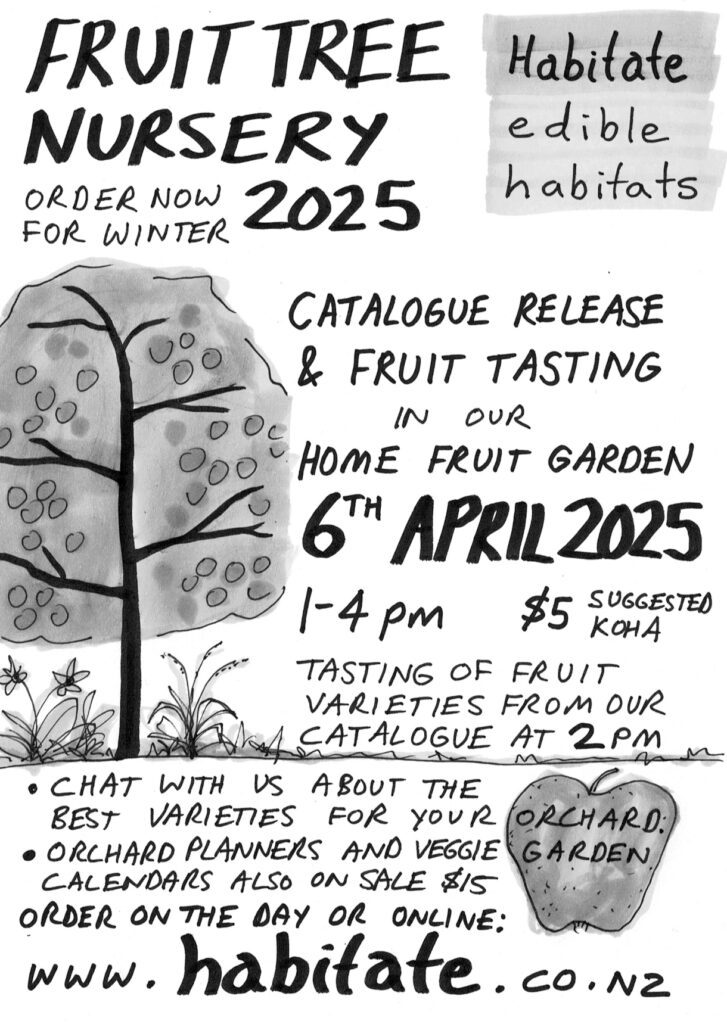
It will be great to see you there! Our garden is full of interesting things this year, come and have a look and a yarn!
Friday, March 14th, 2025

It will be great to see you there! Our garden is full of interesting things this year, come and have a look and a yarn!
Sunday, March 3rd, 2024
Each year we really look forward to our Nursery fruit tasting day where we invite you to try a great range of in season fruit from our nursery.
We often have 20-30 varieties of fruit on display, not all of them will be ripe for tasting but you will get a good idea from this of what you might like to plant in your backyard!
Location: 6 Mclachlan st, Waitati.
This is our home garden where we grow a large proportion of our own food using permaculture principles to integrate chickens, a poly tunnel, worm farming etc
$5 entry per person
Our vegetable growing calendar and orchard planner publications will be for sale at the tasting sessions these are $15 each. Cash on the day please.
Be quick to get a 2024 Habitate Nursery order form and discuss your order with us after the tasting session, early orders are coming in and some plants are selling out already.
Or go directly to our online order form to order today:
https://www.habitate.co.nz/heritage-fruits-nursery/
Children welcome if supervised
No Dogs.
Outdoor event, please dress warmly.
Bring your own travel cup for herb tea.
Email any questions to jason@habitate.co.nz
I look forward to seeing you there!
Regards Jason
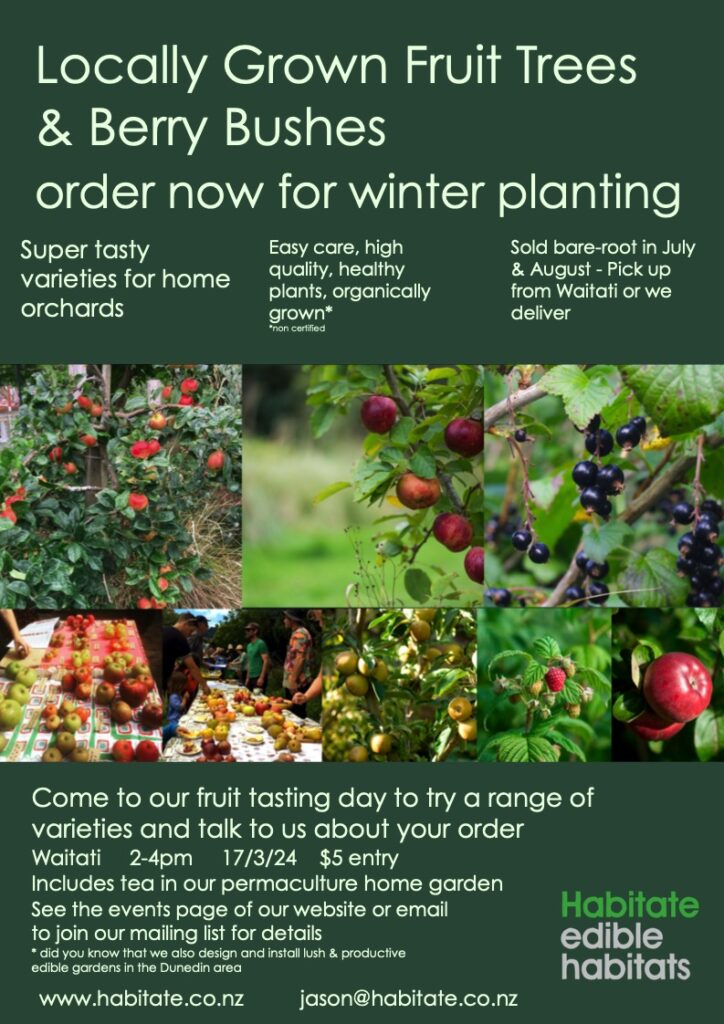
Saturday, March 4th, 2023
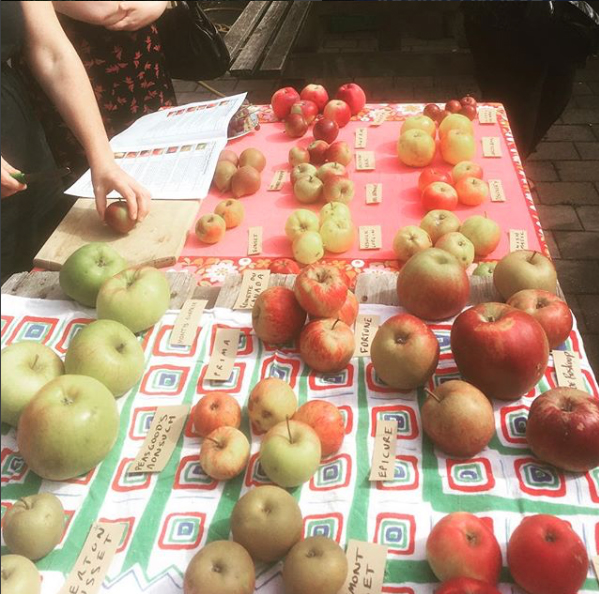
Kia ora!
I hope that you can join us in Waitati for one or more of our 2023 winter nursery catalogue promotion events:
Our publications will be for sale at the tasting sessions these are $15 each. Cash only.
If you are attending both the nursery tour and the first tasting session you are welcome to picnic in our back yard.
Prior booking essential, bookings at Humanitix:
https://events.humanitix.com/habitate-nursery-2023-nursery-tour-and-fruit-tasting-sessions
Location in Waitati will be emailed after booking.
Children welcome if supervised by a ticket holder.
No Dogs.
Outdoor event, please dress warmly.
Bring your own travel cup for herb tea at the tasting sessions.
Email any questions to jason@habitate.co.nz
I look forward to seeing you there!
Regards Jason
Monday, April 20th, 2020
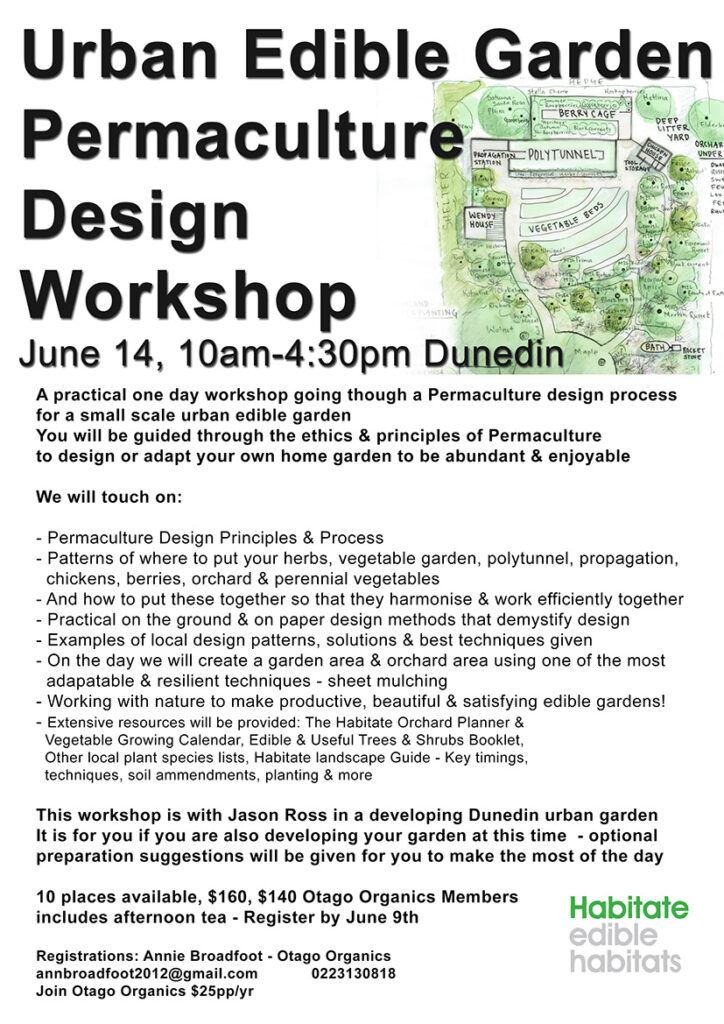
This workshop was run in 2020, let us know if you would be interested in attending a future workshop.
Wednesday, March 4th, 2020
I look forward to seeing you at one or all of our events: Nursery & home garden tour, fruit tasting, nursery catalogue & orchard planner release. No-dig vegetable growing & orchard planning workshops
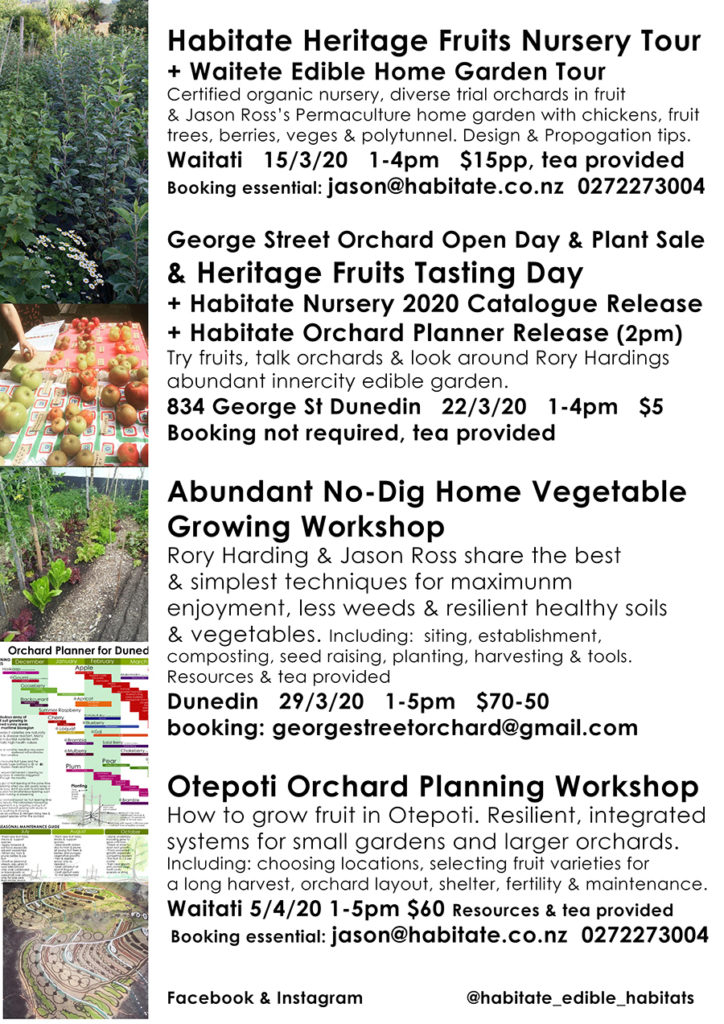
Monday, November 11th, 2019
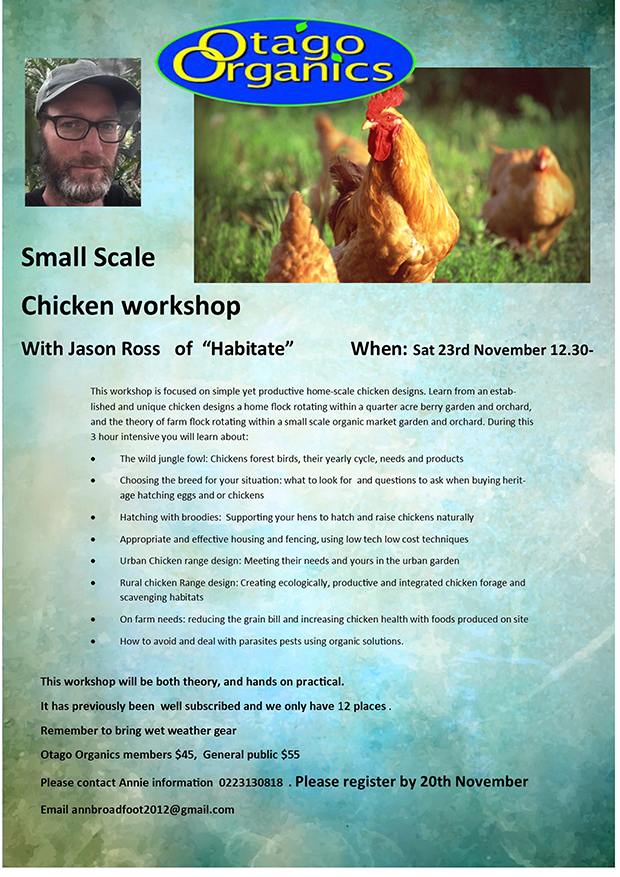
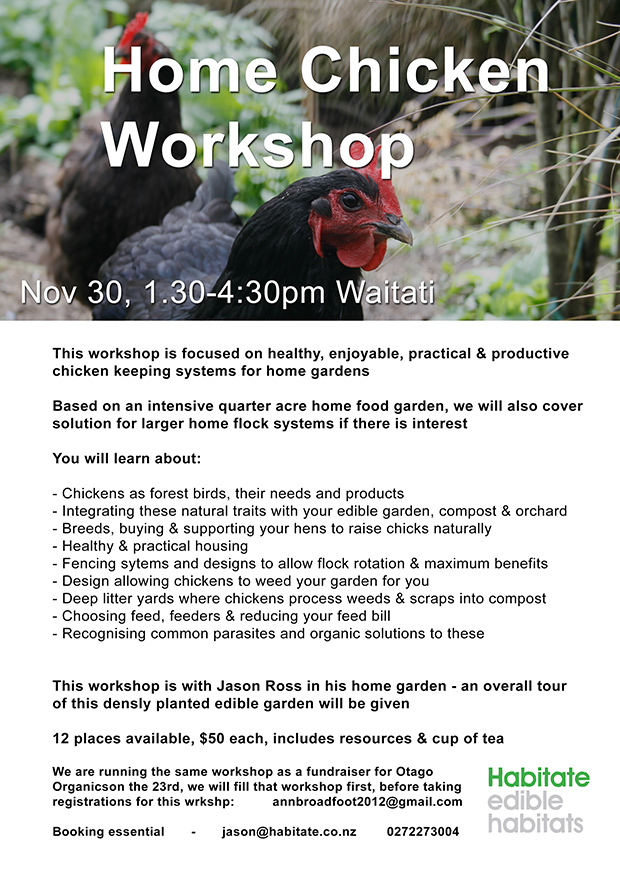
Wednesday, May 1st, 2019
Kia ora!
Tour of our Certified Organic Heritage Fruits Nursery & our Quarter Acre Home Garden: Sunday 5th May 10:30am – Noon $5
See how we grow our plants, see our trail orchards and diverse home vegetable and fruit garden with integrated chickens, perennial vegetables and grassland perennials.
Get inspired, ask questions, enjoy fruit tasting and a cup of tea. Limited spaces, booking required: Email jason@habitate.co.nz
Another way to catch up with us is at The 2019 Harvest Celebration at the Otago Farmers Market on the 11th May. We will be there with apples to try, our catalogues and publications.
We still have a fantastic selection of apples on three rootstocks, Beurre Hardy Pears, berries and comfrey for sale this winter. Some of you were also looking for Monty’s Surprise apple trees, I’m letting you know first, we have them available this winter. We also have Seedling Hazelnut Trees for sale, great for nuts/shelter/coppice.
Follow us & see what we are up to on Instagram or Facebook (same content as our Instagram).
See you soon! Jason
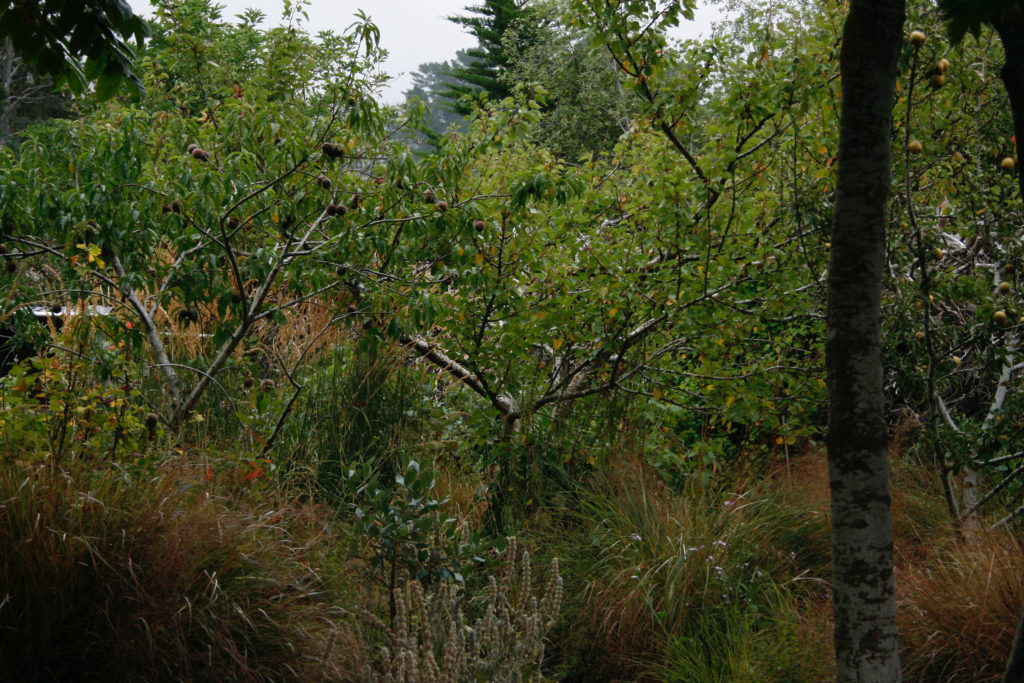
Thursday, March 14th, 2019
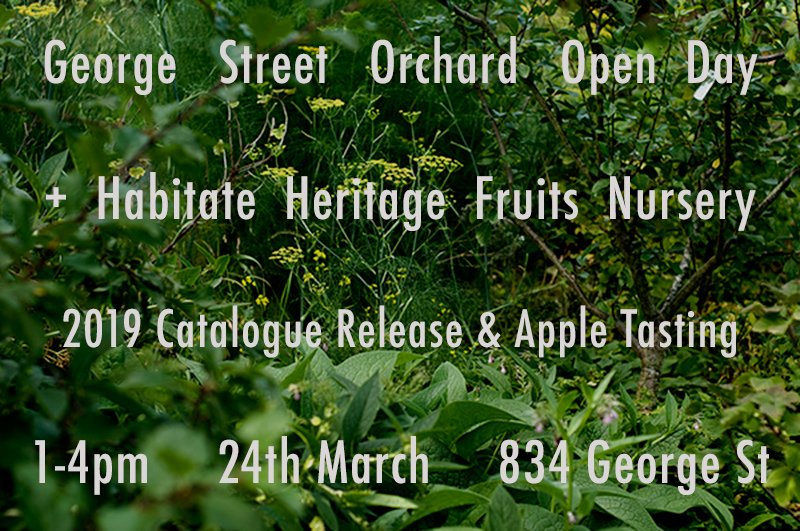 This year we stoked to be releasing our 2019 Fruits Nursery Catalogue and holding our Apple Tasting at the Open Day of George Street Orchard, Rory’s abundant & diverse innercity fruit garden.
This year we stoked to be releasing our 2019 Fruits Nursery Catalogue and holding our Apple Tasting at the Open Day of George Street Orchard, Rory’s abundant & diverse innercity fruit garden.
Taste a huge selection of delicious apples and chat with us about the best fruit trees and berries to plant in your garden this winter.
This is a great chance to look around George Street Orchard and see how fruit trees, bushes and vines can be creatively fitted into a very small innercity section.
Rory will also have a great range of potted plants for sale on the day:
Grapes, Figs, Aronia berries, Goumi berries, Monkey puzzle nut trees, Chestnuts, Asparagus & Echinacea.
We are likely to do a tour of Habitate Nursery in April as part of Organic Week, email to get on our mailing list so that you get tipped off.
“George Street Orchard is in the tenth year of becoming a resilient, diverse and delicious garden. Our aim is to grow many of the foods we like to eat in a way which captures atmospheric carbon, builds soil, increases biodiversity and blurs the distinction between ornamental and utilitarian. To these ends, we emphasise perennial and self-seeding annual plants and mimic and encourage natural patterns.
The garden is structured to accommodate approximately thirty species of fruiting trees, shrubs and vines – some well known and proven in this region, others experimental, but all selected for being viable in, if not perfectly suited to our unique climate. Vegetables, herbs, medicinal plants, chickens and mushrooms are coordinated and shuffled within.
We host tours and workshops to discuss and demonstrate the design and techniques we have found to be successful, hopefully inspiring action for flourishing edible environments in the city and beyond.” https://georgestreetorchard.com
Monday, November 19th, 2018
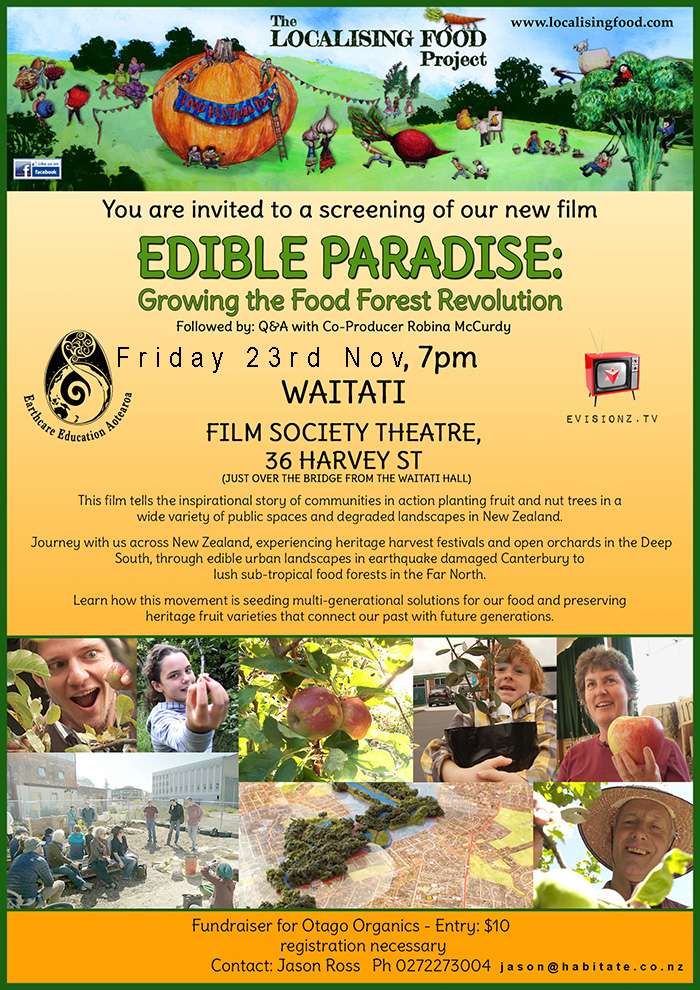
Edible Paradise Film Screening
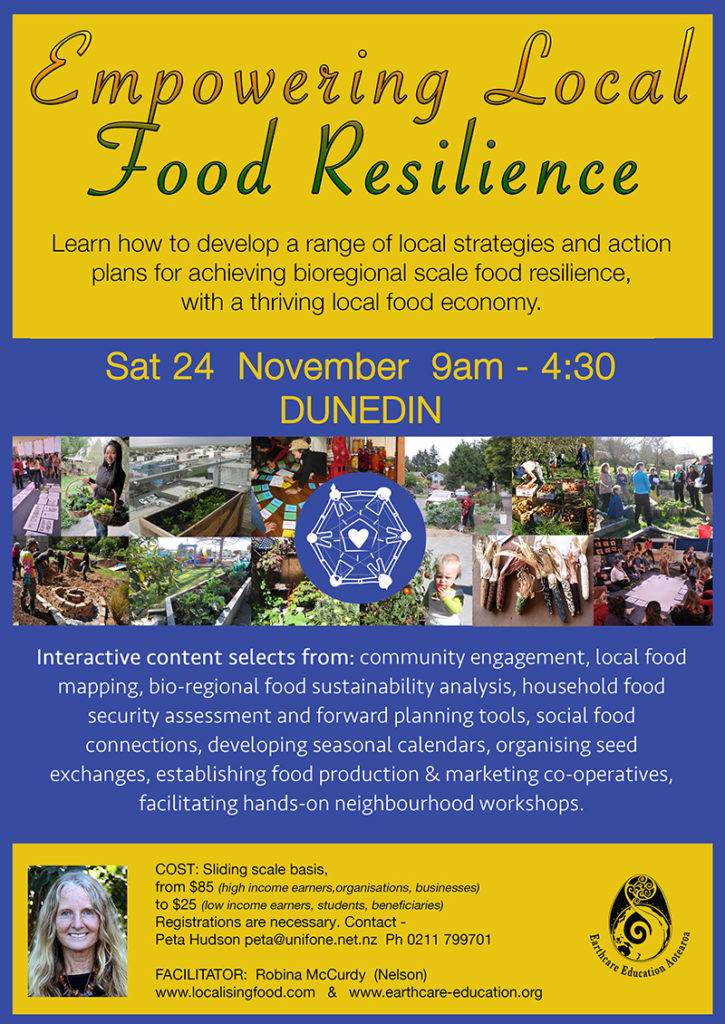
Empowering Local Food Resilience
Sunday, August 26th, 2018
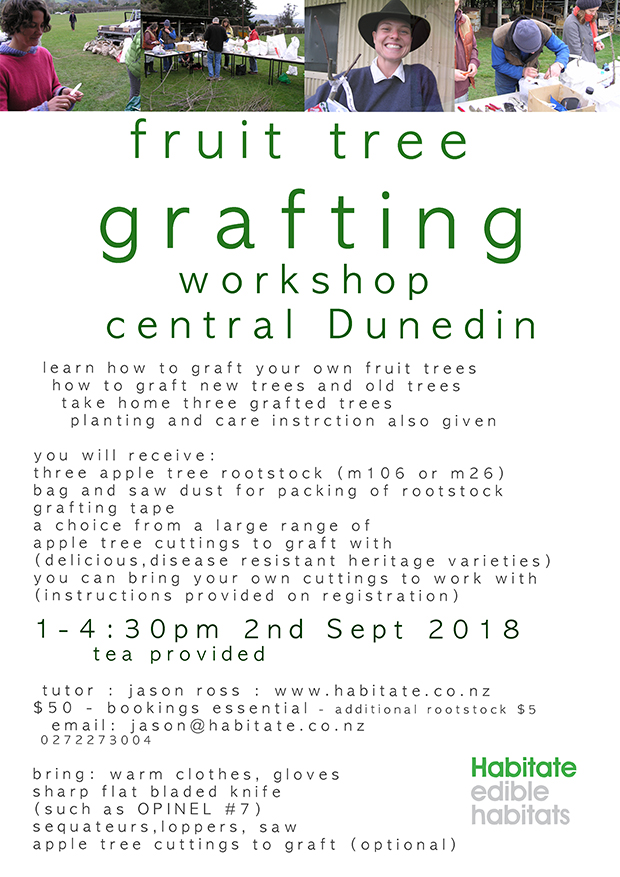 fruit tree grafting workshop central Dunedin
fruit tree grafting workshop central Dunedin
learn how to graft your own fruit trees
how to graft new trees and old trees
take home three grafted trees planting and care instrction also given
you will receive: three apple tree rootstock (m106 or m26) bag and saw dust for packing of rootstock, grafting tape, a choice from a large range of apple tree cuttings to graft with (delicious,disease resistant heritage varieties)
you can bring your own cuttings to work with (instructions provided on registration) 1-4:30pm 2nd Sept 2018
tea provided
tutor : jason ross : www.habitate.co.nz
$50 – bookings essential – additional rootstock $5 email: jason@habitate.co.nz 0272273004
bring: warm clothes, gloves sharp flat bladed knife (such as OPINEL #7) sequateurs,loppers, saw apple tree cuttings to graft (optional)
Wednesday, March 21st, 2018
 I was contacted by Debby Luquette, a Master Gardener with the Pennsylvania Extension Service in the USA, for permission to use my photos for the introductory talk on edible forest gardens reproduced below (Click the link for slides).
I was contacted by Debby Luquette, a Master Gardener with the Pennsylvania Extension Service in the USA, for permission to use my photos for the introductory talk on edible forest gardens reproduced below (Click the link for slides).
It is interesting that she places forest gardening in the context of North American wild plants.
Forest Gardening Debby Luquette HGE March2018 SLIDES (LARGE FILE)
Edible Forest Gardening – Home Garden Essentials, 2018
Imagine this is the spring of 1491. Imagine what this landscape would look like. Imagine the plants would be here.
Are you thinking that most of the land would be covered in trees? What kind of trees? By some estimates, 40% would be chestnuts, the tall, straight American chestnuts, not the Chinese variety, which has a shorter, more sprawling habit. There would be a lot of oaks, too. Here and there a persimmon would find its way to the canopy. Along the banks of streams, pawpaws would be reaching for light at the edge of the forest. West of here, blueberries would occupy the drier, rockier soils of the mountains. Animals took advantage of the bounty of food available- deer, turkeys, grouse, bears, squirrels and many other creatures.
This may be familiar to us as the assortment of food that the Native Americans contributed to the first Thanksgiving, along with corn, squash, beans and a few other cultivated annual plants. What would that tell us about how the Native Americans sustained themselves before European agricultural practices changed the landscape? In fact, environmental anthropologists speculate that the Indians actually cultivated the forest garden using techniques such as slash-and-burn, cutting openings in the canopy to encourage regeneration of plants they used for food, fiber and medicine.
Today there are people who are studying the benefits of this type of forest gardening, and beginning to establish these gardens themselves. The purpose of a forest garden is implied in the landscape of 1491.The forest is maintained to grow food, medicines and other useful products. But the scale of a suburban backyard is a lot different, and consequently, because of the size constraint, it requires that such a garden should be thoroughly planned. A small, homestead forest garden can even be grown on less than an acre of land. Obviously, we won’t grow a ‘forest’ on less than an acre, but we can bring together elements of a forest that fit the available space and the desired food plants. There won’t be room for too many trees, but there will be room for shrubs and perennials.
To figure out how this could be accomplished we need to look at the form and function of a forest. Since the colonial days after most of the original forest in eastern North America has disappeared, a forest develops on a piece of land that is disturbed, generally by farming, and left to grow back. It goes through a process ecologists call succession, a process taking several stages and a few decades. The forest is the last stage of succession, when mature trees occupy as many spaces as they can. This creates shade that makes it difficult for plants that are not shade tolerant to thrive. The shade tolerant subcanopy and shrubs, fill in spaces between trees. Groundcover, mostly ferns and perennial herbs, occupy the remaining space. This forest remains, regenerating itself unless some disturbance opens a gap. In the post disturbance gaps, fast growing opportunistic trees and shrubs get a chance to grow for awhile, before the forest canopy closes in again. This is what we try to recreate in the forest garden.
As one type of vegetation replaces another through the successional process, soil and water dynamics are also changing. In a forest, organic matter and a network of living roots holds soil and retains water. Soil microflora – nematodes, fungi and bacteria – decompose complex organic matter and help distribute it, making it available to tree roots. Undisturbed forest soil has been drastically altered by agricultural practices, not only removing the water retention ability of the soil, but also disrupting healthy communities of microflora. Organic matter has largely disappeared from the soil, leaving no food for the soil microflora. The natural process of ecological succession restores much of the soil health.
Forest gardens generally aim at maintaining a post disturbance dynamic, where the fast-growing, sun-loving opportunistic species of food plants grow alongside a stand of slow-growing, mature forest trees. Building and maintaining a forest garden restores much of the water retention ability and soil microorganisms. But instead of leaving the community of plants that develops to chance, growing from seeds that find their way to the plot of land, the forest gardener deliberately chooses the desirable trees, shrubs and perennials and their placement. He or she then encourages their growth by removing the unwanted species – weeds – that are also trying to take advantage of a disturbed spot. Re-shaping the land with swales and patiently nurturing desired plants with mulches, first from an outside source and eventually from the garden itself, develops water holding capacity and a healthy soil microflora.
Have you heard the term ‘permaculture’ before? The word is shortened from permanent culture, that is, cultivating an area with perennials. It becomes is a system of decision making with the goal of building healthy soil, and a healthy ecosystem. Once an area is planted in perennials, there is minimal disturbance, so the initial planting should be well designed, choosing plants that complement each other in their function and form. Edible Forest Gardening is the epitome of this concept, In fact, it is the most practical form of permaculture for the Eastern US, where a forest is the vegetation form that occur without human interference.
When the garden we want is designed such that all the open areas between larger plants are filled with shrubs and perennial ground covers – many of them edible – weeds are less of an issue and maintenance is easier. Since weeds are plants that colonize a space when a niche appears (that is, a space suitable to their growth becomes available), weeding will need to be done, especially in the years it takes for desired plants to completely fill in open ground. One recommendation for maintaining an established garden I have seen more than once is that the gardener should always have a desirable plant ready to place into any open space that occurs.
In an edible forest garden, it’s easy to think that the main plants will be trees, and we select them for their use, usually that will be giving us fruit or nuts. Beneath the tree canopy, there is a subcanopy, trees of shorter stature that can tolerate shade well. These are going to be partial shade and shade lovers, pawpaws for example. In a backyard forest garden, these can be the main features, as semidwarf fruits and pawpaws.
Next smallest plants are the multi-stemmed, vigorous shrubs, which might include plants such as hazelnuts and high bush blueberries. Vines can climb the taller plants, adding more productivity. Then closer to the ‘edge,’ where there is more sunlight, we can find place for some brambles and other small fruits. Then there is the ground cover, annuals and perennials. These can be food plants, but also herbs. Annuals can be used, but somehow they will need annual replacing, whether we put in partially grown plants or they are self-seeding.
Some forest gardeners grow plants referred to as dynamic accumulators, like comfrey, which have long tap roots that draw nutrients from deep in the soil to the vegetation above the soil. They can be periodically cut to use as high nutrient, ‘chop-and-drop’ mulch. And we absolutely need to include plants used to attract and feed beneficial insects – pollinators and predatory insects which parasitize pest species. These can be have a dual purpose as herbs and nutrient accumulators, too.
What would a forest garden look like on a small plot of land? Probably a lot like a patch of forest. I’ve seen this type of gardening referred to as edible landscaping, a form of ‘permaculture,’ where home landscaping takes on an edible focus. The goal is to plant one’s yard with plants that will not be harvested, ripped out and replanted again the next year. But there is also a place for putting nice looking annual vegetables – multi-colored lettuces, peppers, kale, or zucchini – between the perennials.
The easiest way to start an edible forest garden is with one or two patches, sometimes called guilds. Usually one larger woody plant, situated in a small plot or patch and that become the center of the focus, the centerpiece of the patch. Shrubs and perennials will fill in around it. Perennial vegetables and flowers that attract beneficial insects form the outside perimeter of the patch. The patch eventually takes on a self-sustaining form with healthy soil, good water use and retention, a community of insects you want to control the ones you don’t, no room for weeds, low maintenance, and best of all – Food! In some schemes, there are areas that will support annuals that are rotated between patches. These patches contain the plants selected to complement each other, not just in function, but in how they can nurture each other. Think about nitrogen fixing legumes as these companion plants. One patch can be placed in a damp area and another in a drier area, each with plants that are better suited for the different soil types in each patch.
Animals are included in any complete ecosystem. I’ve already mentioned insects, which can serve as pollinators. here are some insects that serve as both pollinators and predators of unwanted insects, as well as parasitoids. Toads can be helpful residents of the garden as well. Chickens are also welcome. However, from the time I started learning about forest gardening, with their wonderful descriptions of various food plants, growing in profusion, one in amongst others, my reaction was that I would be building a deer smorgasbord. For them, we have an electric fence. Rabbits, voles and other small animals would support populations of foxes, hawks and owls, if we could be lucky enough to have them living nearby. Otherwise you need to fence them out, as well. There would be fructivorous birds who would appreciate our efforts, and nets over the berries and orchard fruits are the only solution to these hungry neighbors.
Another way of landscaping on medium sized backyards, is to build the garden in concentric circles, with the zones arranged by how often you visit them. Areas of garden that will be visited for frequent harvest or pleasure are planted closer to the back door, and zones beyond them planted by anticipated use. The innermost zone then will have the landscaping you wish, intermixed with herbs, salad vegetables and annual vegetables. Just beyond this space, there will be patches of trees and shrubs with their associated non-woody perennials and ground covers. If animals are included in the concept, they shouldn’t be farther away from the back door.
All this is a lot of information, but it is meant to give you something to chew on, think about and perhaps try. This is a garden that is planted for the long term. Planning is essential, but it is hard to make a huge mistake. Swapping out combinations of shorted-lived plants that don’t work around the trees and shrubs is possible. You will find plant combinations that you like and some that don’t, but that is part of the fun and art of forest gardening. Enjoy, and happy, healthy eating!
References:
Tobey Hemenway. 2009. Gaia’s Garden. Chelsea Green Publishing Company. White River Junction, VT
Dave Jacke and Eric Toensmeier. 2005. Edible Forests Gardens. Chelsea Green Publishing Company. White River Junction, VT
Other Useful Books:
Walliser, Jessica. 2014. Attracting Beneficial Insects, A Natural Approach to Pest Control. Timber Press. Portland OR
Lee-Maider, Eric, et al. 2014. Farming with Native Beneficial Insects, Ecological Pest Control Solutions. The Xerces Society. Storey Publishing. North Adams MA
Adapted from Jacke and Toensmeier:
Essence of a forest:
INPUTS – Develop the land and garden for
POLYCULTURE: Plants Form an Ecosystems with Self-maintaining Dynamics:
YIELD:
From Jason Ross: Key Features of Natural Woodlands That Can Be Applies to Food Forests:
The whole is greater than the sum of its parts: the parts work together in symbiotic relationships for mutual benefits.
Energy is captured and cycled within the system. There is a high diversity of plants, animals and insects.
Seven Plant Layers: Roots, ground cover, herbaceous, shrub, vines, trees and canopy tree.
The edges between trees and clearings are enhanced as they are highly productive and diverse
Additional Features and Strategies Employed in a Cultivated Food Forest:
– Main crops are from trees, shrubs and perennial plants
– Self-seeding annual crops are included
– Disease resistant plants and animals suited to the climate are chosen
– Support plants are included to improve and maintain soil fertility, exclude weeds and provide food
and habitat for beneficial insects
– Plants and animals are chosen and placed to provide multiple functions: they each have multiple
yields and roles
– Landscaping and planning is designed for maximum water storage
– Requires few outside inputs after set up
– Low maintenance by systems thinking and designing
Tuesday, March 13th, 2018
We hope that you can come to our open day, tour our nursery and Taste Nature Gardens, taste some apples and apple juice straight from the press and share in a potluck picnic.
Habitate Nursery & Taste Nature Gardens Open Day 2018
Sunday 25th March 1-4pm
Behind the old general store 36 Harvey Street, Waitati.
Tours at 1.30pm
Apple Tasting Table at 2.15pm
Potluck Picnic
Taste Nature Gardens are a beautiful and diverse organic market garden, supplying Taste Nature – Dunedin’s organic shop. Mark & Rayna Dickson & Rory Harding will be there to tell you all about it
Habitate Heritage Fruits Nursery Catalogue Release for Habitate Nursery: A mail order nursery supplying quality organically grown fruit trees and berry bushes – tasty, easy to grow varieties for home orchards
Koha
share this event with friends:
https://www.facebook.com/habitate.edible.habitats
See you there, Jason
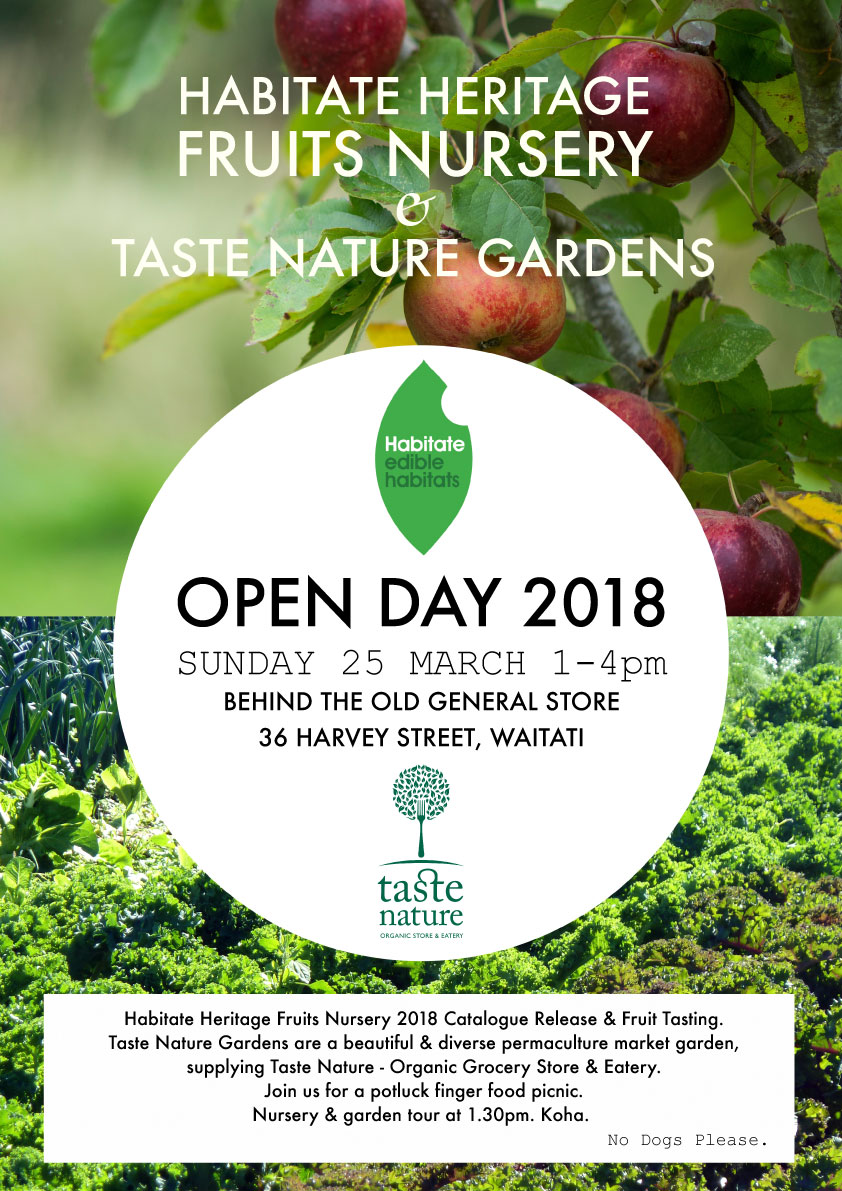
Sunday, August 13th, 2017
Learn to graft your own fruit trees. Grafting young, and reworking old trees covered in this workshop. You will take home two grafted trees and some fine whittling skills! A good knife is key, let us know if you would like to purchase a grafting knife, I hope to be able to supply them for less than $40 each.
Workshop is 1-4:30pm, 3rd Sept, Waitati, Otago.
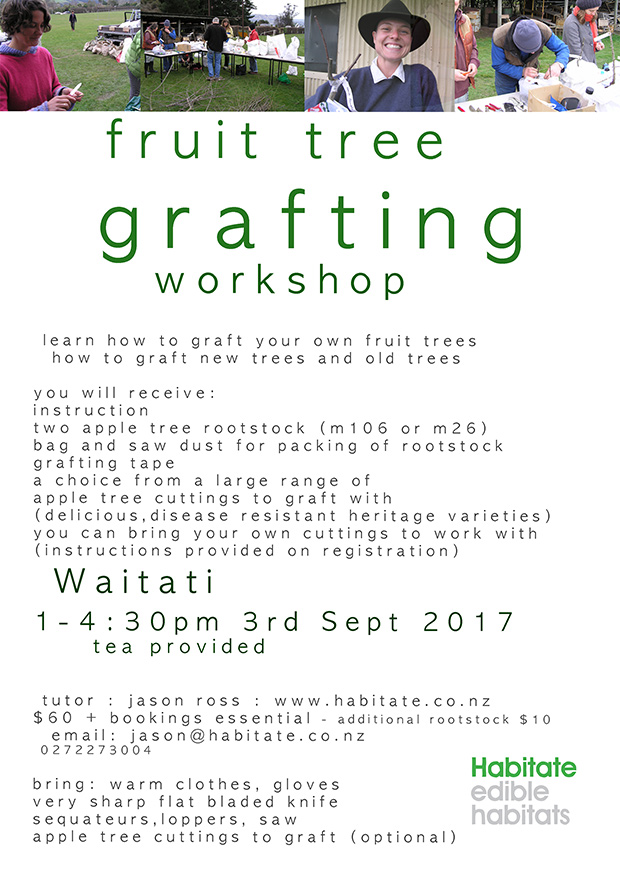
Sunday, July 9th, 2017
Fruit Trees Training Workshop
Waitati, 23rd July 2017
Hope to see you there!
Anyone on Otago Peninsula keen? We are running the same workshop this sunday 16/7/17 on Allan’s Beach Road, get in touch with Jenny at 021772295, if you are interested
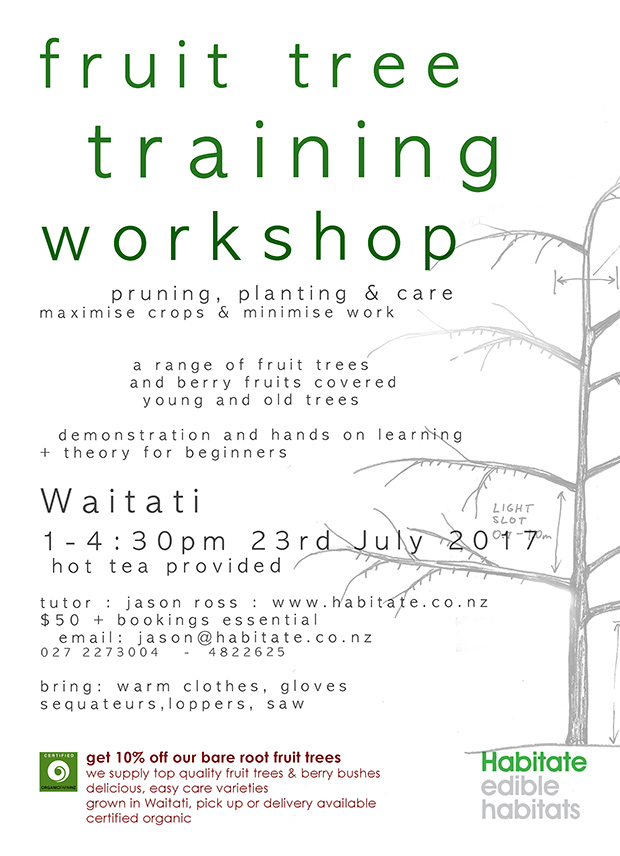
Monday, May 8th, 2017
See our nursery page / order form for what is available this season
Dessert Fruit is eaten raw, with cheese after dinner if you fancy
Cooker Fruit is eaten cooked
Juicing Fruit makes an exceptional juice
Cider This fruit is known to make a right good cider
Early Early Ripening (February)
Mid Mid Season Ripening (March/April)
Late Late Ripening (April/May)
B, C or D Flowering time group. Different varieties of apple in the same or adjacent groups will pollinate each other
SF Self Fertile. This variety will pollinate itself
PSF Part Self Fertile. This variety will partly pollinate itself, but will produce best with a pollinator nearby
Trip Triploid. This variety will not pollinate other apple trees at all, but requires a pollinator (a SF variety if you are to only have two apples).
ALL images and descriptions are given in good faith. Variation will occur with location.
ADAM’S PEARMAIN – Dessert – Late – C – Large , conical fruit with a red flush and attractive russet. Flesh is crisp, sugary, nutty and richly flavoured. Tree is medium vigour, spreading and a good cropper. Hardy, recommended for areas with cooler summers. Partial tip bearer. Norfolk, UK, 1826
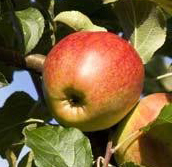
AKANE – Dessert / Cooking – Early – D – Small to medium, flat-rounded, coloured deep red. Juicy, crisp, slightly chewy and sweet/acid with a slight strawberry flavour. Keeps flavour and shape when cooked. The fruit hangs on the tree for weeks allowing a long picking period. Medium vigour tree, good cropper. Healthy, reliable. Japan, 1937
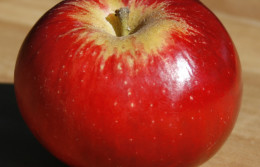
BEAUTY OF BATH – Dessert – Early – C – Small to medium, flat-round. Bright red stripes and flush. Juicy, sweet and fairly sharp, aromatic with a distinctive flavour. Very Early. Vigorous, upright spreading form, crops heavily. Tip bearer. Recommended for areas with cooler summers. Healthy. Bath, Somerset, UK, c1864
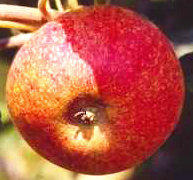
BELLE DE BOSKOOP – Dessert / Cooking, Cider – Early – C – Triploid – Versatile medium-large, gold fruit, flushed orange-red, with a fine russet. Crisp, firm flesh, with a sharp, aromatic flavour. Eaten raw mid season. Cooked early season it makes a thick golden and pink puree, with great flavour. Makes good cider. Stores well. Vigorous, spreading tree, a good cropper. Tolerates high and low rainfall. Healthy & reliable. Named after the small community of Boskoop, Holland, 1856
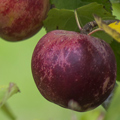
BRAMLEY’S SEEDLING – Cooking – Late – D – Triploid – The classic English cooker. Large, flat-rounded fruit with an irregular ‘blocky’ shape and greenish-yellow skin. Juicy, firm, sharply acidic flavour. Cooks to a puree, retaining its good strong acidic flavour. Keeps well. Very vigorous, spreading form, part tip bearer. Recommended for areas with cooler summers. Nottinghamshire, UK, 1809-1813
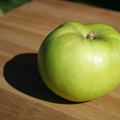
BROWNLEES RUSSET – Dessert / Cooking – Late – C – SF – Medium, short-round-conical, green/brown with a soft ocre russet. Sweet-sharp, aromatic, nutty, intense fruity flavour, juicy, crisp, firm. Great eating despite its dull looks. Keeps well. Medium vigour, upright. Recommended for areas with cooler summers. Tolerates high rainfall, hardy, healthy. Hertfordshire, UK, c1848
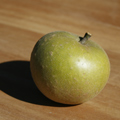
CHARLES ROSS – Dessert / Cooking, Juice, Cider – Early – C – PSF – Medium to large, conical fruit flushed orange/red with bright red stripes. Juicy, firm, sweet flesh with a good aromatic flavour. Keeps shape when cooked, juice/cider is medium sharp. Moderately vigorous, upright spreading stocky branches, good cropper. Recommended for areas with cooler summers. Tolerates high rainfall. Berkshire, UK, c1890
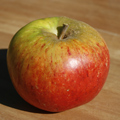
CORNISH AROMATIC – Dessert – Late – D – Medium-large, conical, ribbed and very distinctly five crowned. Bright red flushed with darker red stripes. Some Russet. White firm flesh. Has a fine sweet-sharp aromatic, good, nutty, almost spicy flavour. Tree is vigorous, hardy and prefers warm, wet climate (think Cornwell! Therefore suits coastal climes). A very healthy tree resistant to black spot and canker. Cornwall, first described by Sir Christopher Hawkins in 1813
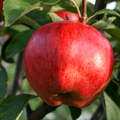
CRAB APPLE – Cooking – Late – Intense colour and good sharp flavours from this small deep red crab apple. Abundant fruit on a healthy tree with red leaves and stems.
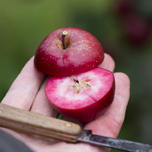
DISCOVERY – Dessert – Early – C – Medium, flat-round fruit, flushed bright blood red. Firm flesh, crisp, stained pink, fairly sweet, juicy and good flavoured with a strawberry hint. Very Early. Keeps well for an early apple. Medium vigour, crops well from an early age. Tends to tip bearing and requires little pruning. Blossoms frost tolerant. Recommended for areas with cooler summers. Tolerates low rainfall areas. Healthy and reliable. Langham, Essex, UK, Raised circa 1949 by Mr Dummer
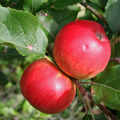
EGREMONT RUSSET – Dessert / Juice – Early – B – PSF – The classic russet. You haven’t tried a russet? They are deliciously unlike a modern apple! Medium, flat-round, gold, slight orange flush with an ochre russet. Firm, crisp, sweet flesh with a very good nutty aromatic flavour. Makes good rich juice. Moderately vigorous, upright, compact, precocious, reliable, good cropper, suited to pot culture, blossom is frost tolerant. Recommended for areas with cooler summers. Possibly Sussex, UK, first recorded it in 1872
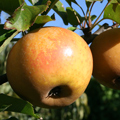
EPICURE – Dessert – Early – C – PSF – Small, round-conical, dark orange-red flush, thick red stripes. Juicy, crisp, slightly aromatic, delicate, excellent refreshing flavour. Hardy tree, precocious, spur bearer, heavy cropper, blossoms frost tolerant. Recommended for areas with cooler summers. Laxton Bros., Bedford, UK, in 1909
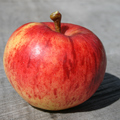
FORTUNE – Dessert – Early – C – PSF – Medium, round-conical, striped and flushed red, russet netting. Firm flesh, sweet, juicy, slightly aromatic and rich when fully ripe. Juice is medium sharp. Moderately vigorous tree, hardy, precocious, good cropper, part tip bearer, blossom frost tolerant. Recommended for areas with cooler summers. Healthy. Laxton Bros., Bedford, UK in 1904
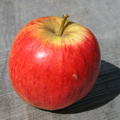
GRENADIER – Cooking, Juice, Cider – Early – C – PSF – Large, round-conical, ribbed, greenish-yellow fruit. Firm, fine textured, crisp and sharp. Fluffy when cooked, with an excellent sharp flavour. Very early. Medium vigour, compact, hardy tree. Heavy cropping, tip bearer. Recommended for areas with cooler summers. Tolerates a wet soil and climate. Healthy. Slough, UK, c1862
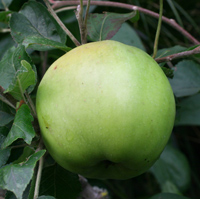
HETLINA – Dessert – Mid – Medium sized, attractively coloured fruit with a bright red blush. Flesh is refreshing, crisp and firm. Reputed to contain high levels of riboflavins and other health-promoting vitamins. Healthy tree with an upright habit. Originated in Czechoslovakia

IRISH PEACH – Dessert – Early – B – Medium, yellow fruit flushed with red. Juicy, crisp, sweet-sharp with an excellent aromatic flavour. Vigorous, good very early cropper. Recommended for areas with cooler summers. Sligo, Ireland, c1819
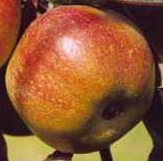
KIDD’S ORANGE – Dessert – Late – D – Medium sized conical fruit. Yellow/gold, flushed deep crimson with dark stripes. Variable russet. Juicy and crisp, with a sweet-sharp, rich, aromatic flavour. Stores well. Medium vigour tree with an upright, compact shape. Spurs freely, good reliable cropper. Recommended for areas with cooler summers. Dislikes wet areas. Healthy tree. New Zealand, 1924 bred by James Hatton Kidd
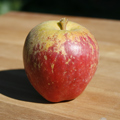
LADY SUDELEY – Dessert – Mid – D – PSF – Medium-large, round-conical fruit, striped bold red. Flesh is cream-yellow, quite sweet, juicy, firm, with a good aromatic flavour. Moderately vigorous tree, a, good cropper, spurs freely, part tip bearer, suited to pot culture. Blossom is frost tolerant, recommended for areas with cooler summers. Kent, UK, 1849
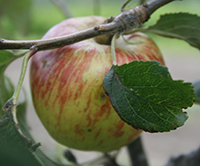
LAWFAM – Dessert – Mid – C – Medium to large, round-conical, with very dark scarlet-maroon skin. Firm white flesh, crisp, sweet, melting with a strawberry / vinous (grape like) hint. Vigorous, spreading, heavy cropper. Canada (ott), 1898
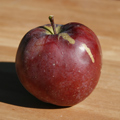
LIBERTY – Dessert – Late – C – Medium, round to conical fruit, flushed and striped bright red. Juicy & crisp with a good sweet-sharp flavour. Vigorous and spreading, fruits young and is a good, regular, reliable cropper. Healthy, tolerates high rainfall. New York, USA, 1974
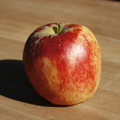
MERTON RUSSET – Dessert / Juice – Late – C – Medium sized, conical, golden fruit with a fine cinnamon russet. Flesh is firm and sweet/sharp with a unique spicy, lemon / pineapple flavour. Very Late. Stores well. Vigorous, heavy cropper. Raised 1921 by John Innes, Hort Institute
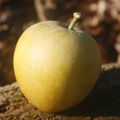
PEASGOOD’s NONSUCH – Dessert / Cooking – Mid – C – PSF – Very large, round fruit. Yellow with broad broken red stripes. Eaten raw is sweet-sharp, juicy and aromatic. Cooks beautifully to a delicate, fluffy puree texture with a good sweet-sharp flavour. A medium vigor, very hardy tree that spurs freely. A reliable, good cropper. Originally grown by the young Mrs Peasgood at Grantham, Lincolnshire, UK, from seed sown in about 1858
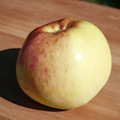
PRIMA – Dessert / Drying – Mid to Late – C – Medium sized, round, yellow with a bright red blush and faint stripe. Fine grained yellow flesh, crisp and juicy with a rich fruity flavour. Vigorous tree, good cropper. USA, 1957
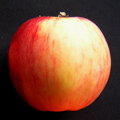
REINETTE DU CANADA – Cooking – Late – D – Triploid – Medium to large, round-conical, yellow/gold fruit with a slight orange flush and russet netting. Pale cream, firm flesh. Cooks to a stiff puree that is sweet and rich. Keeps well, high vitamin C. Vigorous, good cropper. France
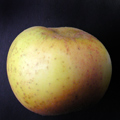
RIBSTON PIPPIN – Dessert / Cooking – Late – C – Triploid – Medium sized, round-conical golden fruit, striped red. Flesh is pale yellow, firm and juicy, with an aromatic, intense, rich, flavour. Very high vitamin C content, keeps well. Medium vigour tree, precocious, good cropper. Recommended for areas with cooler summers. Yorkes, UK
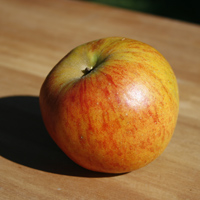
SPARTAN – Dessert – Late – D – SF – Medium sized, round-conical fruit, smooth skinned, flushed deep maroon red. Flesh is a contrasting pure white, crisp and very juicy with a sweet-sharp, aromatic strawberry/melon/vinous (grape like) flavour. Hardy, vigorous tree that spurs freely, blossom is frost tolerant. Recommended for areas with cooler summers. British Columbia, Canada. 1926
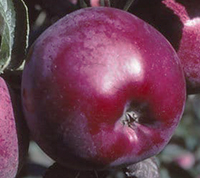
SUNSET – Dessert – Mid – SF – Small-medium sized round fruit, golden, flushed orange and striped red with russet patches. Firm, crisp, fine textured, moderately juicy and sweet-sharp flesh with a good intense aromatic flavour. Medium vigour tree, compact, suited to pot growing. Spurs freely. Regular heavy crops. Blossom tolerant of frost. Recommended for areas with cooler summers. Prefers a dry cool climate. Kent, UK, c1918

TYDEMAN’S LATE ORANGE – Dessert – Late – D – Medium sized, round-conical fruit. Golden, with an orange-red flush, striped red with russet netting. Firm, crisp, fairly juicy flesh, sweet, with a good, rich, sub-acid, aromatic flavour. Keeps well. Vigorous, slender branches, spurs freely, good cropper. Blossom is frost resistant. Recommended for areas with cooler summers. Prefers a dry climate. Healthy. East Malling Research Station, Kent, UK, 1930
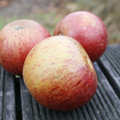
MOORPARK – Dessert / Cooking / Bottling – Early – SF – Delicious richly flavoured apricot. Healthy tree, suited to hot dry conditions. The best apricot for coastal climates.
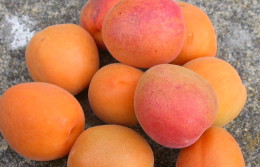
BLACK BOY – Dessert / Cooking – Late – SF – Medium sized, port wine skinned fruit. Flesh is mottled white and red, delicious raw, stewed or bottled. Resistant to leaf curl – the best peach for coastal areas.

BEURRE HARDY ($40)- Dessert – Mid – D – Triploid- Medium to large fruit, yellow skin with a fine cinnamon russet. Smooth, melting, buttery and very juicy flesh. Rich aromatic flavour. Vigorous, healthy tree, quite hardy. Regular heavy crops in a warm location. France, 1820
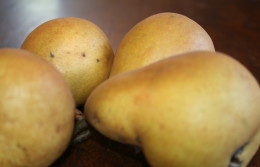
CONFERENCE – Dessert / Cooking – C – Medium to large long necked fruit, green with russets spots. Sweet, very juicy flesh, smooth, pleasant flavour. Can be eaten from crunchy to soft, giving it a long season. Cooks and bottles beautifully. Moderately vigorous, spurs freely, hardy, regular, reliable crops. Recommended for areas with cooler summers. Berkenshire, UK, introduced 1894

JARGONELLE- Early
LOUIS BON OF JERSERY – Mid
STARKRIMSON – Dessert / Cooking – D – Medium sized fruit with wine red skin Flesh is white, firm, fine grained, crisp, sweet and very juicy with a slightly sub-acid flavour. Great for canning. Vigorous, upright, hardy, very good cropper. Missouri, USA, c1950

WILLIAM’S BON CHRETIEN (BARTLETT)- Dessert / Cooking – Early – D – SF – Medium-large, golden-yellow fruit with red streaks on sunny side. Very smooth flesh, juicy, sweet and sub-acid. It has a good, strong flavour. Great eaten raw, and the worlds most popular bottling pear. Moderately vigorous, fairly hardy, good crops. UK renamed Bartlett in USA

ANGELINA BURDETT- Dessert – Early – SF Pollinator: Greengage – Medium sized, blue – black, flesh greenish – yellow, very juicy, good flavour, hangs well on tree. Greengage type.
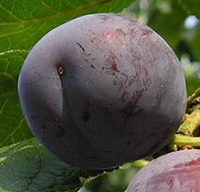
BILLINGTON’S – Dessert / Cooking – Early – Pollinators: Santa Rosa, Wilsons Early SF – Small, dark red skin, light red firm flesh, good flavour, good cooker, clingstone. Reliable cropper.
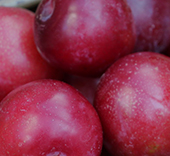
BURBANK
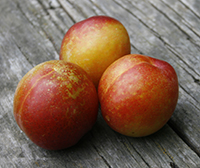
GREENGAGE
SANTA ROSA
SATSUMA
STANLEY PRUNE – Dessert / Drying – Early – SF – Medium sized, dark blue, freestone fruit, oval in shape, flesh is yellow, juicy, sweet and very good quality. Vigorous tree, late flowering, hardy, reliable and a good cropper
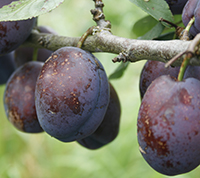
WILSON’S EARLY – Dessert / Cooking – Early – Pollinators: Billington’s, Santa Rosa – Small fruit (bigger if thinned), bright red, flesh yellow, juicy, tart, clingstone. Medium vigour tree. Very early, very reliable. (Japanese type)
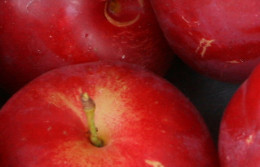
Quince ‘Orokonui’- A fantastic quince variety found in Waitati. Medium size fruit, healthy tree.
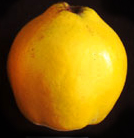
Make your own Elderflower Champayne, Cordial, Elderberry wine, syrup. Many other medicinal uses. A hardy multifunctional tree.
Albany Surprise
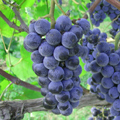
Blackcurrant ‘Kimberly’
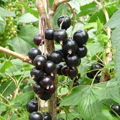
Blackcurrant ‘Goliath’

Invicta – Large Green, mildew resistant
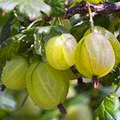
Pax – Red, nearly thornless
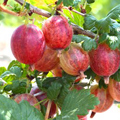
DWARF COMFREY – Symphytum ibericum
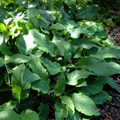
RUSSIAN COMFREY – Symphytum x uplandicum
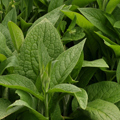
15-20mm diameter x 100-1500mm high
Ready for your spring grafting
Apple – Vigorous M793
Apple – Medium M106
Apple – Dwarf M26
Pear – BA29 Quince (requires an interstock, Purchase Beurre Hardy to graft incompatable varieties onto)
Golden Queen Rootsock – For grafting: Apricots, Peaches & Plums N/A 2017
VEGETABLE PLANTING CHART FOR COASTAL OTAGO / SOUTHLAND An easy to read wall chart showing which months vegetables can be sown direct, into trays or planted as seedlings. Succession planting and much more information… Put it on your fridge or in the potting shed for quick reference. The visual chart format helps with planning your yearly vegetable planting. A3 – Printed on robust recycled card
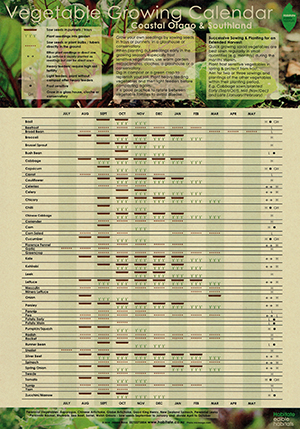
EDIBLE & USEFUL TREES AND SHRUBS FOR THE DUNEDIN AREA – “A fine selection of multifunctional plants suited to organic and permaculture plantings in town and countryside.” Extensive tables of trees and shrubs give information on botanical name, size, multiple uses and preferred conditions. This is great starting point for further research into useful plants for coastal climates in the South of the South Island. Plant lists are provided for: Fruit, Nuts, Vegetable Uses, Edible Flowers, Animal forage, Chicken Forage, Bee Forage, Timber, Coppice, Dye, Shelter, and Nitrogen Fixing. 32 page booklet, by J. Ross, 2002.
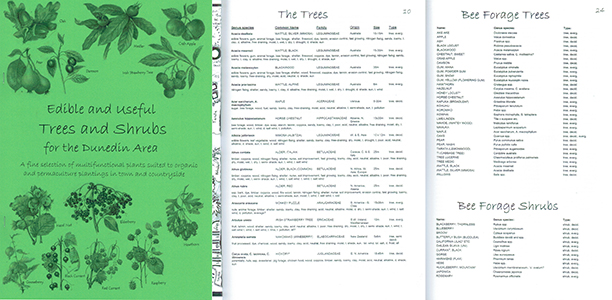
Monday, March 6th, 2017
We hope that you can come to our open day, tour our nursery and Taste Nature Gardens, taste some apples and apple juice straight from the press and share in a potluck picnic.
Habitate Nursery & Taste Nature Gardens Open Day 2017
Sunday 19th March 1-4pm
Behind the old general store 36 Harvey Street, Waitati.
Tours at 1.30pm
Apple Tasting Table at 2.15pm
Potluck Picnic
Taste Nature Gardens are a beautiful and diverse organic market garden, supplying Taste Nature – Dunedin’s organic shop
Habitate Nursery Catalogue Release for Habitate Nursery: A mail order nursery supplying quality organically grown frtuit trees and berry bushes – tasty, easy to grow varieties for home orchards
Koha
share this event with friends:
https://www.facebook.com/habitate.edible.habitats
See you there, Jason
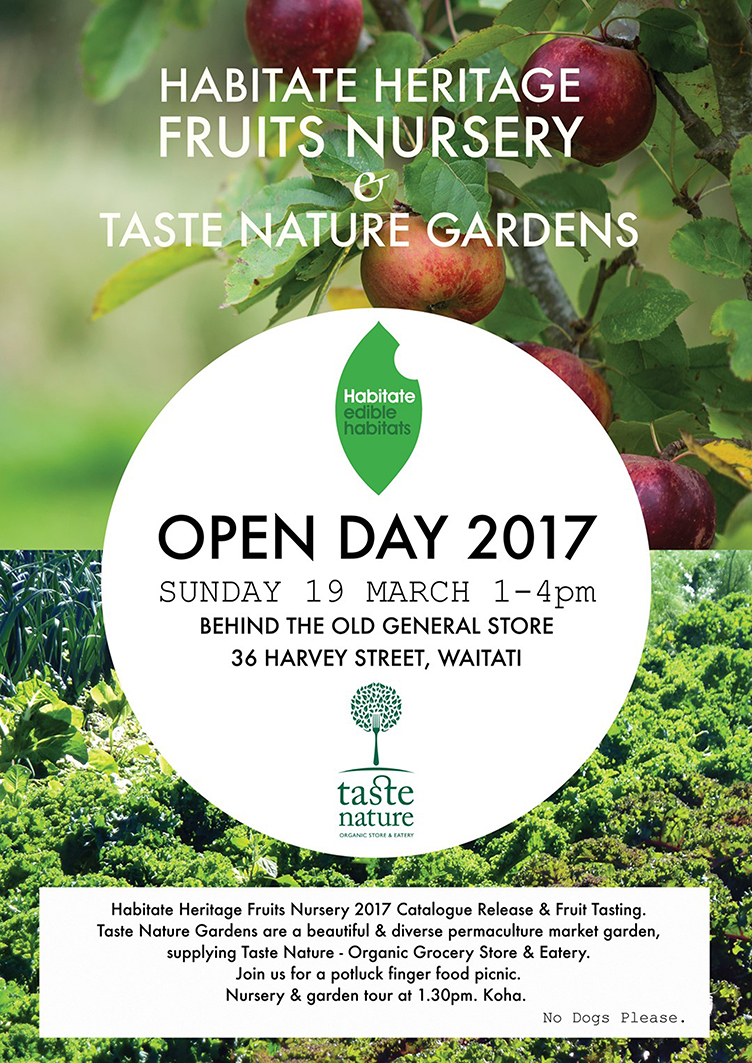
Wednesday, December 14th, 2016
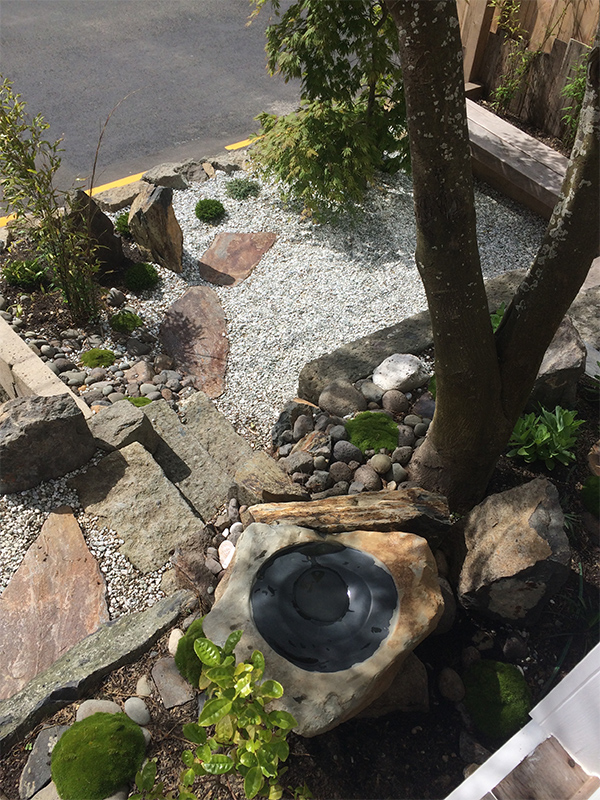
Water Bowl by Moira Crossman In Zen Garden
Want a peaceful sanctuary at home? One that incorporates edible and medicinal plants? Here a sunken courtyard for relaxing at the front of the house and vegetable beds, glasshouse, chickens, berries and fruits out the back surrounding a sleep out. The Zen garden theme was used throughout with edible plant forms, colour and combinations used to give a informal but balanced feeling.
“We are so stoked with the plan. I especially like how you were able to get the straight lines and the curves as well – i know the squareness of it was kind of challenging. Very blessed thanks.”
“Front is beautiful now and when trees and garden grow will be exquisite. We love your design.”
With exquisite detailing, and using recycled stone and timber, the installation of the front garden was managed by the owner in Winter 2016. We sourced the plants and worked together on planting Spring 2016
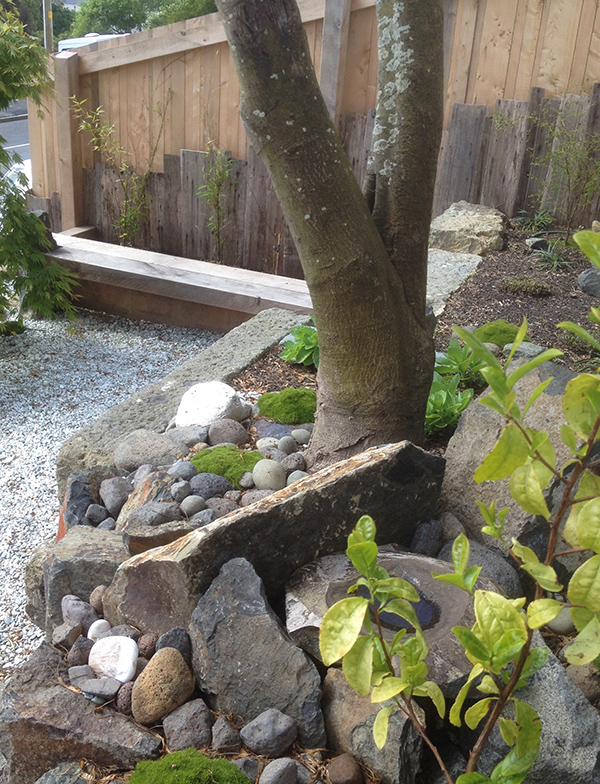
Tea Camelia in Zen Garden. Local stone slabs and Macrocarpa seating
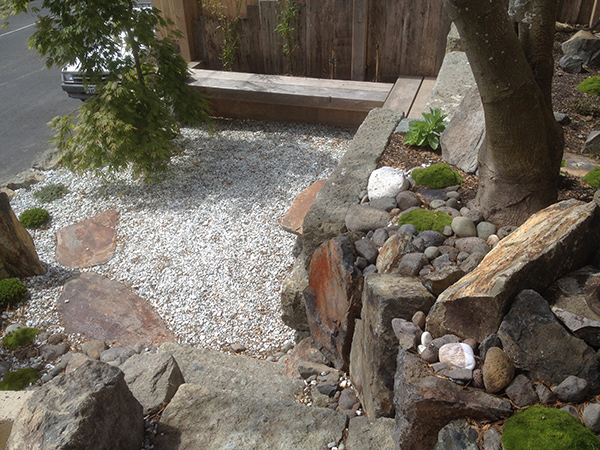
Zen Garden Sunken Courtyard
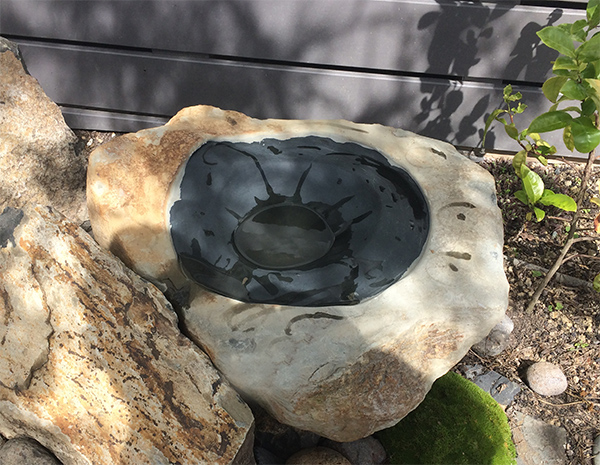
Water Bowl by Moira Crossman
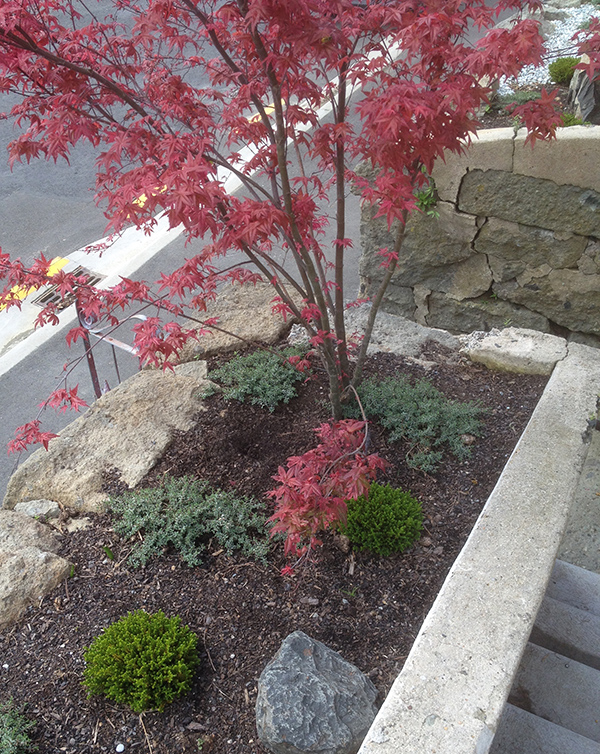
Pink Maple with Pimelia & Hebe
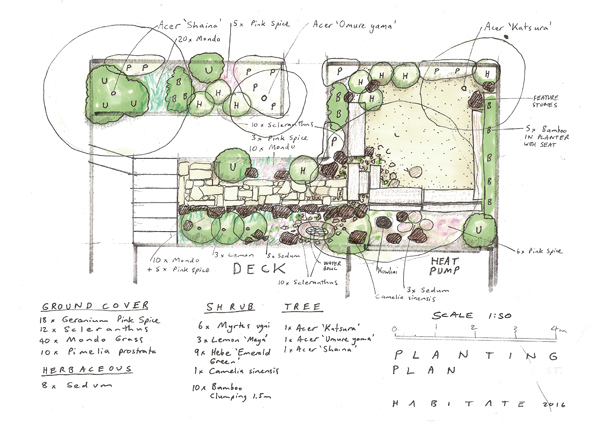
Edible Zen Garden Planting Plan
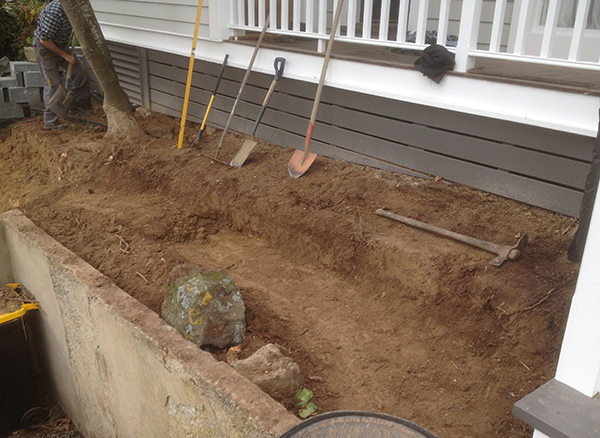
Making the pathway
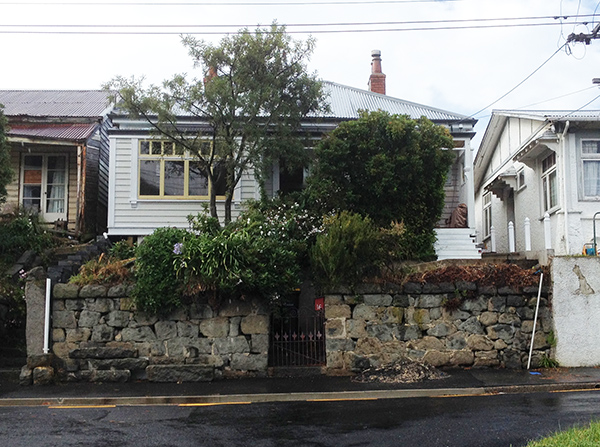
Before PHOTO
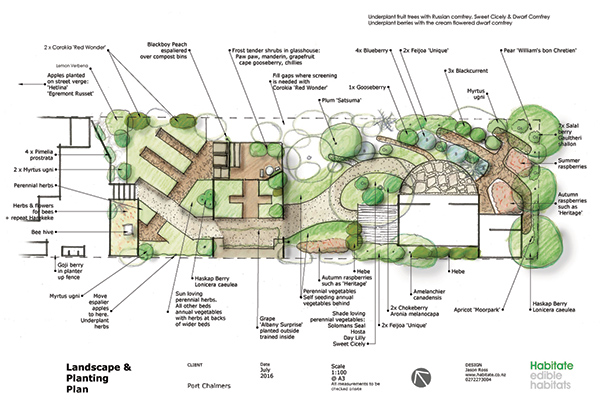
Edible Zen Garden Back Yard – Yet to be developed
Sunday, October 9th, 2016
We were commissioned in 2016 create a Permaculture Masterplan for Kowhai Grove, a project run by the Malcam Trust in Dunedin. Annika Korsten is directing the project, primarily as a base for student of the Hands On program that she runs, which introduces 16-24 year olds to farm and horticulture work. Annika envisages other groups getting involved with specific aspects of the project as it develops – contact her if you want to get involved!
Permaculture teacher Peta Hudson fascilitated gathering insights from previous program participants and we pulled this together with Annika’s ambitious vision for a thriving diverse organic horticulture centre.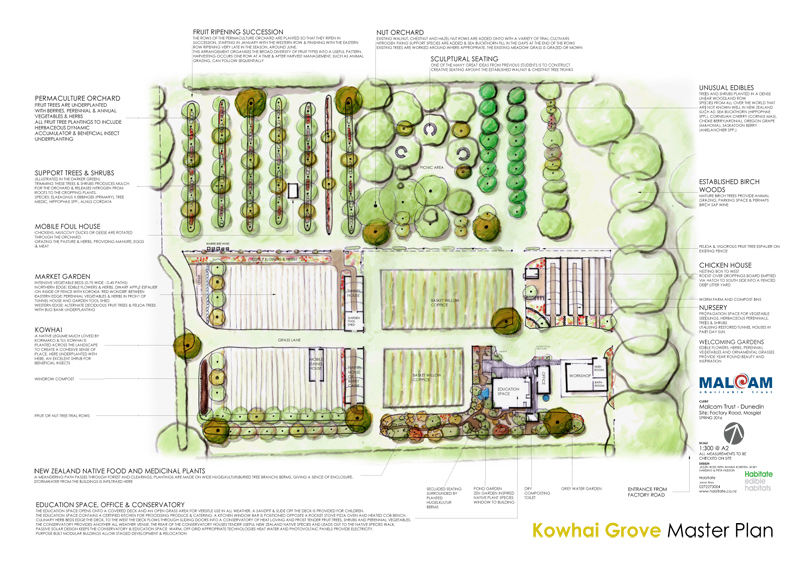
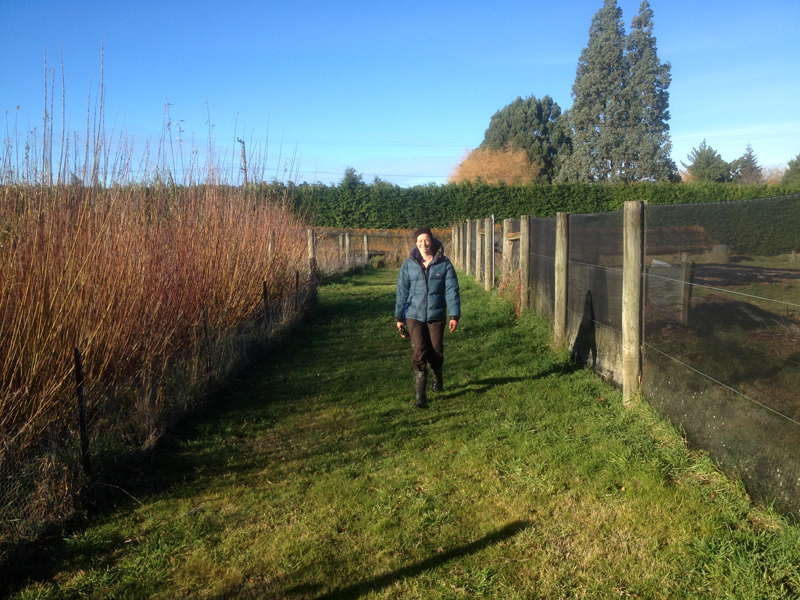
Annika Korsten – Kowhai Grove, Taieri Plains, Otago
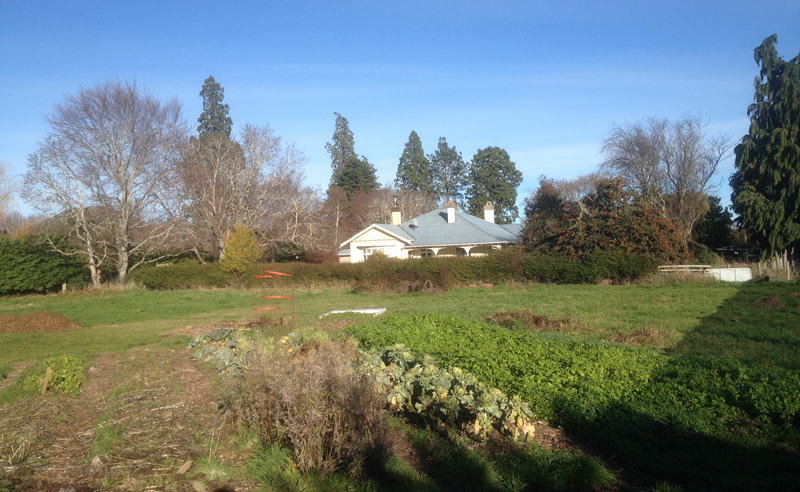
The area to be developed into an intensive organic market garden
Thursday, October 6th, 2016
A highly productive diverse permaculture orchard was called for on three sides of this new build in Tarras, Central Otago. We worked closely with the exact contours of the site to lay out orchard rows to fit the landscape while providing many functional solutions. Water runoff from the drive run may be fed into them for re-charging soil water. The linear beds are easy to mow along, provide space for planting support species for nitrogen fixing, accumulation of minerals, producing mulch and feeding beneficial insects.
Planting is zoned with summer fruits close to the house and Walnuts, chestnuts and Oaks further away. A clearing is created in the nut area for picnics. Rows are designed to ripen sequentially for ease of harvesting and to aid post harvest management. Kowhai and other natives are used alongside Italian Alder in the shelter planting. Nitrogen fixing Elaeagnus are integrated within the orchard.
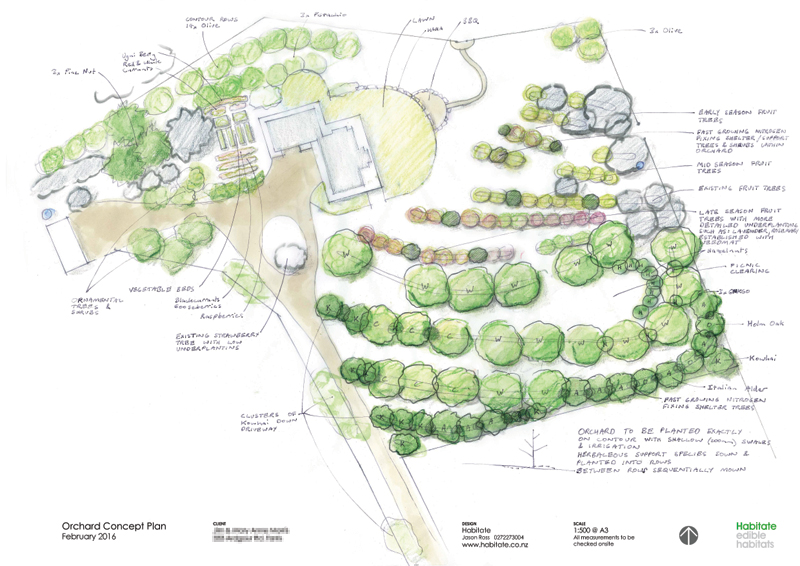
The masterplan shows how the contour rows serve to screen the road and lead you from the house towards the old existing fruit trees.

The orchard site before planting, looking dry in high summer.

Contour swales are shaped in autumn.
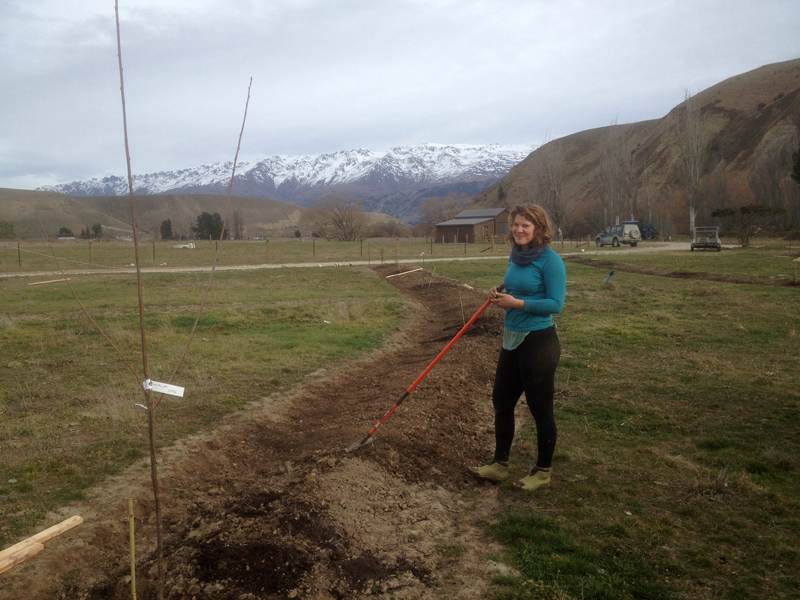
Swales are finetuned by hand at planting time.
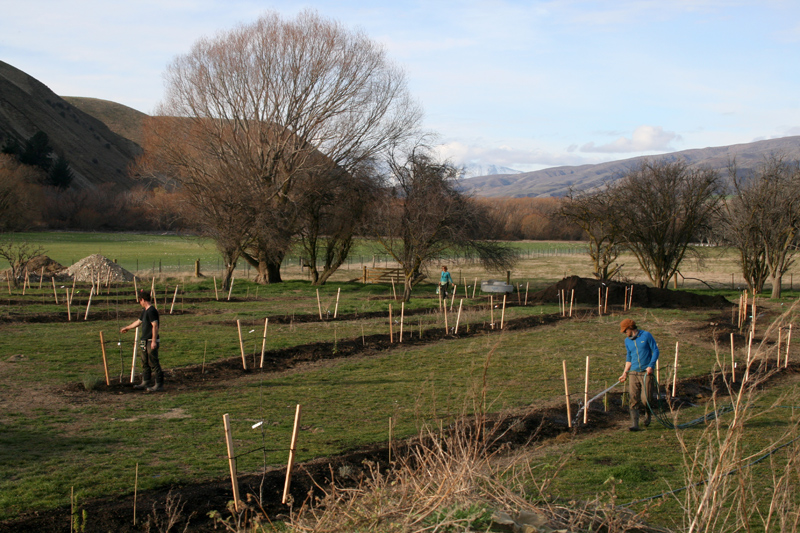
All trees are staked and trained at planting.
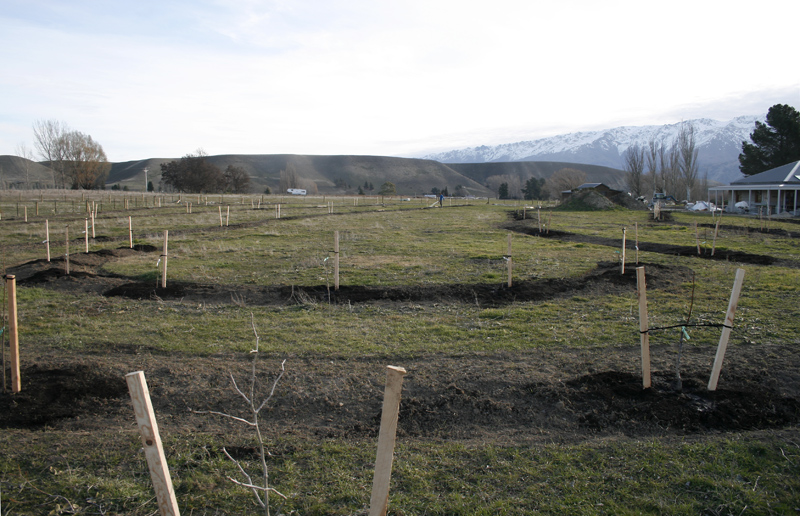
A curve of hazel nut trees form the back of the nut orchard picnic area.

Overview of the planted orchard.
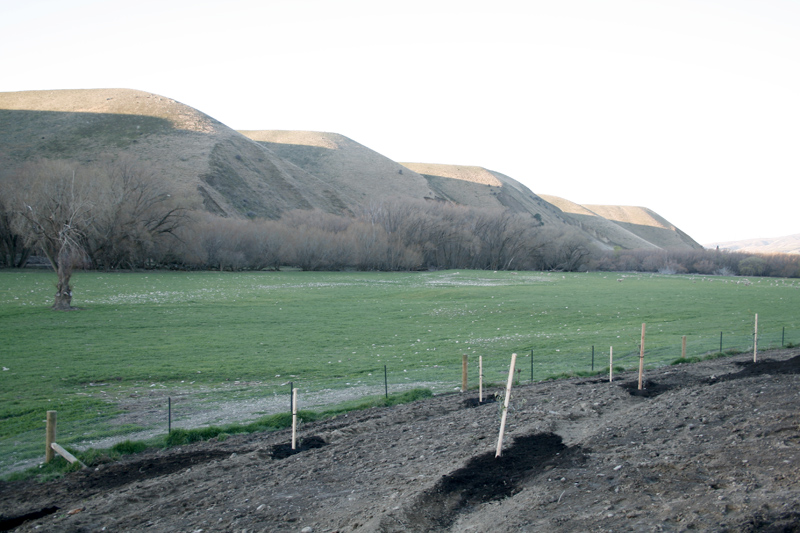
Meanwhile over the other side of the house on a steep dry bank we installed swales and planted olives and berry fruits.
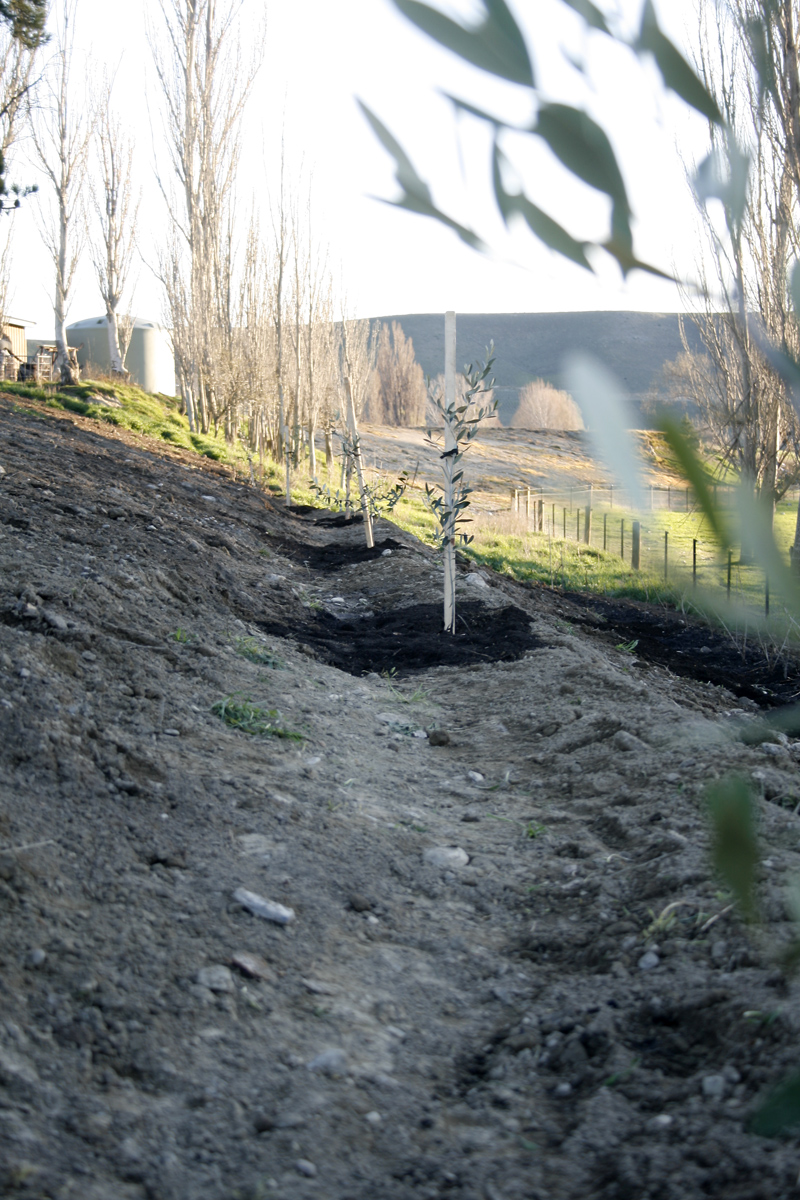
Olives planted in the swale.
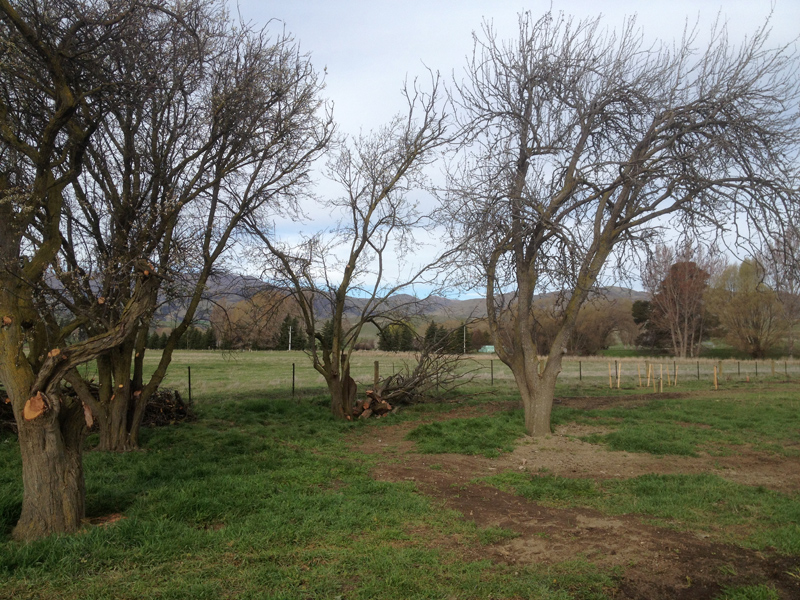
We pruned these beautiful old fruit trees to improve fruit quality.
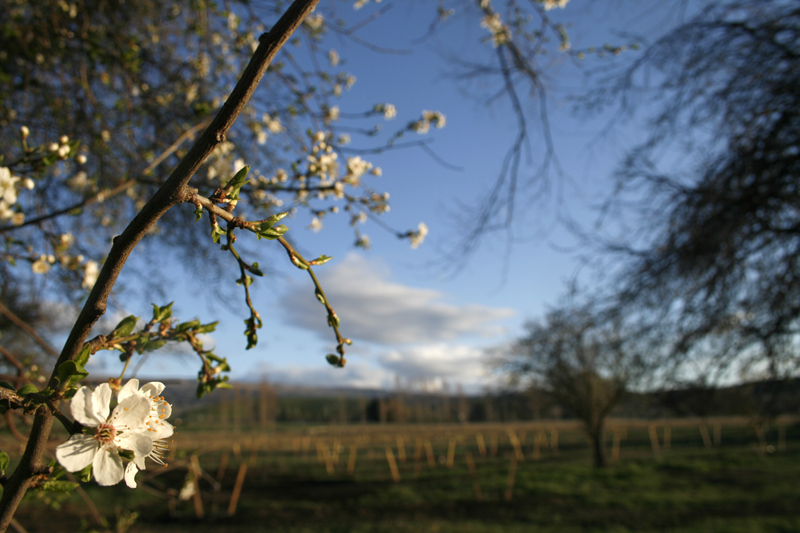
Blossom out at the end of the day.
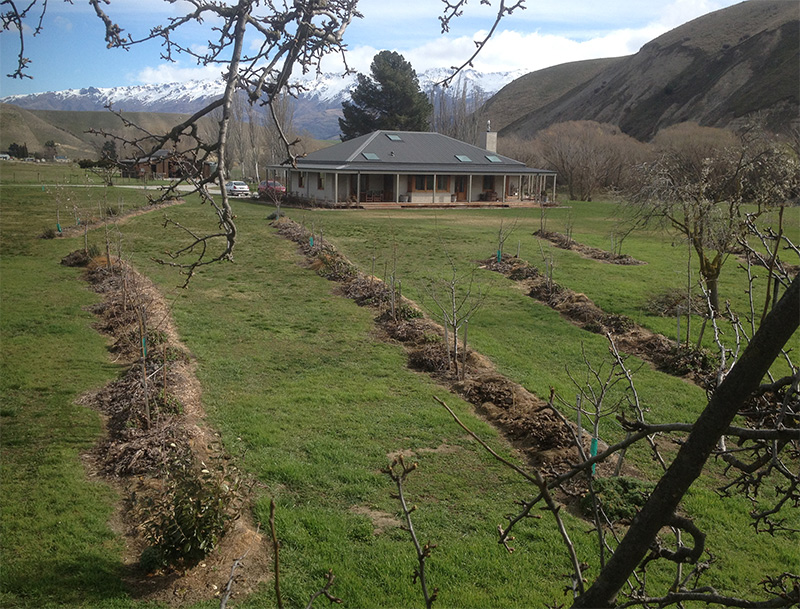
Winter 2018 fruit & nut tree rows after a pruning and training session. Elaeagnus shrub in the foreground is included to increase shelter in the orchard, provide winter structure and mulch material from its trimmings
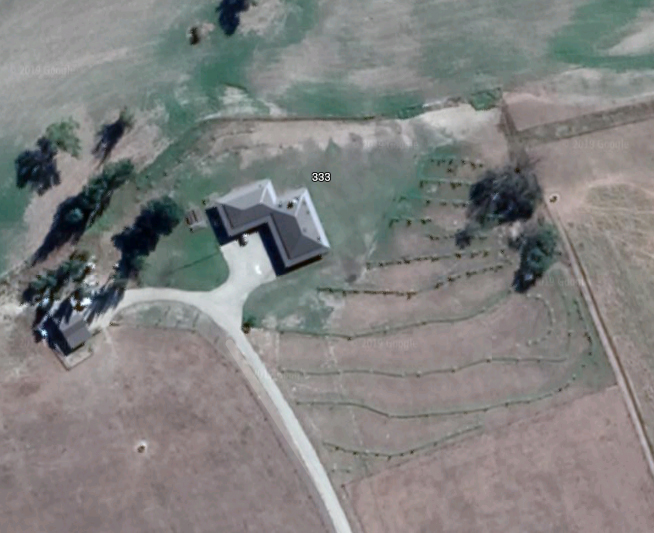
The Orchard Trees on Contour are becoming visible in this 2019 Aerial Photo
Monday, September 12th, 2016
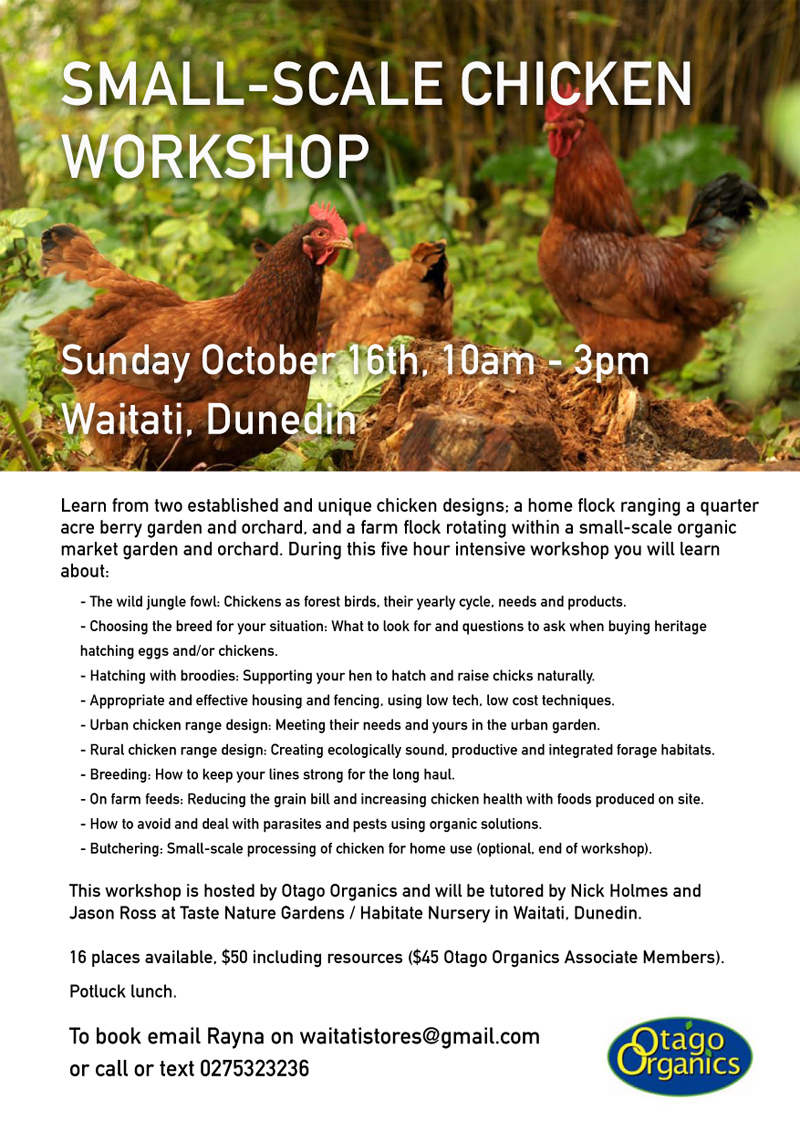 Sunday 16th October
Sunday 16th October
10-3pm Waitati
This workshop is hosted by Otago Organics and will be tutored by Nick Holmes and Jason Ross
Learn from two established and unique chicken designs; a home flock ranging a quarter
acre berry garden and orchard, and a farm flock rotating with in a small-scale organic
market garden and orchard.
$50 ($45 Otago Organics Associate Members).
Pot luck lunch.
To book or find out about other great events run by Otago Organics email Rayna
waitatistores@gmail.com
or call ormtext0275323236
Save
Monday, July 25th, 2016
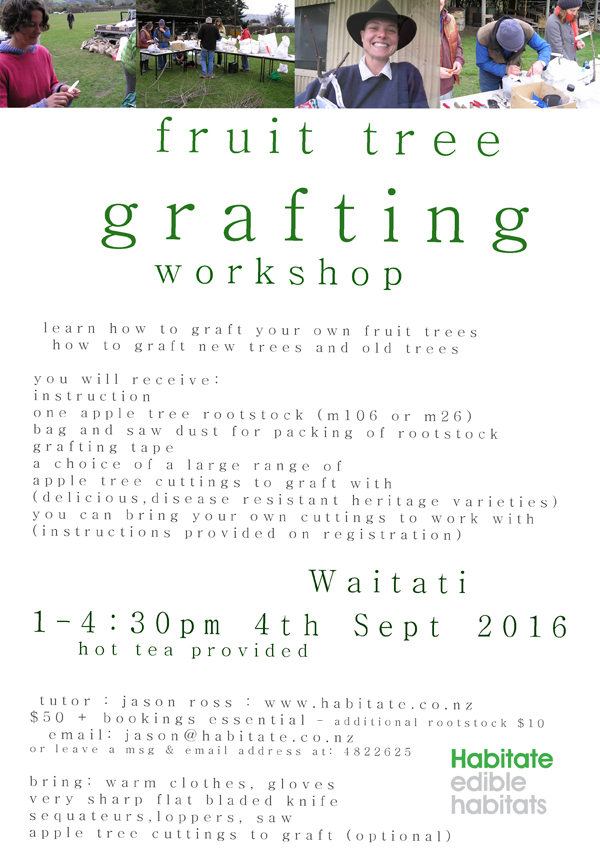 fruit tree
fruit tree
grafting
workshop
learn how to graft your own fruit trees
how to graft new trees and old trees
you will receive:
instruction
one apple tree rootstock (m106 or m26)
bag and saw dust for packing of rootstock
grafting tape
a choice of a large range of
apple tree cuttings to graft with
(delicious,disease resistant heritage varieties)
you can bring your own cuttings to work with
(instructions provided on registration)
Waitati
1-4:30pm 4th Sept 2016
hot tea provided
tutor : jason ross : www.habitate.co.nz
$50 + bookings essential – additional rootstock $10
email: jason@habitate.co.nz
or leave a msg & email address at: 4822625
bring: warm clothes, gloves
very sharp flat bladed knife
sequateurs,loppers, saw
apple tree cuttings to graft (optional)
Monday, July 25th, 2016
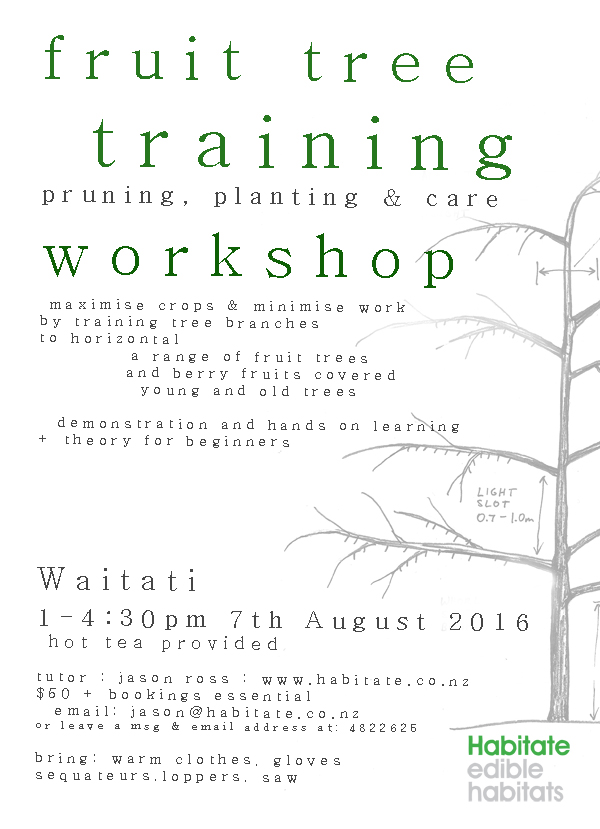 fruit tree
fruit tree
training
pruning, planting & care
workshop
maximise crops & minimise work
by training tree branches
to horizontal
a range of fruit trees
and berry fruits covered
young and old trees
demonstration and hands on learning
+ theory for beginners
Waitati
1-4:30pm 7th August 2016
hot tea provided
tutor : jason ross : www.habitate.co.nz
$50 + bookings essential
email: jason@habitate.co.nz
or leave a msg & email address at: 4822625
bring: warm clothes, gloves
sequateurs,loppers, saw
Save
Saturday, March 12th, 2016
Bare rooted plants can be kept in their packaging for a few days. Keep them cool and moist by watering the root ball in the packaging, swishing the water around, and then tipping the water back out.
If there is to be a delay of more than a few days before planting, heel the plants in: Soak the roots for 15 minutes in water with a dash of liquid fertiliser. Place bundles into trenches of moist earth and loosely cover the roots with soil.
Animals: Fence from browsing animals otherwise you are buying very expensive animal feed! If Rabbits or Hares are present your trees will need trunk sleeves to 70cm. Fencing animals out? Perhaps you can design this infrastructure to also rotate beneficial animals within the orchard?
Shelter: The orchard site must be sheltered. On a windy site this shelter should be established at least a year ahead. If planting shelter the same year as the fruit trees use very fast species and consider planting not only the perimeter but also within the orchard with shelter trees.
Soil: A depth of around 15-20cm of topsoil is enough for most fruit trees. If drainage is an issue plant on a shallow mound or a swale berm. Balance soil minerals over the whole orchard area with mineral amendments.
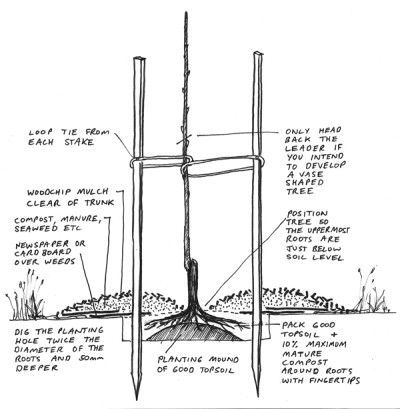 Planting Guide
Planting GuidePlant bare root trees and shrubs from Late June till late August.
Water weekly as needed for the first couple of months and then as needed in dry periods.
Surface feed and mulch each winter (under mulch) and watering in accordance with your soils needs and the plants growth. Establish appropriate groundcover plants to keep weeds, especially grass, suppressed.
Carefully chosen groundcover and companion plants such as Russian and Dwarf Comfrey, Sweet Cicely and Feverfew can help improve soil structure and fertility. They can also aid with pest and disease prevention.
Pinch off all flowers/ fruit in November until tree is growing vigorously and has strong branches, usually in their third summer you can leave a small crop on. Remove all growth from below the graft union.
Most fruit trees will naturally adopt a central leader shape, with a strong central trunk and near horizontal branches radiating off this. Stone fruit are usually trained as a vase shape (see below).
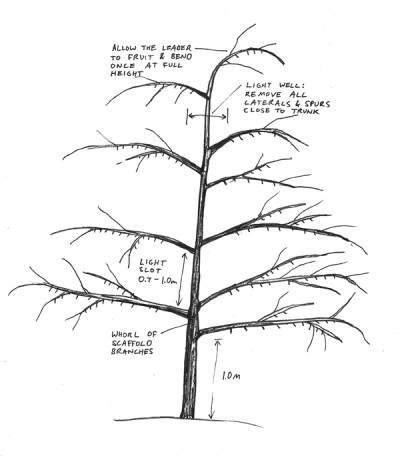 Central Leader
Central LeaderYear One: Leave the trunk un-pruned. Prune off any branches below 1m and any competing leaders. In November remove any developing fruit and train down all branches so that their junction with the trunk is near to ninety degrees and the branch is near to horizontal. Tree training rubber bands, twine or notched spacers can be used for this job.
Year Two: August, prune off any branches below 1m and any competing leaders. Prune out completely any dead, diseased or damaged (crossing) branches. Prune out any fruit spurs on or close to the trunk and any on the lower side of branches. Training aids from November may be removed now if the branches stay in the horizontal position. In November thin out all fruit except one or two near the trunk.
Year Three: Repeat winter pruning, take out whole branches as necessary to create well spaced branches up the trunk. You may leave more fruit on this year if the tree is sturdy. From now on thin all fruit to one or two fruit per spur.
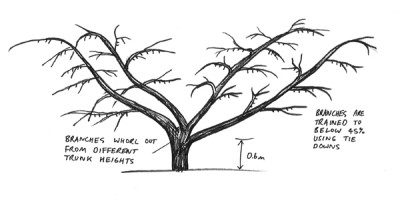 Vase Shape Trees
Vase Shape TreesYear One: Head back the main trunk to around 1m, either to some good side shoots or good buds. Prune off any branches below 0.8m and any competing leaders (side shoots growing too vertically). In November remove any developing fruit and train down all branches so that their junction with the trunk is near to ninety degrees and the branch is near to 45%. Tree training rubber bands, twine or notched spacers can be used for this job.
Year Two: August, select four strong branches to be your main vase structure. Prune off any branches below 0.8m and any vertical shoots surplus to your four main branches. Prune out completely any dead, diseased or damaged (crossing) branches. Prune out any fruit spurs on or close to the trunk and any on the lower side of branches. Training aids from November may be removed now if the branches stay in the 45% position. In November thin out all fruit except one or two near the trunk.
Year Three: Repeat winter pruning, take out whole branches as necessary to create well spaced vase of four branches from the main trunk. You may leave more fruit on this year if the tree is sturdy. From now on thin all fruit to one or two fruit per spur.
Monday, February 29th, 2016
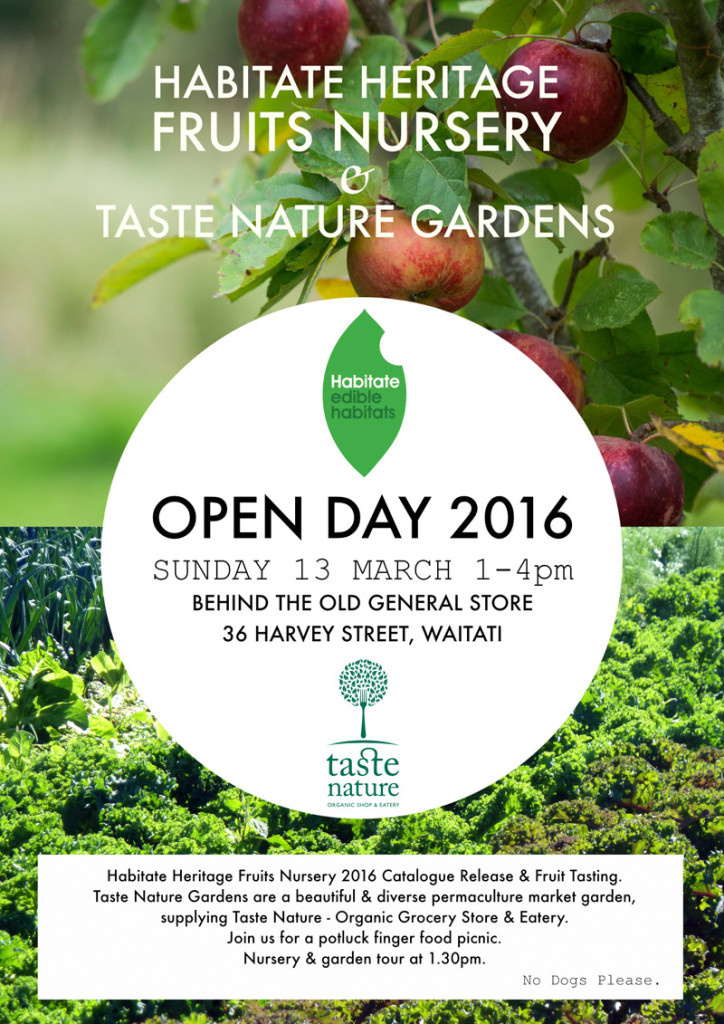 We warmly invite you to our annual nursery open day, this year its combined with Taste Nature Gardens (http://www.tastenature.co.nz/the-garden/).
We warmly invite you to our annual nursery open day, this year its combined with Taste Nature Gardens (http://www.tastenature.co.nz/the-garden/).
Bring a blanket and soak up the goodness of this diverse and beautiful productive permaculture property.
Dont miss the fruit tastings of heritatge fruits and our 2016 catalogue release.
Sunday, February 14th, 2016
Keyhole shaped raised vegetable beds and herbs are placed close to the kitchen in this steep city garden. Ornamental plantings are inspired by wildflower meadows and are beautiful and brilliant for bees and insects too.
Planting was completed September 2016 so we look forward to the plants filling in. In early 2015 we completed a full section concept plan for the property and constructed the courtyard, gardens and orchard over 2015-16.
The garden is pretty special, with stone walls, mortise and tenon redwood pergola, corten steel steps, macro keyhole vegetable beds, herbs, ornamental garsses and a micro orchard. The owners were very sad to unexpectedly have to leave “The number one item on our list of reasons to stay was the wonderful garden you built for us, and which we have enjoyed mightily, particularly for the past 3 summers.” Their real estate agents like it too:
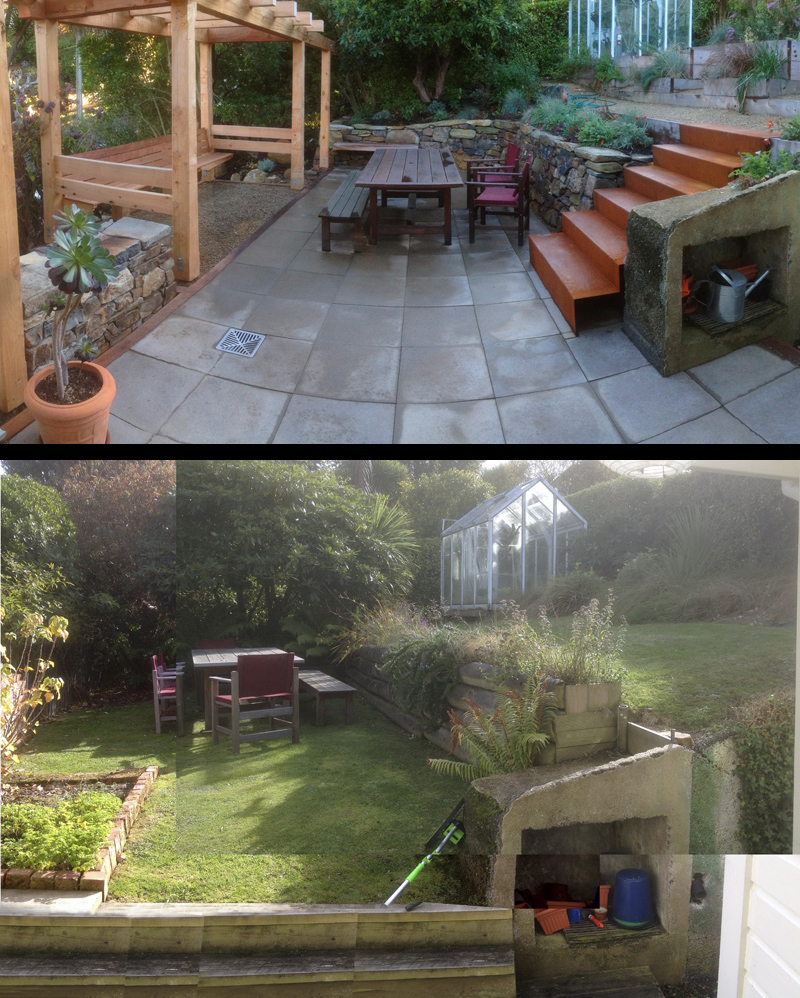

Vegetable and Herb Beds: Before (Left) and After (Right). We created these macrocara raised beds in keyhole shapes that fit into the hillside and allow easy all around access to the beds. They also give maximum garden bed area in a small space. Planted as soon as they were completed in November they have been very productive in their first summer.
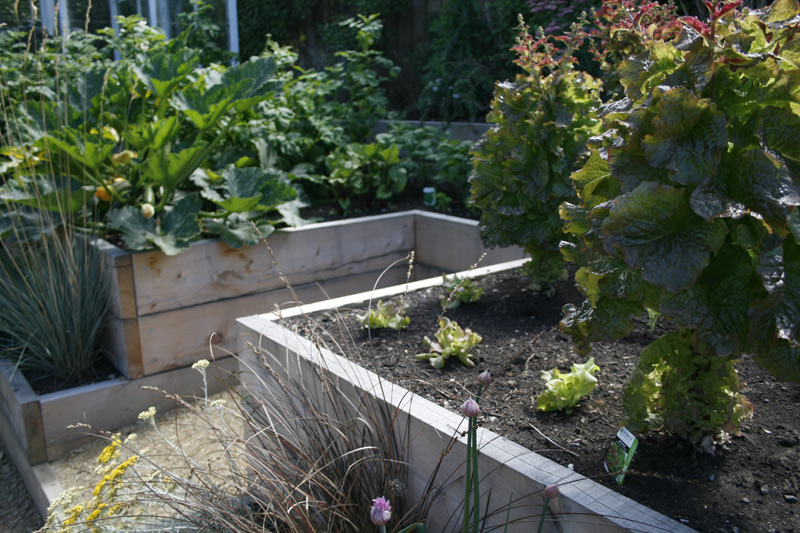
Here ornamental grasses combine with herbs, softening the front of the raised vegetable beds.
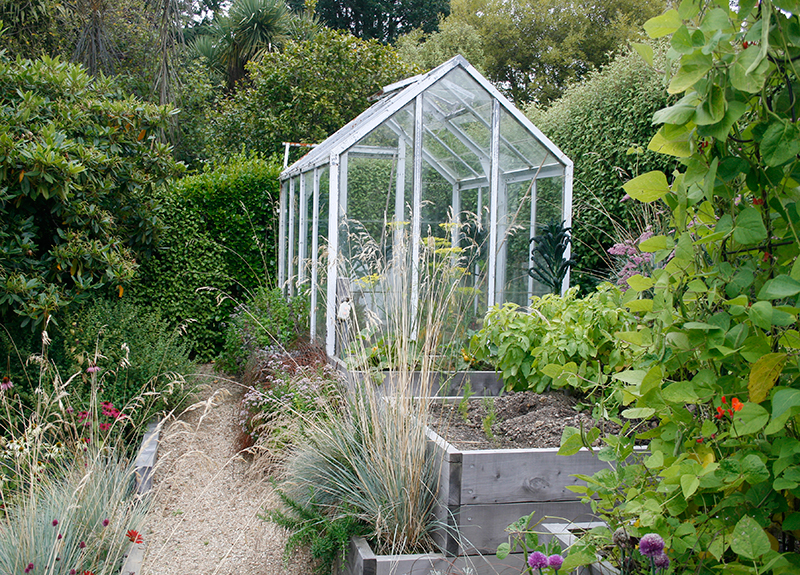
The path to the glasshouse.
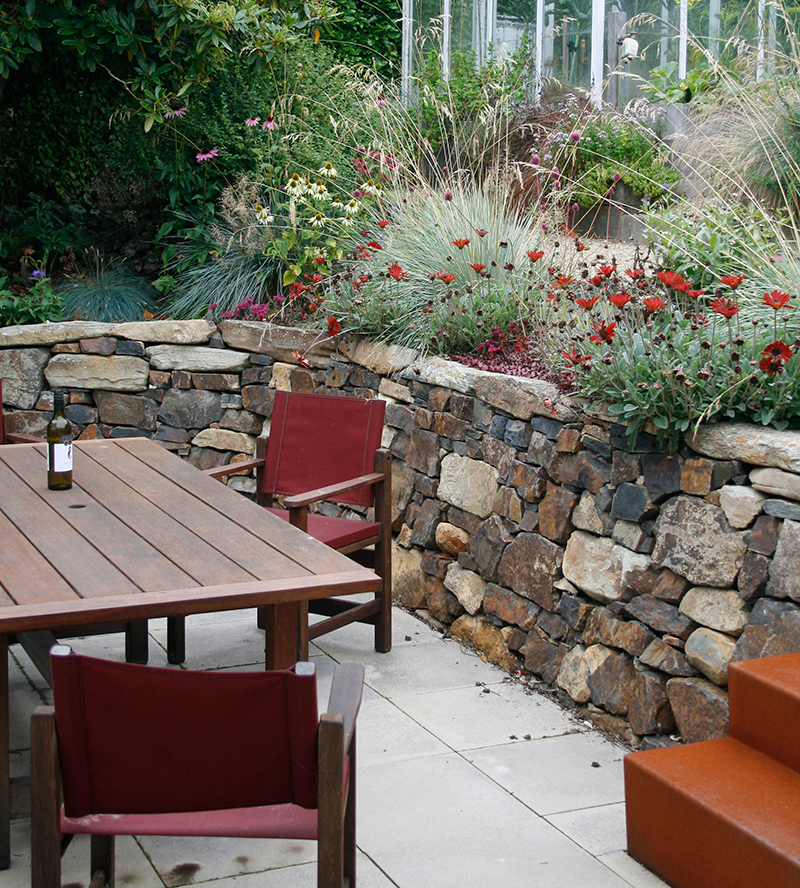
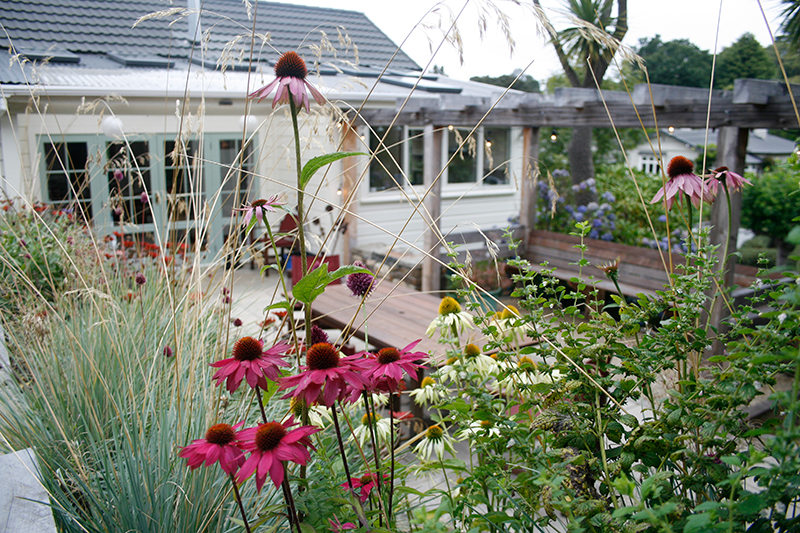
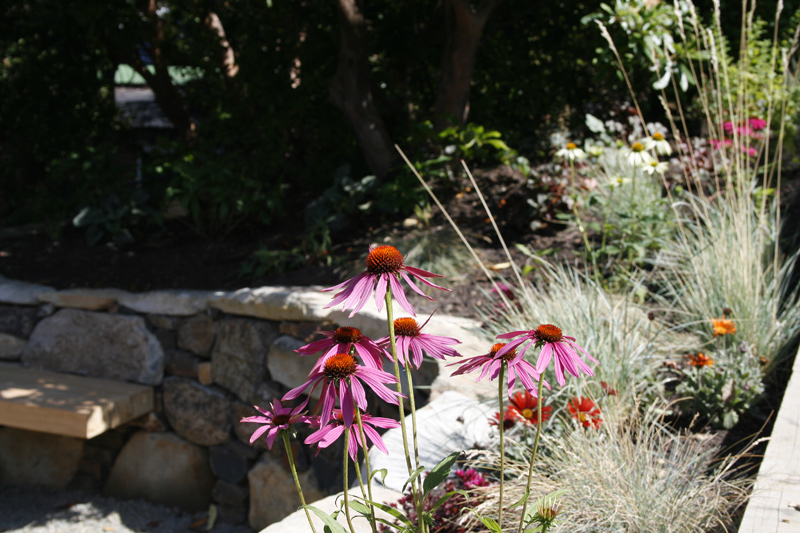
Echinacea is an exquisite North American medicinal prairie plant, it combines beautifully with ornamental grasses and is loved by bees and butterflies.
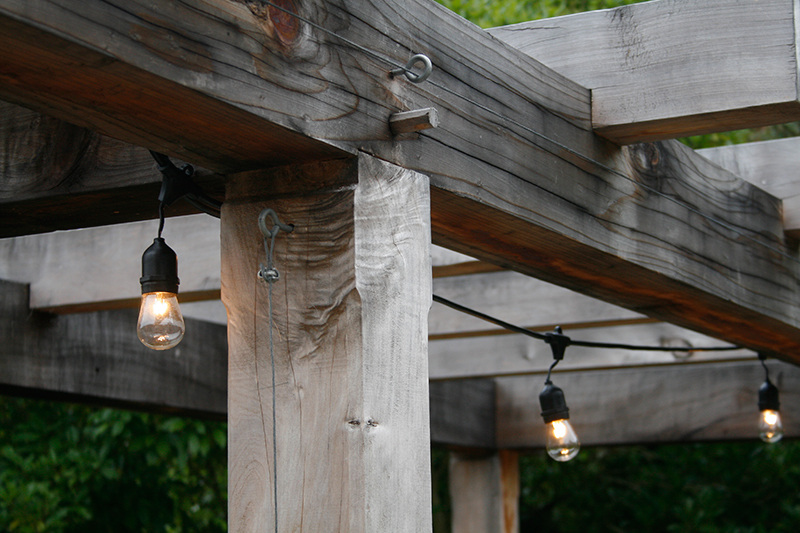
A Redwood & Macrocapa pergola with a built in bench seat provides a sense of enclosure and screening from the street.
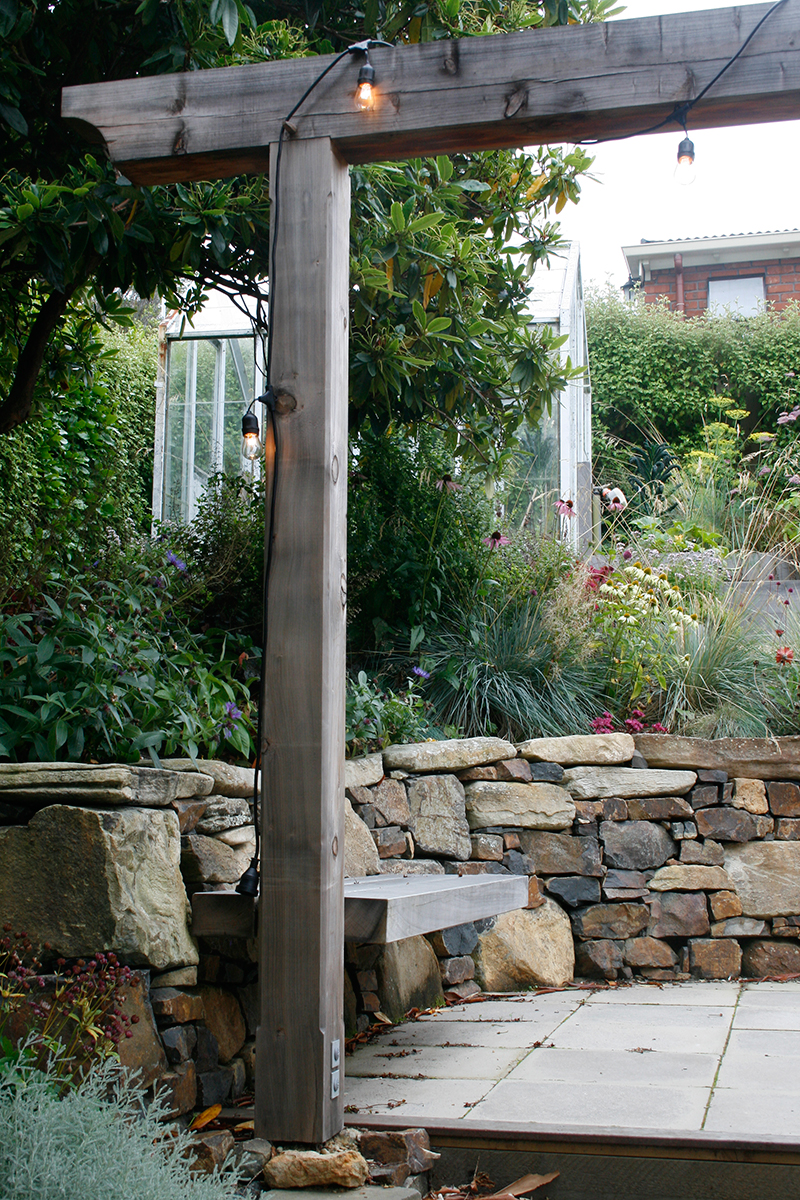
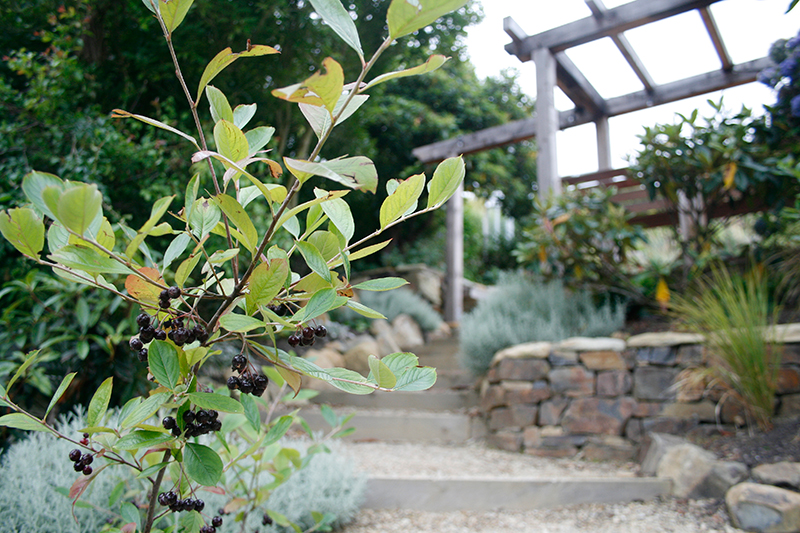
Chokeberry – delicious berries and beautiful autumn colour
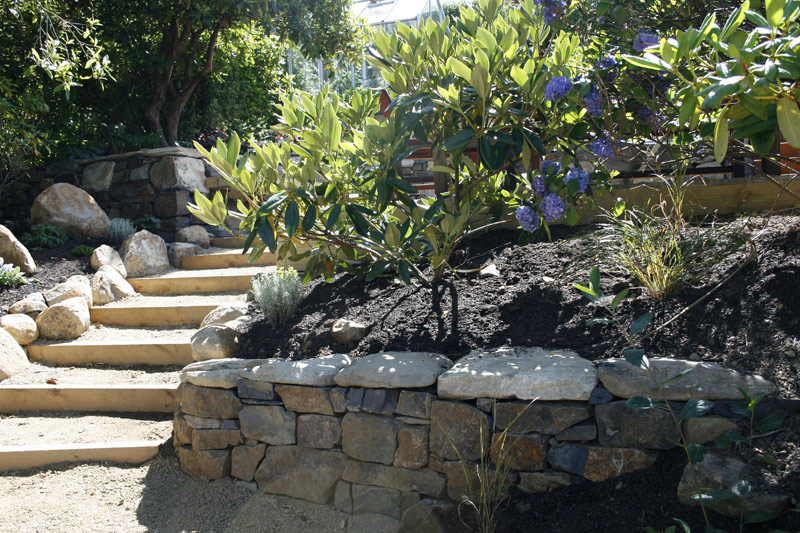
Sweeping sleeper steps between new stone walls provide a private entrance to the new courtyard. (photo at completion)
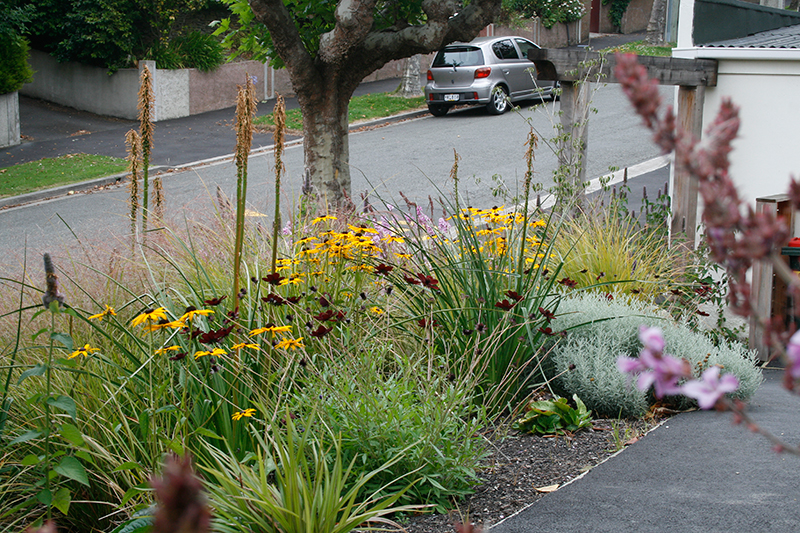
Native Rainbow grass and meadow flowers at the house entry – photo one year after planting
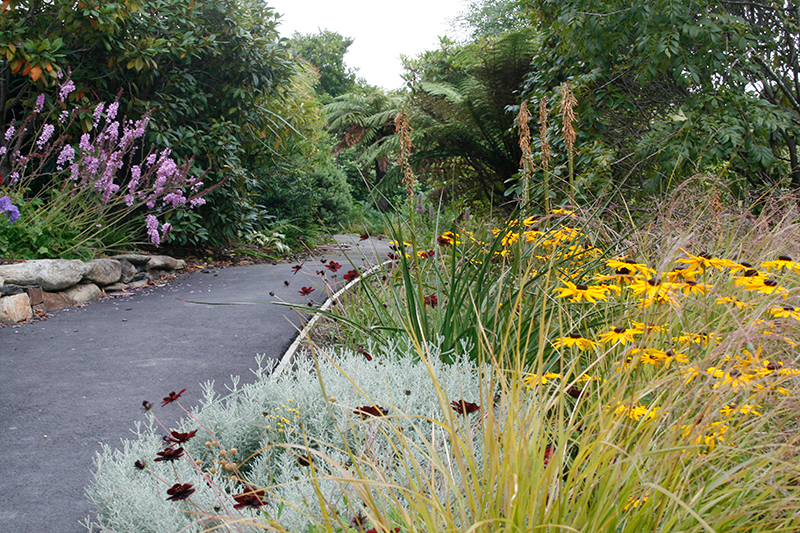
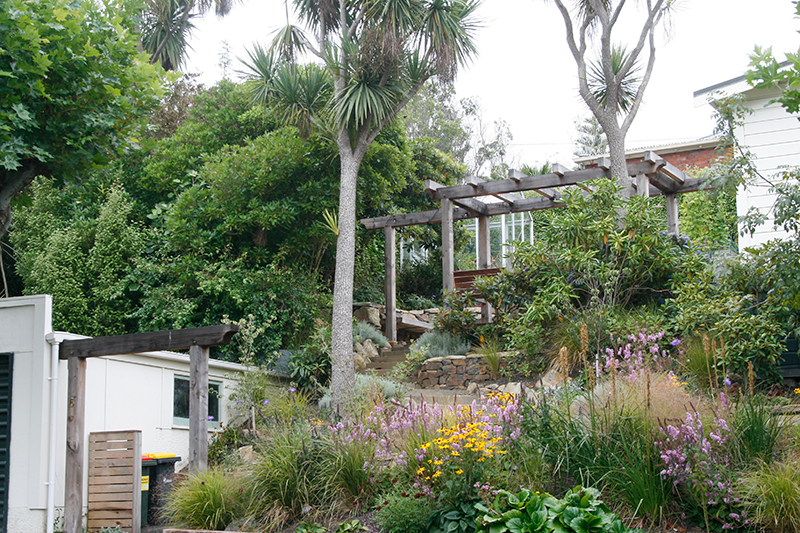
A bright and naturalistic meadow garden makes for a welcoming street frontage. Native rainbow grass is combined with rudbeckia, chocolate cosmos, red-hot pokers and anise hyssop, providing food and habitat for bees and birds.
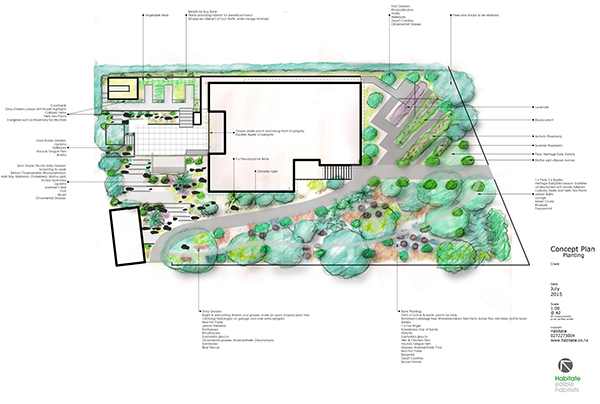
Our Concept Planting Plan
Thursday, June 25th, 2015
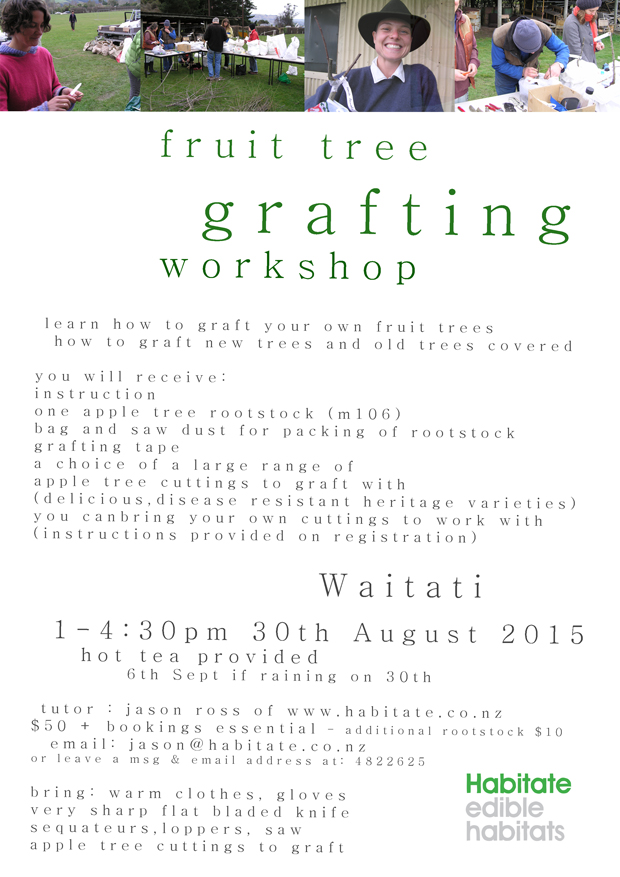
learn how to graft your own fruit trees
how to graft new trees and old trees covered
you will receive:
instruction
one apple tree rootstock (m106)
bag and saw dust for packing of rootstock
grafting tape
a choice of a large range of
apple tree cuttings to graft with
(delicious,disease resistant heritage varieties)
you canbring your own cuttings to work with
(instructions provided on registration)
hot tea provided
6th Sept if raining on 30th
tutor : jason ross of www.habitate.co.nz
or leave a msg & email address at: 4822625
bring: warm clothes, gloves
very sharp flat bladed knife
sequateurs,loppers, saw
apple tree cuttings to graft
Thursday, June 25th, 2015
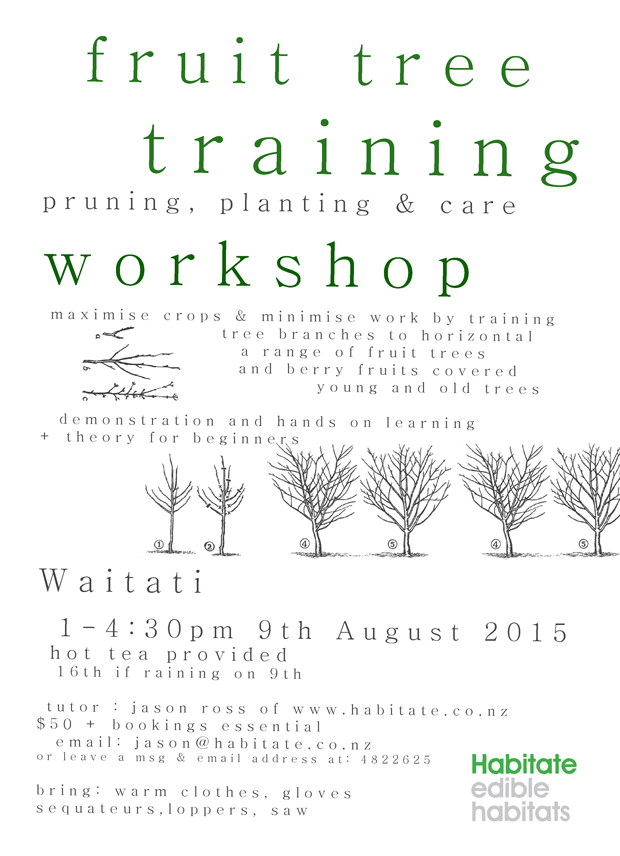
maximise crops & minimise work by training
tree branches to horizontal
a range of fruit trees
and berry fruits covered
young and old trees
demonstration and hands on learning
+ theory for beginners
hot tea provided
16th if raining on 9th
tutor : jason ross of www.habitate.co.nz
or leave a msg & email address at: 4822625
bring: warm clothes, gloves
sequateurs,loppers, saw
Wednesday, May 27th, 2015
In this article I reflect on the Beyond Organic Tour workshops we hosted in April 2015. These were led by Stefan Sobkowiak of Miracle Farms, and covered the principles and concepts used in his Permaculture Orchard.
It was a great pleasure to host Stefan at Habitate Farm for a workshop on fruit tree training and soils. Thanks to all involved for organising the tour and hosting Stefan, Doreen and James here in Dunedin.
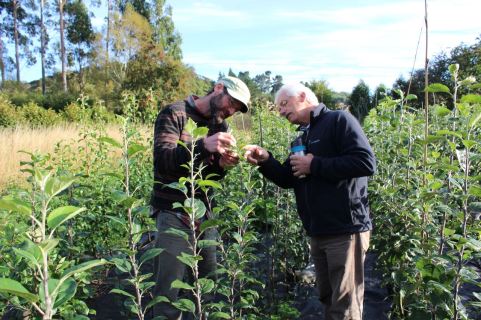 When you are busy on the land it’s a welcome inspiration to have a teacher such as Stefan come and reinforce the principles of permaculture through workshops in your bioregion.
When you are busy on the land it’s a welcome inspiration to have a teacher such as Stefan come and reinforce the principles of permaculture through workshops in your bioregion.
We need well documented examples of permaculture systems and The Permaculture Orchard is probably the best film documenting a commercial permaculture orchard.
Stefan has set up and runs an orchard that produces a quality food for a sizeable customer base.
His customers join as members, then enjoy visiting this beautiful farm, meeting each other and browsing the aisles (rows) to gather food (his is a members-only U-Pick Farm).
For me permaculture is as much about making beautiful inspiring places as it is about the quantity of food produced, so this aspect of his farm was great to see. Flowers are grown, for example, in amongst the productive plants and offered free for customers to pick, adding further delight to the diversity of edibles in each row.
What has made Stefan’s farm successful?
I would say systems design. The basis of permaculture is the conscious design of systems which overlap to form a constructed ecosystem inspired by observed natural ecologies. Stefan has clear, explainable system patterns, that allow for patterned replication and expansion across the farm. Examples are the Nitrogen Fixer-Apple-Pear/Plum trio’s, the ripening-time ordered rows, the tree to shrub to perennial planting patterns, the animal rotations through the rows, the mowing patterns and many more.
One of the great achievements is to have taken the benefits of a forest ecology (layers, diversity, predator / beneficial insect and bird habitat, pioneer / support species) and to have patterned them into a system of rows, allowing for ease of management and customer U-pick harvest (the needs of human nature).
The mulch layer
Looking to the mulch layer we find the key to what has allowed all of this to happen with minimal maintenance. A plastic mulch. A simple logical solution and yet so mind-bendingly hard to come to grips with for those of us that associate plastic with environmental degradation.
In Stefan’s system it is allowing large scale diversity and production. Stefan’s is a commercial operation,with irrigation, posts, wires and overhead sprinklers for frost fighting, there is a lot of infrastructure there, why not add a layer of plastic and be rid of untold hours of weeding and instead use that energy for establishing and harvesting the diverse and abundant produce?
There may be some good reasons. I am sceptical as to whether this system would work as well in a coastal New Zealand climate where grass and other weeds grow all year round. So many books and now movies on permaculture are from either sub-tropical or continental climates, we have to take the principles of these ideas and examples and not necessarily the techniques. I hope someone, (including myself), tests this plastic system in a coastal New Zealand climate. Unfortunately I have seen too many examples over the years of plastic or weed mat put down permanently on the ground only to be overrun with grass and buried, and then the weeds we are trying to avoid, grow back on top. I have had to remove plastic layers buried amongst ornamental gardens, tangled with roots. It’s a difficult, destructive job.
Stefan has observed worms moving organic matter through holes to underneath his plastic. In local ornamental examples that I have seen this has not happened fast enough, the garden looks brilliant for the first ten years and then plants start to decline, the soil below the plastic layer is starving for organic matter from above.
In this, his latest video, Stefan shows the difference in growth rate where plastic was not used, no competition does make a huge difference.
An alternate system that we are using for orchard/food forest establishment is based on Martin Crawford’s system of using woven weed mat.
 We put a strip of weed mat each side of a newly planted row for one or two years and then lift it and immediately plant heavily with carefully chosen varieties. The weed mat if carefully moved can be used again and again to kick start more orchard / food forest rows – perhaps a useful system up to a small commercial scale.
We put a strip of weed mat each side of a newly planted row for one or two years and then lift it and immediately plant heavily with carefully chosen varieties. The weed mat if carefully moved can be used again and again to kick start more orchard / food forest rows – perhaps a useful system up to a small commercial scale.
We have a side by side trial with a row that has support species planted and is minimally weeded and only roughly mulched. Growth in the weed matted row is at least thirty percent more after the first year.
Because of our non-stop grass growth the use of animal grazing as the primary understory layer of production has strong appeal. This limits under tree diversity but gives us important animal yields.
Training vs Pruning
I am sold on the tree training techniques that Stefan introduced us to. They are brilliantly systematic and solve many of the issues that I have had with trying to combine heading back of branches and only half training branches down. I look forward to trialling these on new trees and renovating old trees to this system.
Stefan talked a lot about autumn tree planting for good establishment of trees. This year through my nursery I am offering an earlier delivery of our certified organic bare root fruit trees (the end of June) and several customers from Stefan’s workshop have requested this. Hopefully the apple trees believe that autumn is here by then as they are still in full green leaf as I write in mid-May.
I have always pruned back my nursery trees before delivery to around one metre so that they grow strongly and branch low for my home gardener customers. I will leave them un-pruned for anyone wanting to use Stefan’s training system, if so I think you need to ensure little competition, good fertility and consistent moisture to achieve the growth and branching required. Growing Fruit Trees: Novel Concepts and Practices for Successful Care and Management covers the techniques Stefan described.
I look forward to many more well documented evolutions towards our shared vision of beautiful, diverse, productive, perennial polycultures.
Jason Ross
Link to the article on the Beyond Organic NZ Tour Website:
Friday, May 22nd, 2015
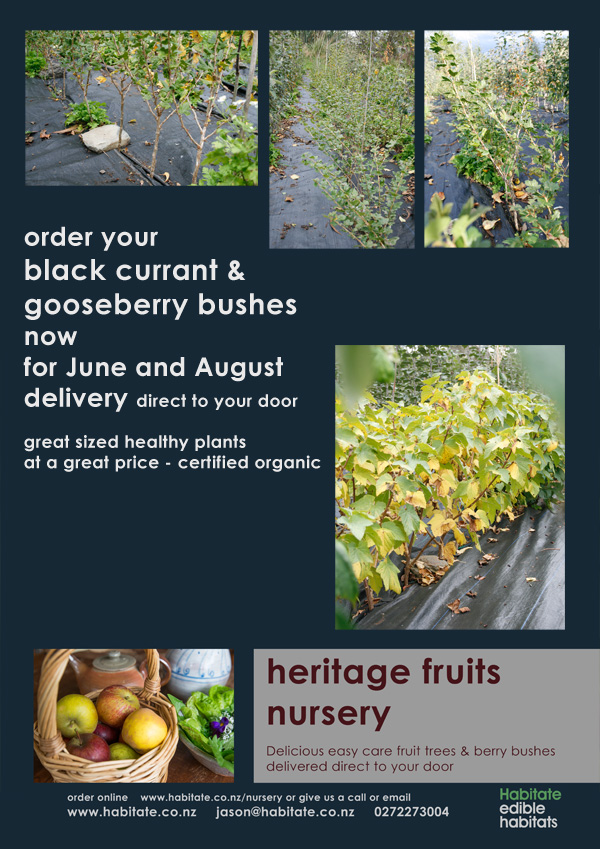
Order your black currant & gooseberry bushes online now, for june and August delivery.
Great sized healthy plants, at a great price – certified organic with Organic Farm New Zealand.
Friday, May 22nd, 2015
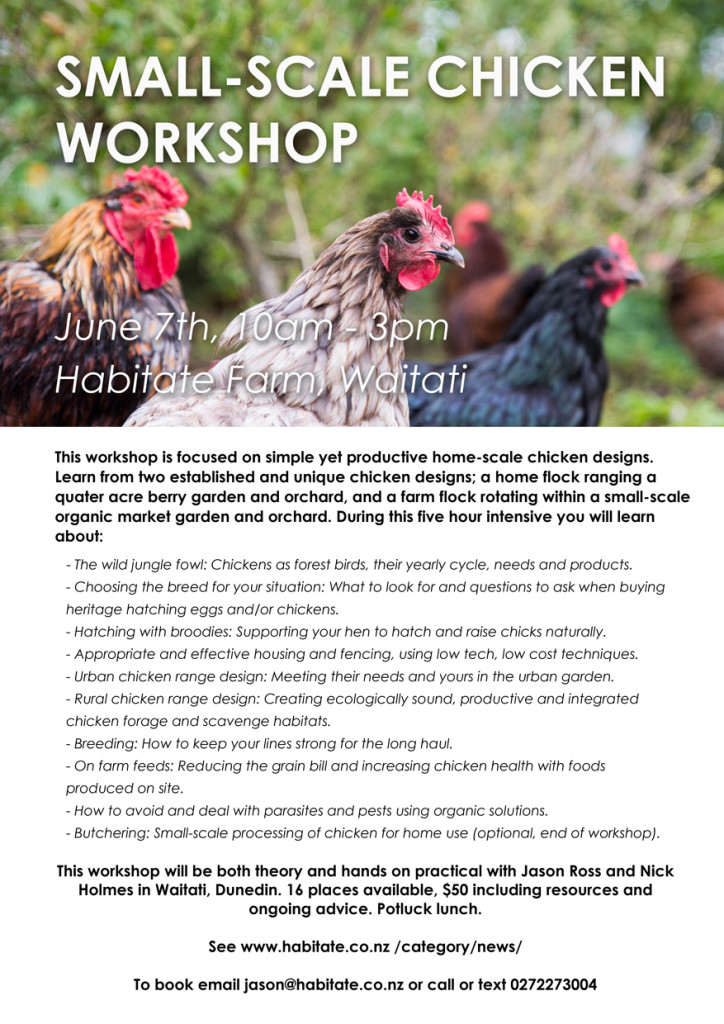 Small scale chicken keeping workshop with Nick Holmes and Jason Ross. Venue: Habitate Farm and Jason’s Home Garden. Covering chicken care and run design.
Small scale chicken keeping workshop with Nick Holmes and Jason Ross. Venue: Habitate Farm and Jason’s Home Garden. Covering chicken care and run design.
Monday, March 2nd, 2015
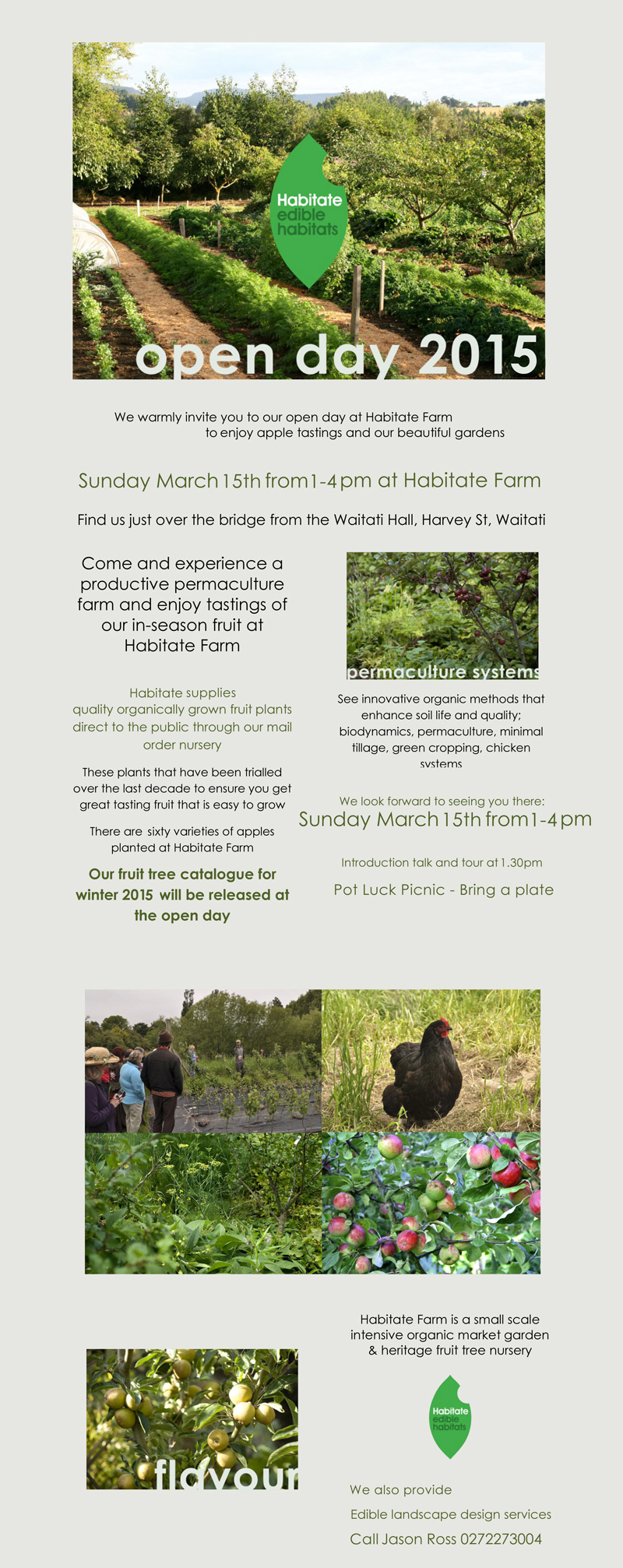
Monday, March 2nd, 2015
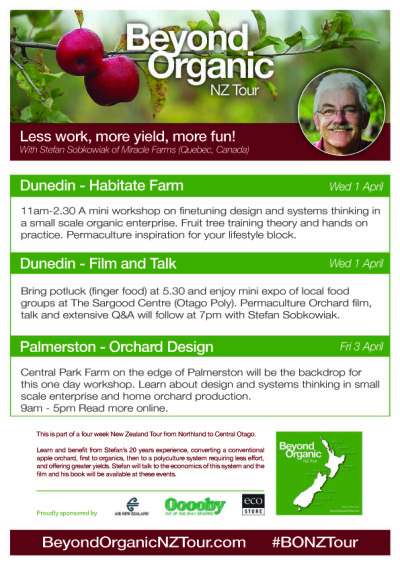
Internationally recognised speaker and orchardist Stefan Sobkowiak is visiting New Zealand from Canada.
An extensive calendar of 20 events has been created, from Northland to Central Otago.
Twenty years ago Stefan bought a conventional Apple orchard outside of Quebec and over the next few years converted it to organics. Seven years ago he re-designed the orchard using permaculture principles while maintaining the commercial focus. Many people are experimenting with permaculture but Stefan is one of the few who is earning his living from a permaculture property. Last year a feature length documentary “The Permaculture Orchard” was released about Stefan and his orchard, Miracle Farms.
From March 11th to April 5th 2015 he is travelling from Northland to Central Otago leading a series of talks and workshops as part of the Beyond Organic NZ Tour. This is an opportunity to learn how these productive, profitable, permaculture-inspired practices work.
To book / register please go to calendar of 20 events
Thursday, December 4th, 2014
This wall chart is invaluable to home vegetable growers. It provides a quick reference guide to sowing and planting throughout the year. Rotation, succession, frost, glasshouse and perennial vegetable information is also presented. The information is specifically tailored to Coastal Otago and Southlands’ unique climate.
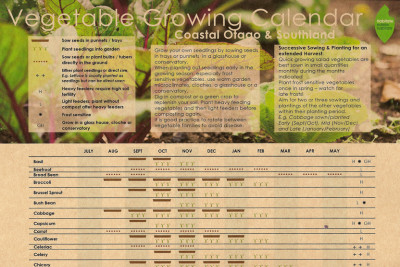
A3 size (28.5×40.5cm) in portrait orientation, printed on sturdy long lasting card. (The illustration is cropped and not to scale).
Designed, researched and trialed by Jason Ross BFA, Nat.Cert.Advanced Production Horticulture.
Brydone Wholefoods –
Blueskin Nurseries – Waitati
Taste Nature – High st, Dunedin
South Coast Environment Centre – Palmerston Street, Riverton
If you are a retailer and would like to stock these please contact us: jason@habitate.co.nz
Tuesday, November 4th, 2014
Commercial Horticulture magazine October/November 2014 by Trish Hosking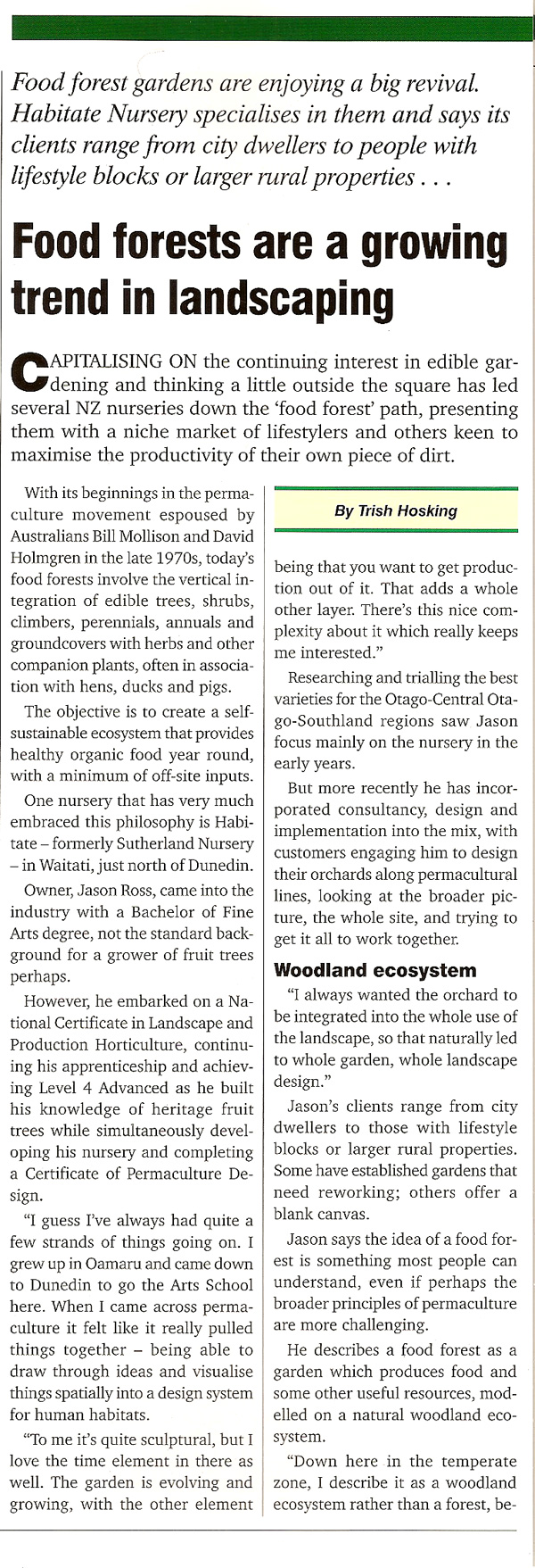
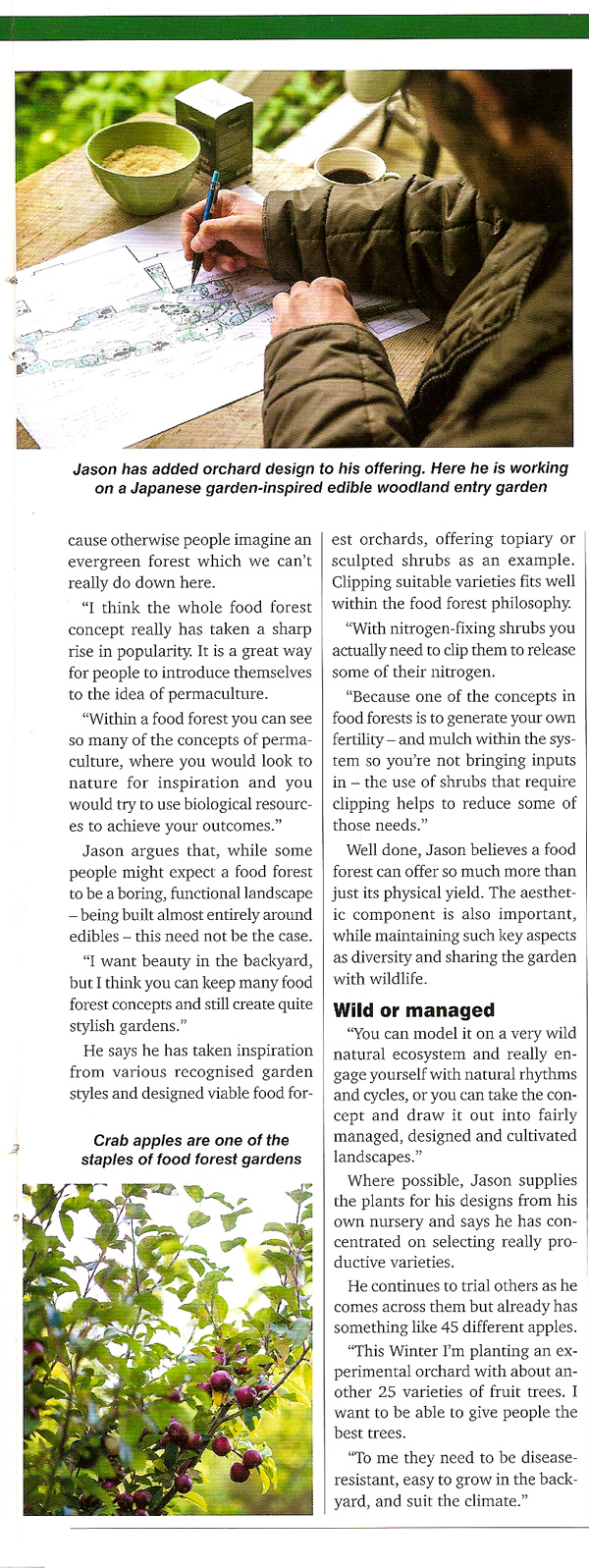
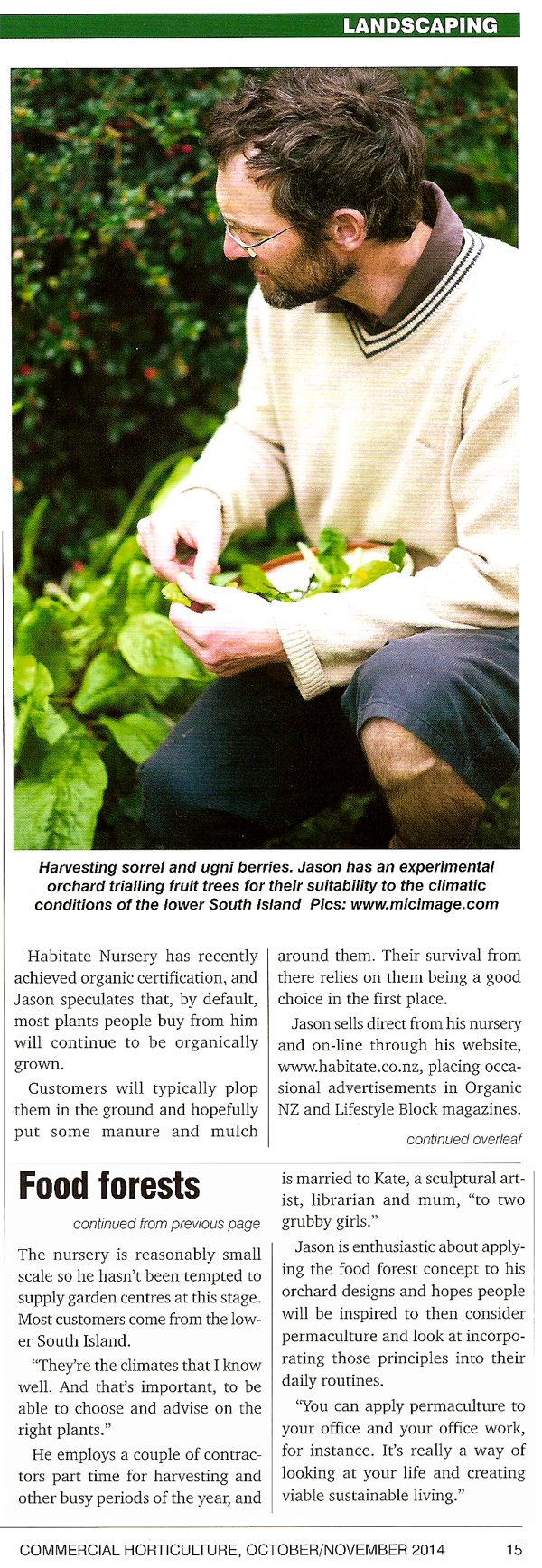
Monday, November 3rd, 2014
This dunedin family has a long term vision for their small city garden: to set in place strong foundations for a abundant and enjoyable landscape that is long lasting and resilient.
The resulting design that we completed in 2013 for the whole section (both hard landscaping and a planting plan) includes a native garden for birds, a courtyard surrounded by herbs, a sturdy glasshouse and vegetable gardens integrated with fruit trees.
This project is a good example of the benefits of a staged installation where instead of having to get everything done at once we have been able to:
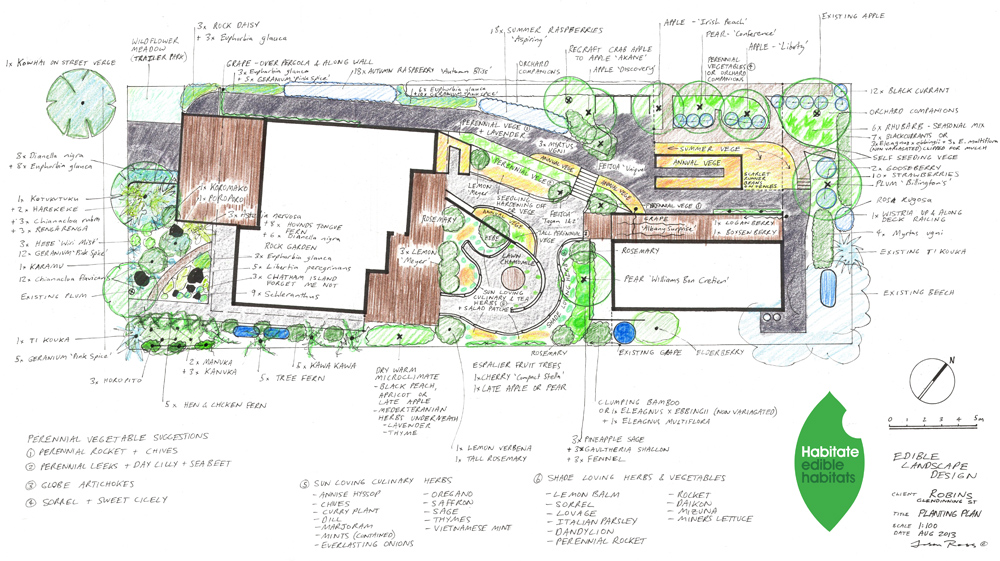
Resilient City Garden Landscape Design – 2013
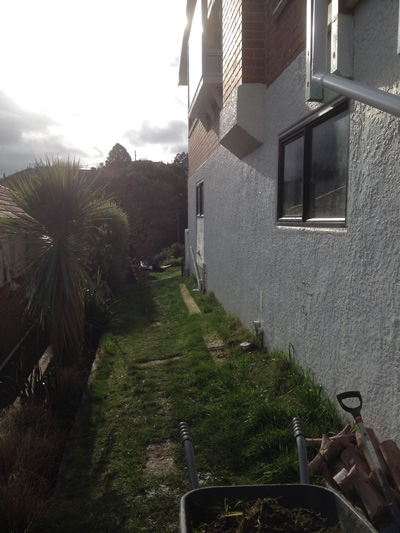
BEFORE – Slippery, access to the back gardens and sleep out
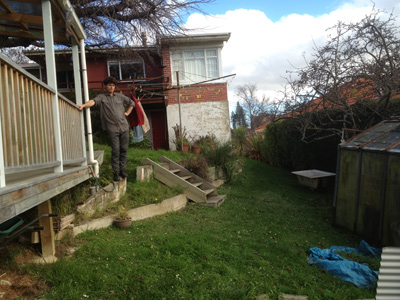
BEFORE – Sloping grass and rusting glasshouse
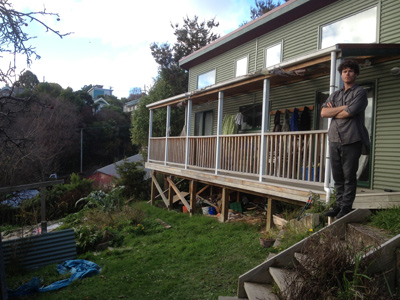
BEFORE – A sunny area with good microclimate
Winter 2014 we started intstallation of the garden. To enhance a narrow and neglected but sunny side of the house we created a wide spaced pergola that will support three varieties of grapes. Also enclosing the narrow walk are summer and autumn raspberries. A central path and glass house went in first as good access was needed to the back section and these also act to define the garden spaces around them.
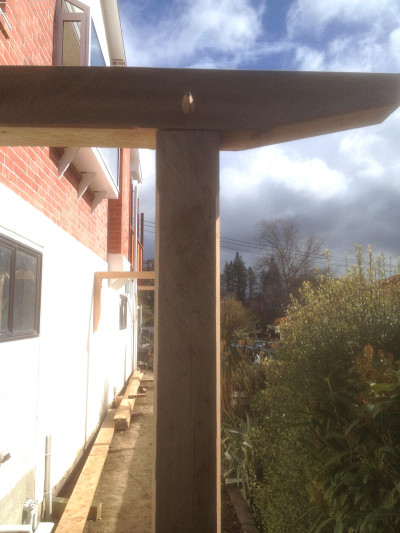
Grape pergola constructed using mortise and tenon wooden pegged joinery by Man Tamang
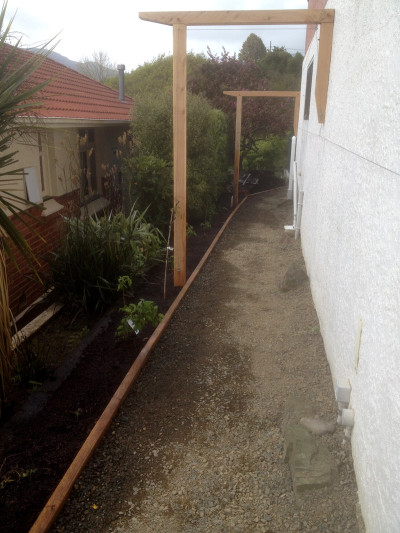
Three varieties of grapes will grow over the pergola and down onto the sunny wall for easy picking
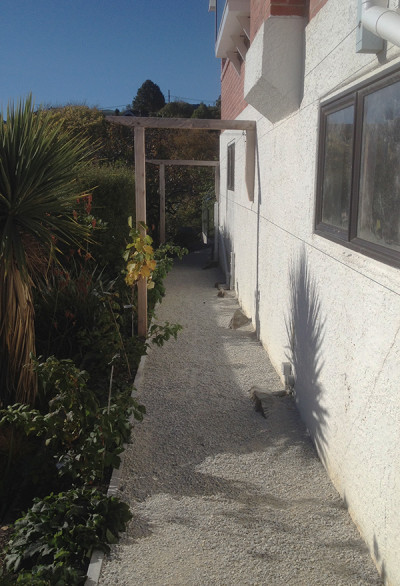
Grape & Raspberry alley – 2016
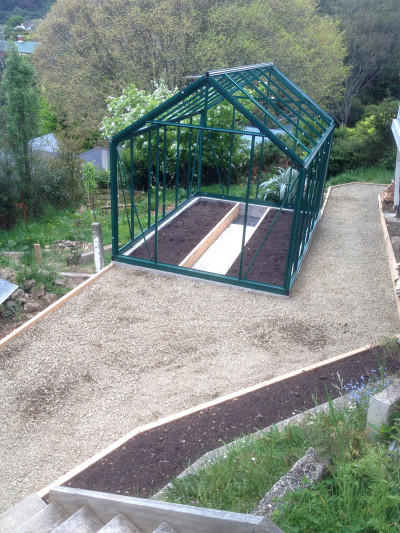
The new glasshouse awaits its glass, the paths a finishing layer of self binding lime chip and the gardens, seeds and seedlings…
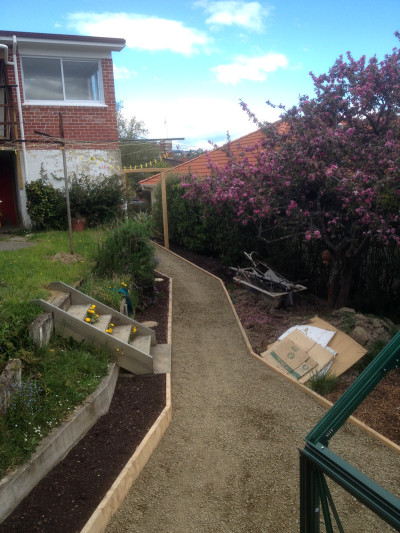
Beautiful, local, durable macrocapa edging is used throughout. Macrocapa will not contaminate the sourounding soil where food plants will be grown
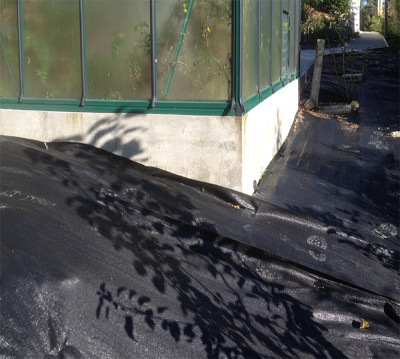
Weedmatting on the soil surface for one year to kill weeds
In spring 2016 we installed terraces on the sunny side of the main house for kitchen herbs and vegetables. We installed a retractable clothes line with recycled paving from on-site. Areas infested with couch weed were mulched with a biodegradable weed barrier (newspaper) and composted and mulched. We planted what we could at this time, more will be planted in winter.
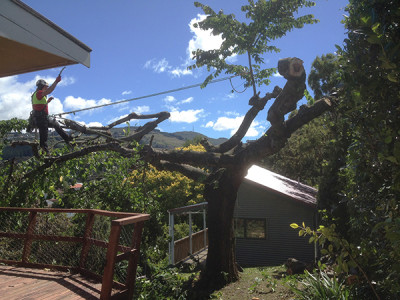
This Elm was a long time family favourite. But too big for its space, shading the house and proposed garden it had to go. It as sensitively removed by Onmi Tree and milled for a kitchen table and for garden bed edging
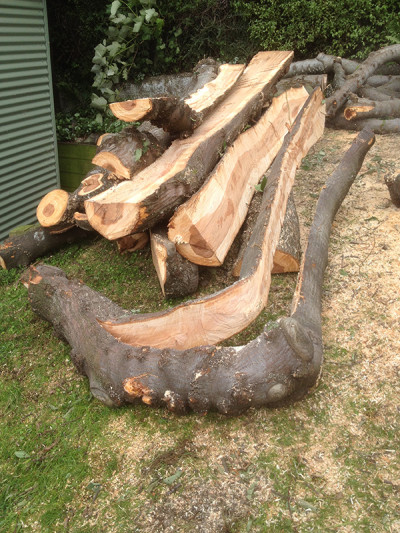
Unique curved Elm half rounds were milled on site by Jelte from Omni Tree for use as terracing
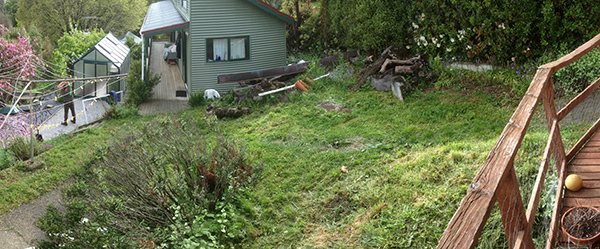
BEFORE – Terrace Garden
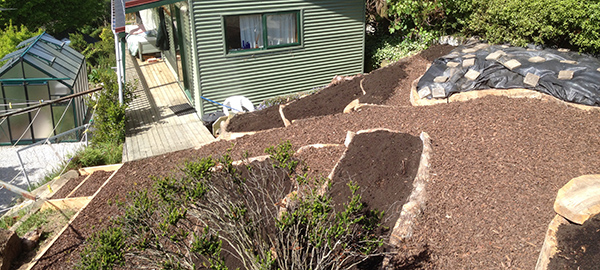
Terrace beds before planting
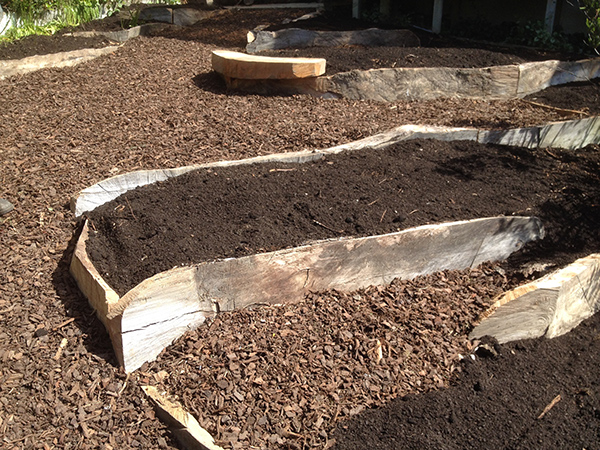
Elm half round terrace garden beds and seating – Utilising on site resources for unique and beautiful results
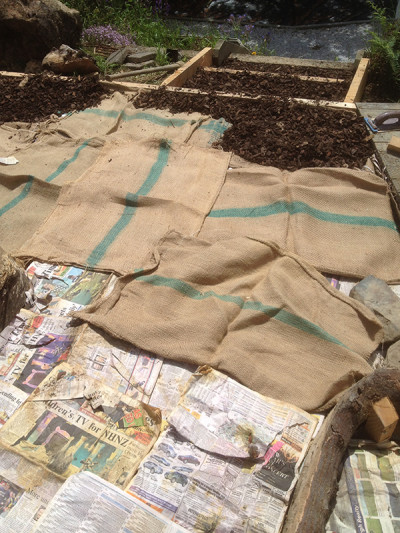
Path mulching – newspaper and sacking under bark chip, a biodegradable weed barrier and path stabiliser
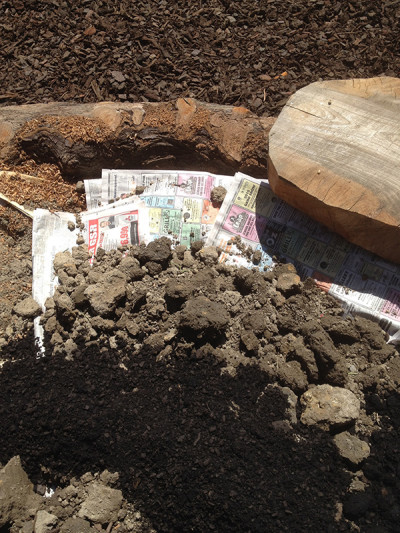
Newspaper weed barrier used under vegetable beds, saving on digging and weed removal
Monday, November 3rd, 2014
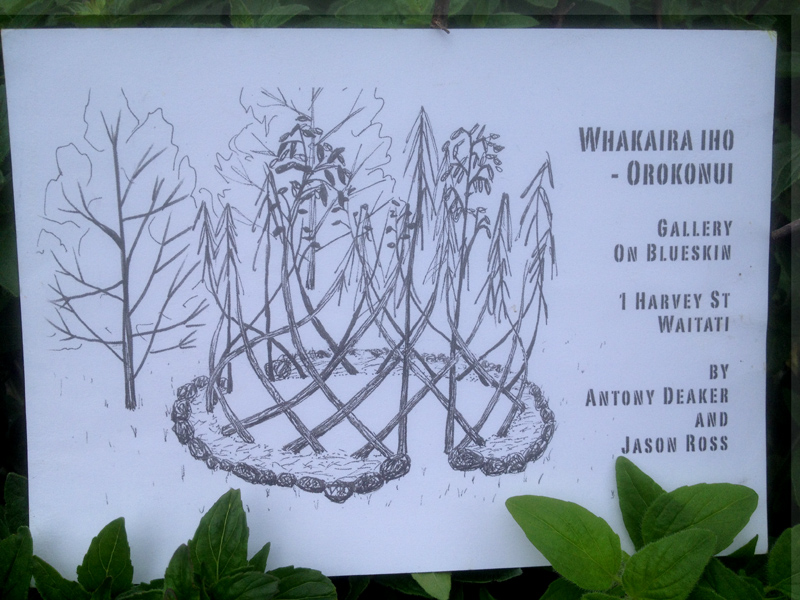
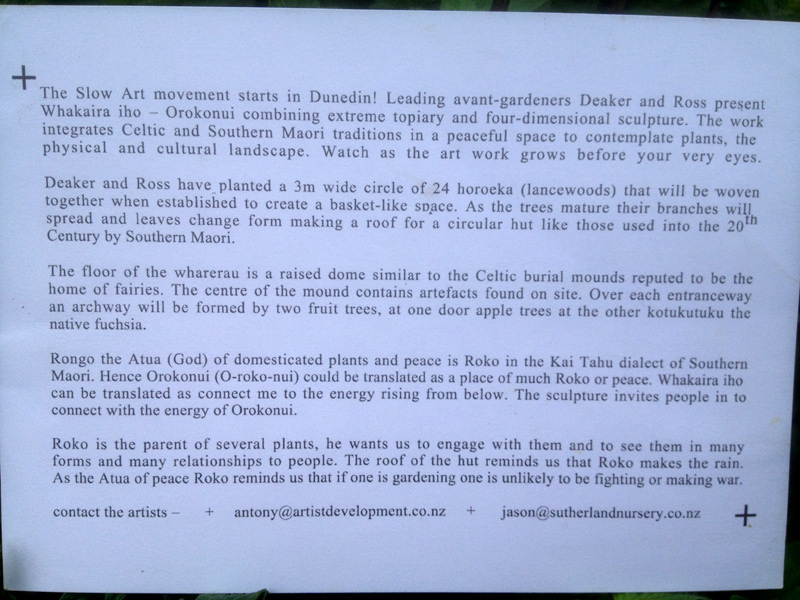
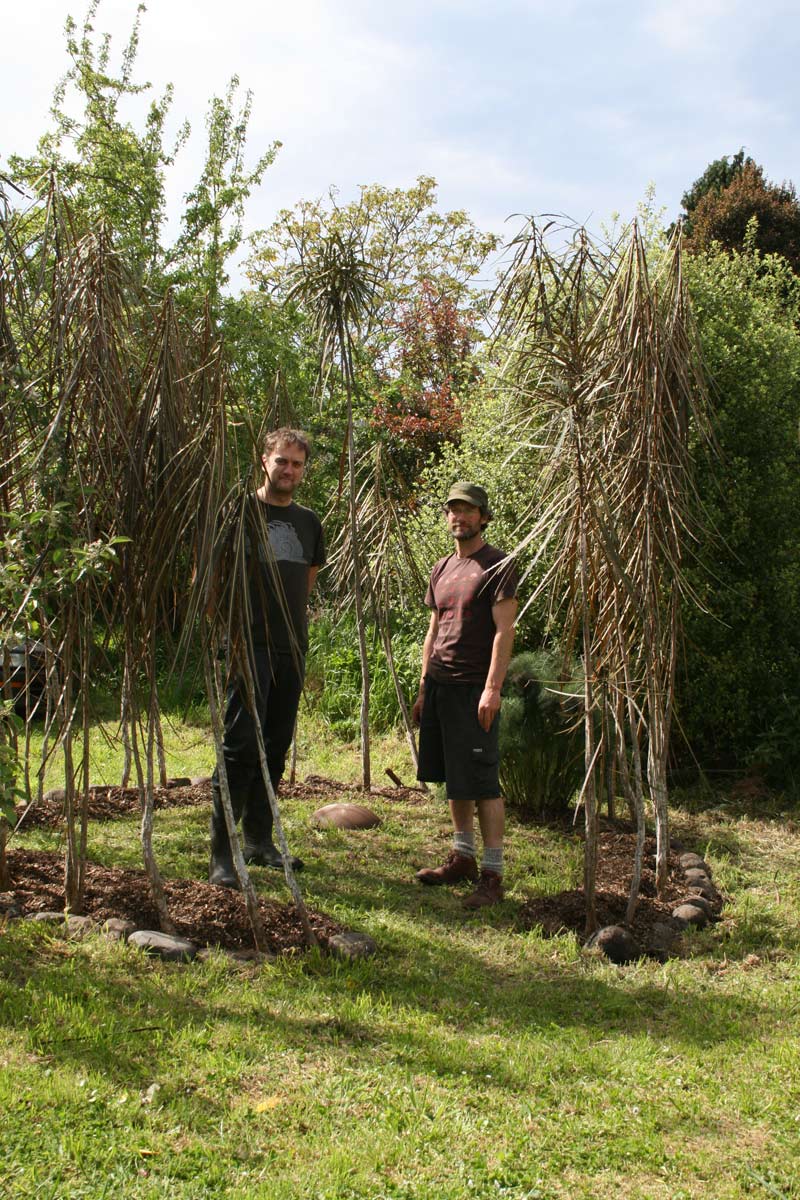
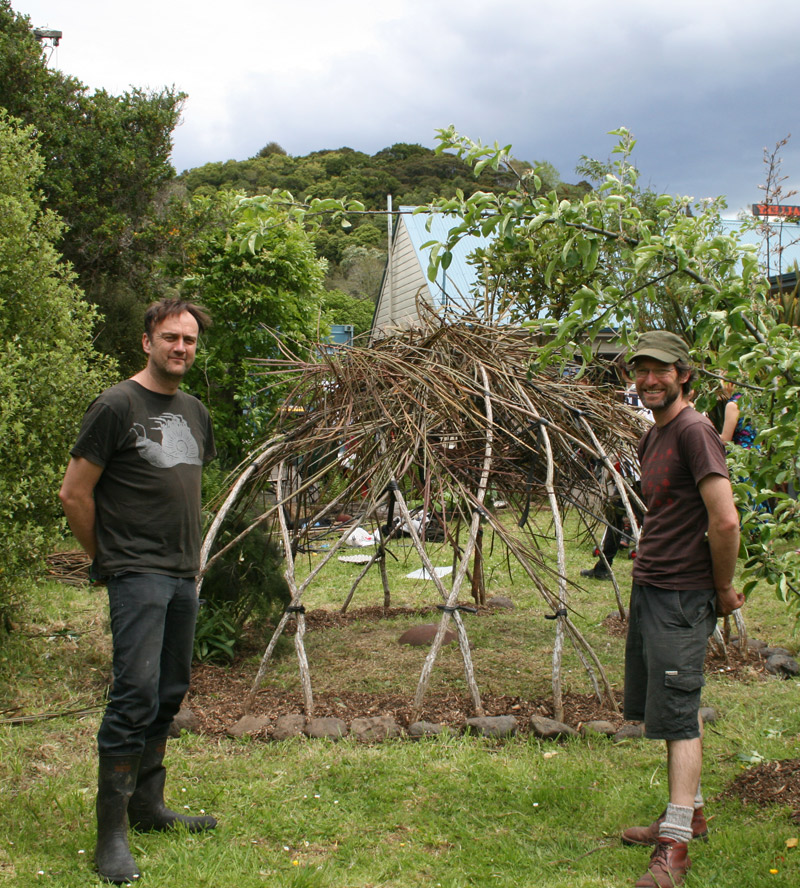
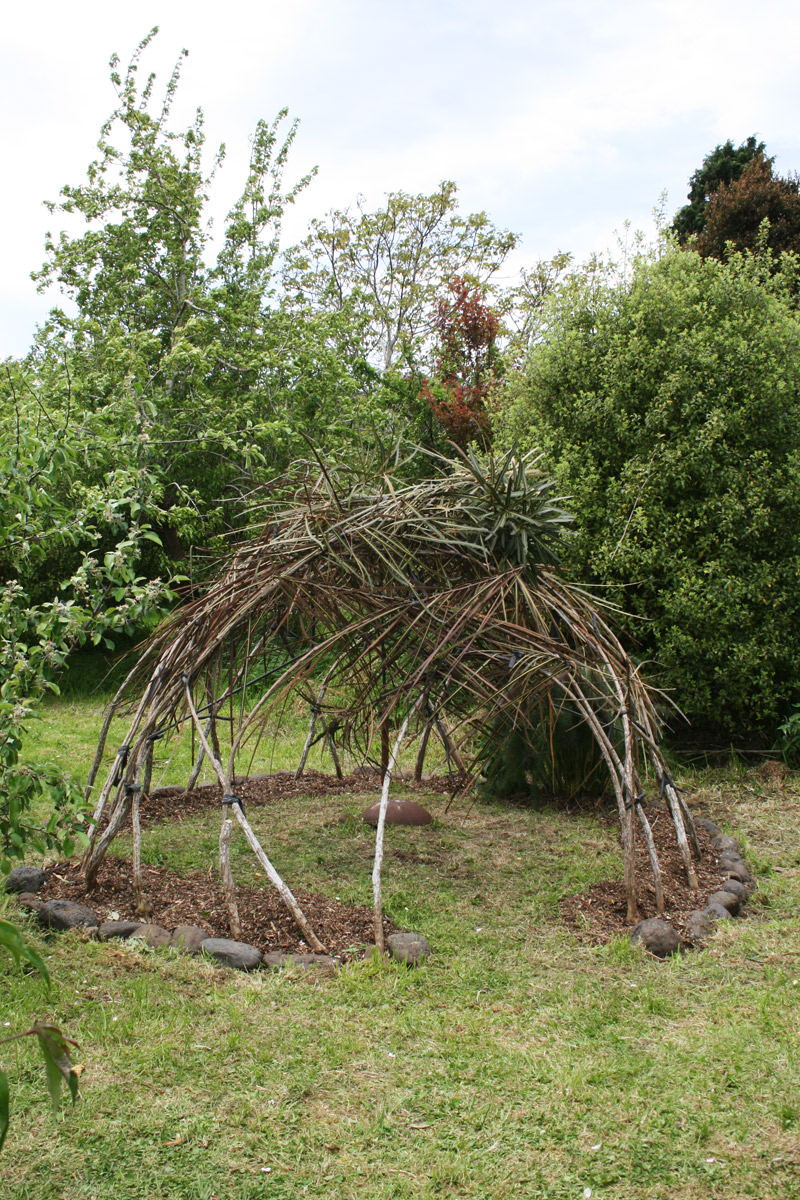
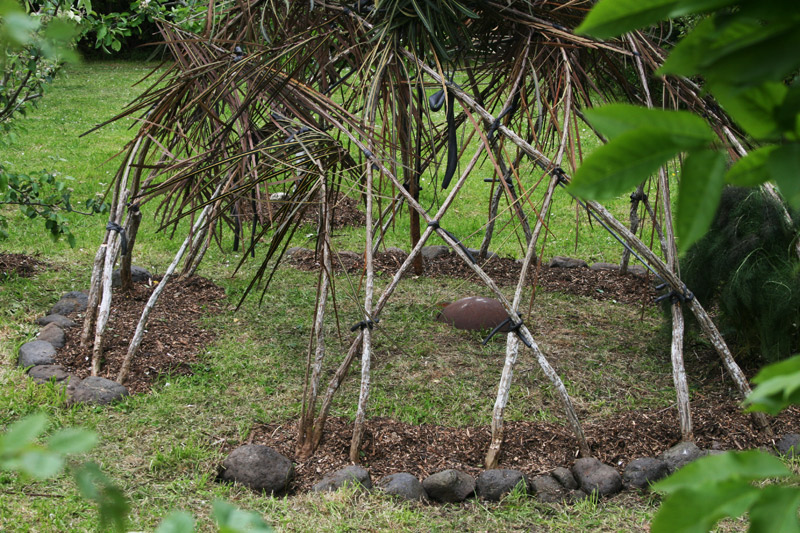 Planted in 2010 as part of the Dunedin Fringe festival events this living tree sculpture can be experienced during opening hours of Gallery on Blueskin in Waitati, be in quick, it will never be the same again.
Planted in 2010 as part of the Dunedin Fringe festival events this living tree sculpture can be experienced during opening hours of Gallery on Blueskin in Waitati, be in quick, it will never be the same again.
In November 2014 at the Waitati Market the trees were successfully woven, we look forward to what happens next.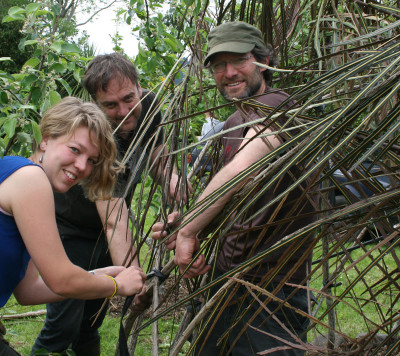
Thanks to Eveline Mimpen and others who spontaneously joined in the weaving
Monday, September 29th, 2014
Dunedin’s new arts, culture and lifestyle magazine is going to have regular articles about permaculture.
The first issue includes a piece about what we do here at Habitate, and another about Dunedin’s ‘Our Food Network’ as well as plenty more…
Thursday, August 7th, 2014
Last year we had a great day and were able to work outside, I hope to see you there this year.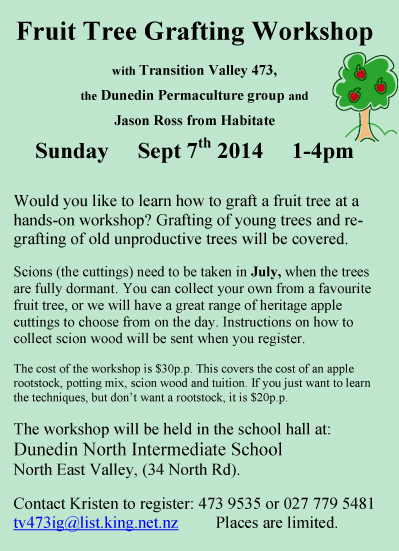
Tuesday, July 29th, 2014
We are planting a new orchard at Habitate Farm this winter – August 2014
The orchard utilises systems design based on beneficial features of natural woodland ecosystems, to create a productive orchard that produced its own fertility and is climate and pest resilient. It shares many features of food forest design but utilises structured pattern design for ease of management.
It will contain around 25 fruit trees and 20 companion trees and shrubs in an area of around 100m2.
The Layout is of four rows running north south.
Row 1 is a permanent raspberry row from which fruit and divisions will be harvested.
Row 2 is a mixed fruit tree row with support trees, shrubs and herbs
Row 3 is a row of support trees, shrubs and herbs which will be pruned for mulch and nitrogen release to the rows either side
Row 4 is a mixed fruit tree row with support trees, shrubs and herbs
The land is flat, silty river flats. Our climate is Coastal temperate where winters are mild and summers are cooled by coastal breezes. Our median summer air temperature is 14 C and our median winter air temperature is around 6 C. Our annual growing degree days (Base 10 C) are around 450. Median frost free period is 250 days. We receive around 900mm of rain fairly well spread throughout the year. So for fruit growing our limiting factor is summer heat. Our best crops come from temperate berries, apples (a huge diversity of), pears and plums.
The layout and permaculture systems design for this orchard are experimental but have strong and diverse production goals – it has to be viable as a prodcutive element of our farm.
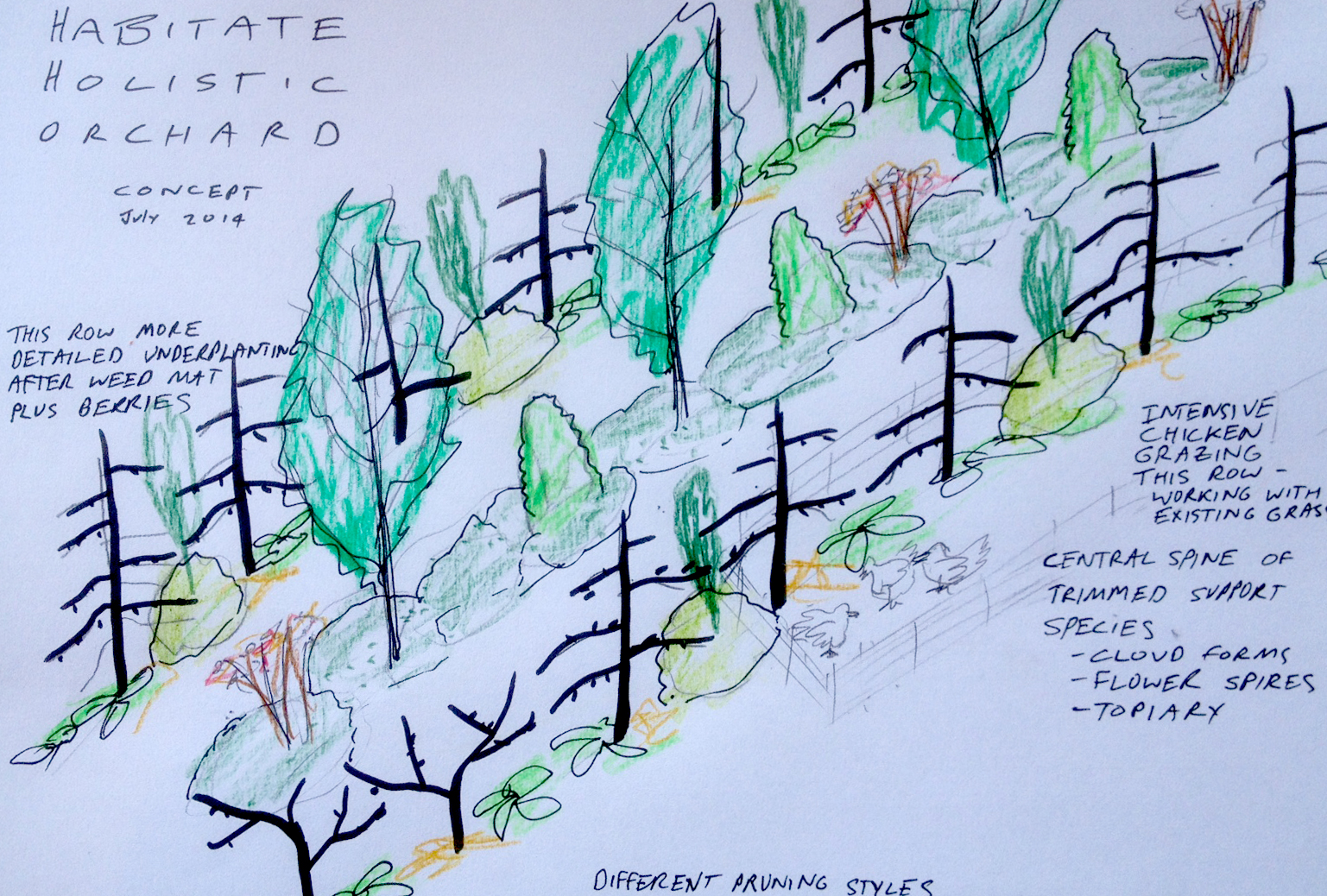
The orchard aims to:
Cropping: Raspberries, Apples, Pears, Peaches
Support / Mulch Trees: Alder (Alnus cordata), Tree Medic, Elderberry
Support / Mulch Shrubs: Elaeagnus ebbingii
Support / Mulch Herbs: Comfrey (Symphytum x Uplandicum and S. Ibericum), Cardoon, Sweet Cicely, Lovage, Feverfew, Nasturtium
Want to get involved? We will have further work days on the orchard as it evolves.
We had some cold South West winds but the day warmed up to allow us to eat lunch outside on the cottage deck.
There was a lot of great discussion and inputs of ideas to the orchard also.
Habitate Farm is an opportunity to have a go at putting into action all of our visions of rich living soils and diverse integrated plantings.
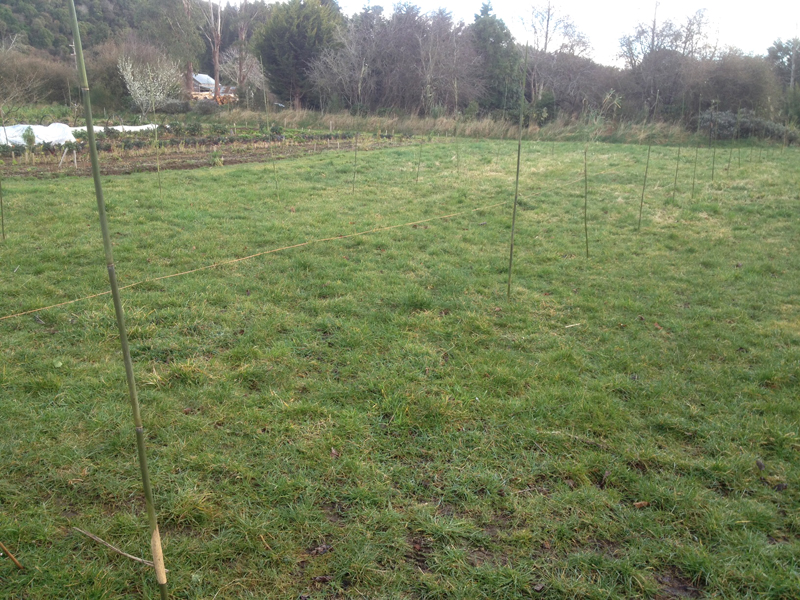
Marking out the two meter spacing for the fruit trees, to the left is the organic market garden
Twelve of us planted 22 fruit trees, 8 raspberry shrubs, 22 support species trees and shrubs, 39 chunky Russian Comfrey divisions, and 39 Dwarf Comfrey plants. And had a long and delicious lunch!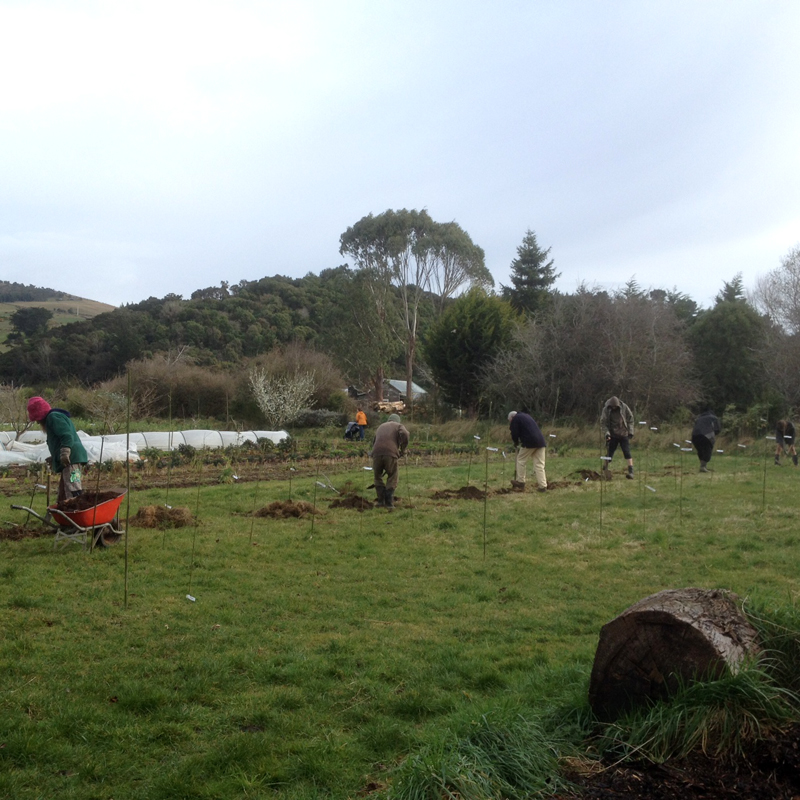
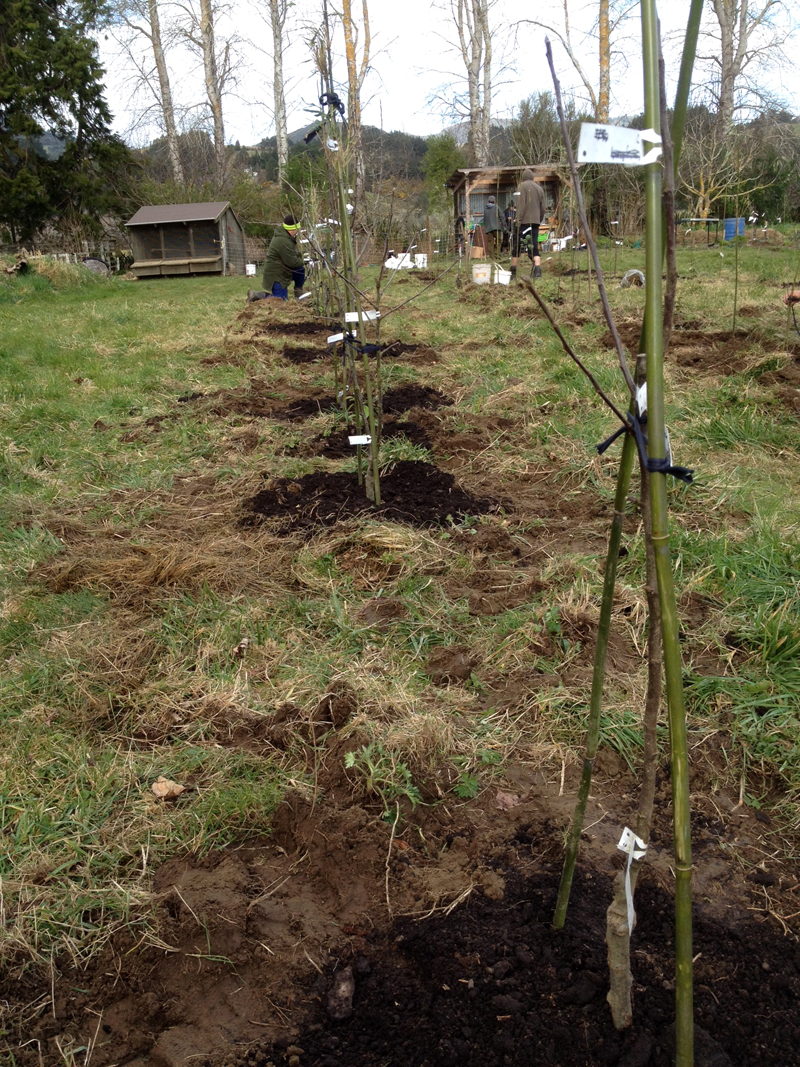
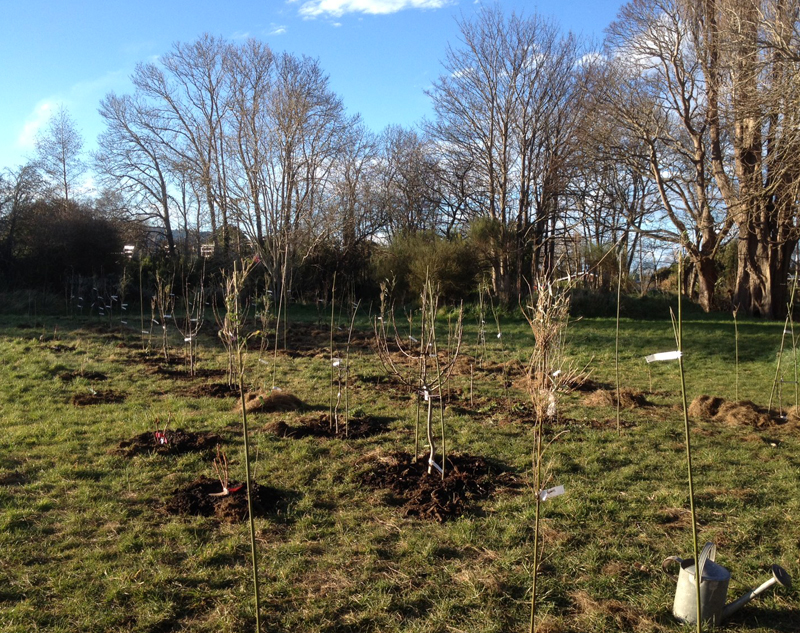
The low end of day sun blesses the new orchard. We also had beautiful little pure black Piwakawaka flitting around us during the planting. I think the birds are going to appreciate this orchard too.
Monday, June 23rd, 2014
Jason shares his deep understanding of FRUIT TREE PRUNING on the Eco Living in Action radio show, originally aired on 12 July 2012 on Otago Access Radio 105.4FM. You can listen to the podcast at http://www.accessradio.org/media/download/201406161057381402873058-32k-2012-07-12—Eco-Living-In-Action-Show—Backyard-Biodiversity.mp3?_uid=1402872917-838-13
Maureen Howard hosts a 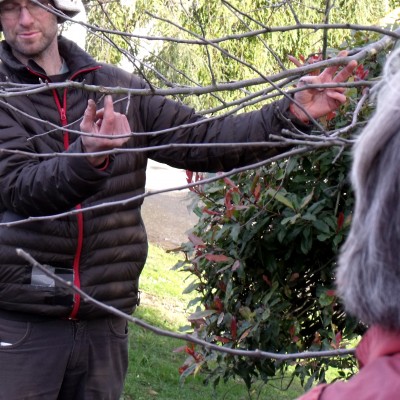 half-hour sustainable living radio show called Eco Living in Action that is aired on Otago Access Radio 105.4FM every Thursday from 2.30pm -3pm.
half-hour sustainable living radio show called Eco Living in Action that is aired on Otago Access Radio 105.4FM every Thursday from 2.30pm -3pm.
From making your own cleaning products to composting, recycling, keeping chooks and reducing your carbon footprint, Maureen and her guests will inspire you with practical, everyday solutions that make a difference.
To listen to previous podcasts or to listen to the radio station online go to http://www.oar.org.nz
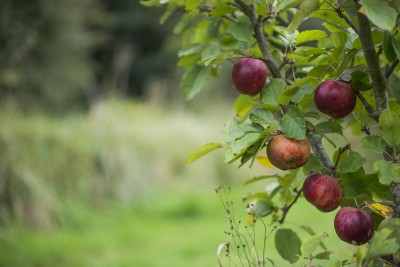 Maureen is a fantastic sustainable living educator. She is contracted to the Dunedin City Council to provide information to the community on waste minimisation and sustainable living www.dunedin.govt.nz/services/sustainability-education/sustainable-living
Maureen is a fantastic sustainable living educator. She is contracted to the Dunedin City Council to provide information to the community on waste minimisation and sustainable living www.dunedin.govt.nz/services/sustainability-education/sustainable-living
For more information about what Maureen does, please contact Maureen by email mhoward@slingshot.co.nz
Thursday, June 5th, 2014
The main entry path to these enthusiastic and playful food growers home plows straight through the best growing area on the property. In this design a combination of beautiful ‘welcome home’ gardens, structural and functional evergreen shrubs are employed to keep the entry a pleasure to arrive home to while also offering glimpses of the delicious fresh food growing in raised beds close behind.
Beauty, aesthetics, outdoor living spaces and yes even lawns are important aspects of creating successful permacuture gardens. Because the more time we spend outside enjoying our gardens the more we will also use and harvest from the edible plantings.
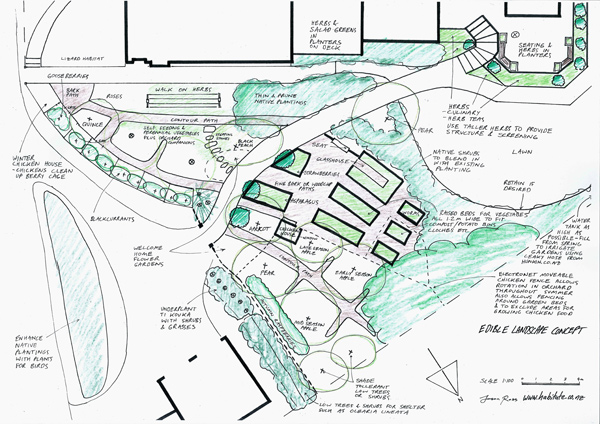
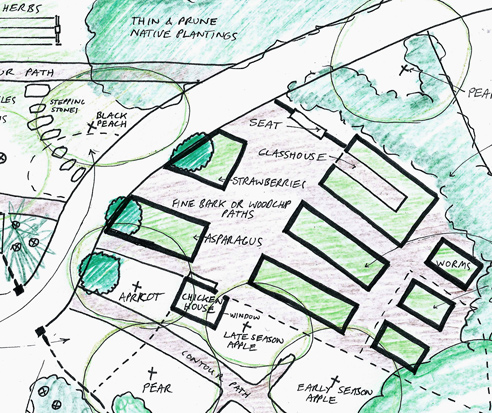 A moveable chicken fence system was settled on, allowing rotation of the chickens through orchard and berry areas, for benefit of both. Chickens will provide maintenance, fertility and eggs, while tilling areas of garden in which some of their own food will be grown seasonally.
A moveable chicken fence system was settled on, allowing rotation of the chickens through orchard and berry areas, for benefit of both. Chickens will provide maintenance, fertility and eggs, while tilling areas of garden in which some of their own food will be grown seasonally.
Wednesday, June 4th, 2014
and don’t forget to include the clothes line and the kids trampoline!
These were just some of the features that I recently helped a busy young family work into an edible landscape plan for their very steep six hundred square metre section in Port Chalmers.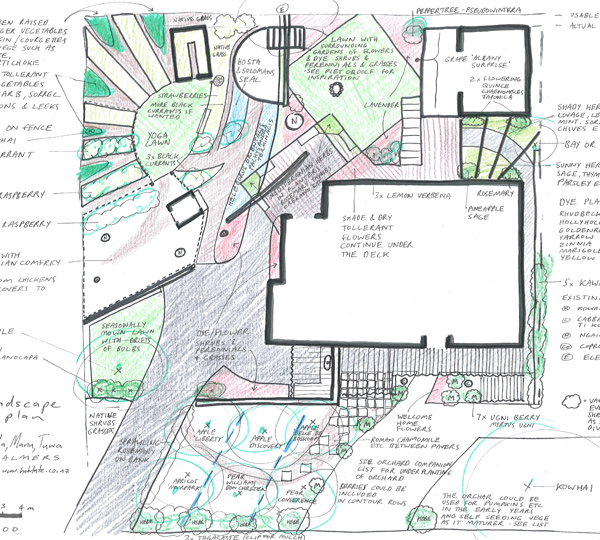
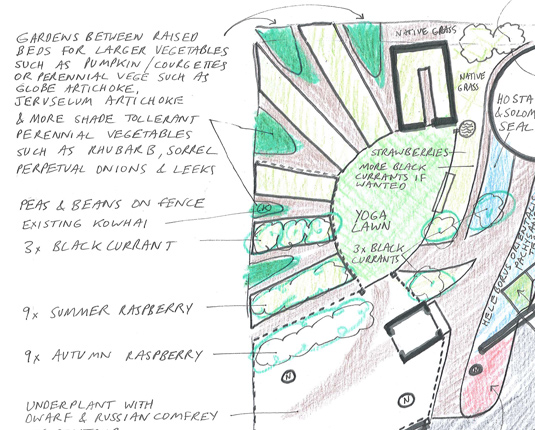
The final layout integrated and clustered features using permaculture design principles for low maintenance and maximum diversity and yield. The vegetable garden, glass house and chickens, for example, are clustered around the yoga lawn in a funky sun ray pattern.
Three hand drawn concept+ designs resulted: A planting Plan, Hard Landscape Layout and a colour area theme sketch.
Tuesday, June 3rd, 2014
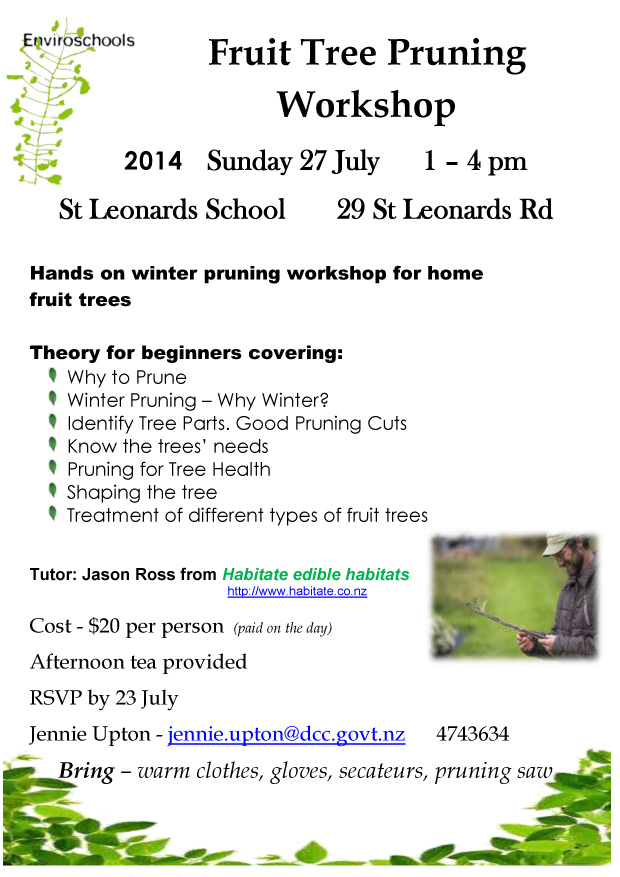
Thursday, April 24th, 2014
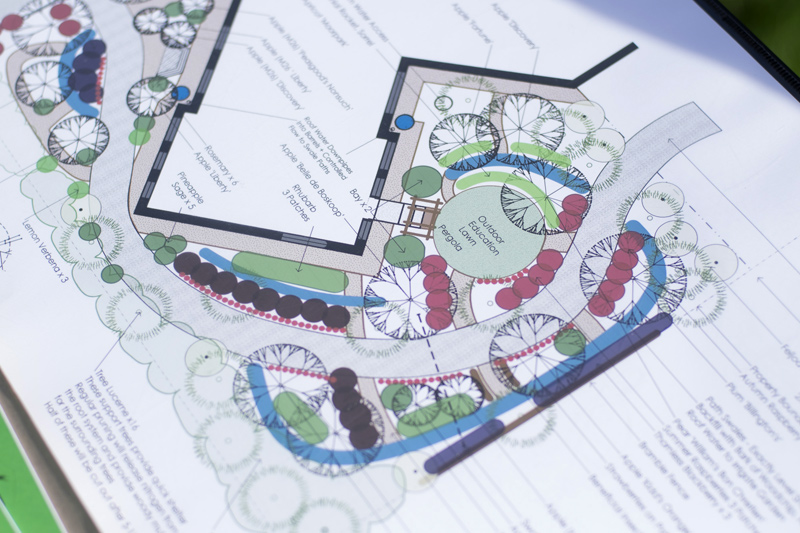 A community food forest is sprouting in South Dunedin. In December 2014 Peta Hudson and Jason Ross tutored a Food Forest Design workshop at the school site. Local participants contributed their ideas in the form of designs for the food forest after learning about the possibilities for the area.
A community food forest is sprouting in South Dunedin. In December 2014 Peta Hudson and Jason Ross tutored a Food Forest Design workshop at the school site. Local participants contributed their ideas in the form of designs for the food forest after learning about the possibilities for the area.
I took these ideas and brought them together into a layout and planting strategy design for the food forest. Planting is planned for winter 2014.
The Bathgate Park Community Garden and Food Forest Project has been driven by Grow South, well done team!
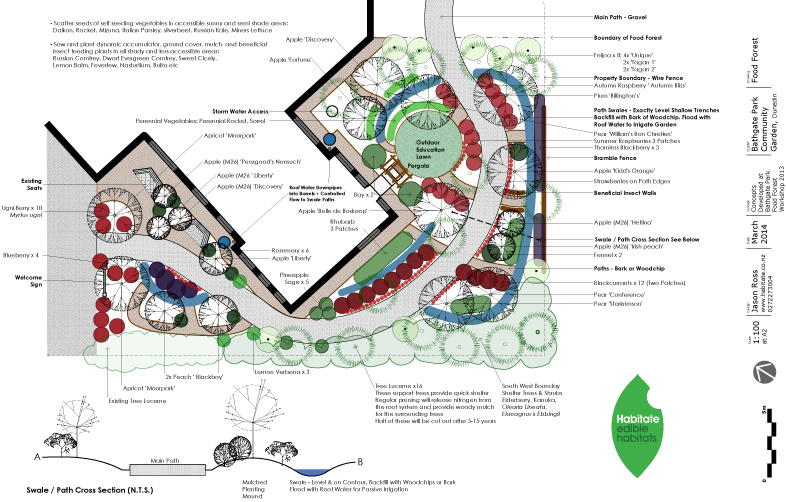
Thursday, April 24th, 2014
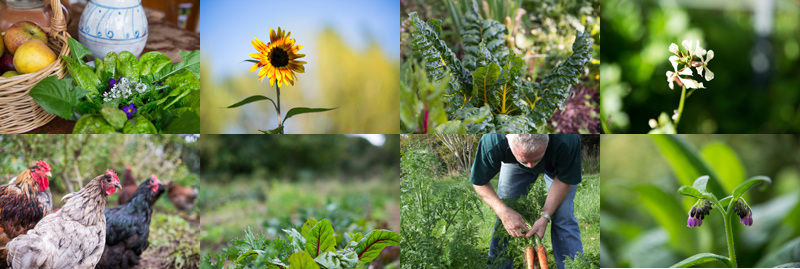 Taste Nature Gardens & Habitate Nursery collaborate on the development of this exciting Permaculture landscape in Waitati, Otago. Owned by the visionaries Mark & Rayna Dickson, this land is both the home of our Habitate Heritage Fruits Nursery and is also their diverse, integrated and intensive small scale market garden that supplies their Organic Shop, Taste Nature, in High Street, Dunedin.
Taste Nature Gardens & Habitate Nursery collaborate on the development of this exciting Permaculture landscape in Waitati, Otago. Owned by the visionaries Mark & Rayna Dickson, this land is both the home of our Habitate Heritage Fruits Nursery and is also their diverse, integrated and intensive small scale market garden that supplies their Organic Shop, Taste Nature, in High Street, Dunedin.
It is an exciting project where passionate people come together to grow high quality nursery plants, organic vegetables, herbs and fruits. It is a team effort, where innovative growing systems are being constantly discussed and improved.
We grow organically and utilise permaculture design for layout and systems design. Biodynamics is used for soil health. Chickens play a major role, being rotated through the gardens using electronet fencing, to clear and fertilise garden beds.
We have our main nursery products (Berries and berry plants, pip fruit and pip fruit trees) certified as organically grown by Oganic Farm NZ – Producer Number OFNZ – 1035
We hold an Open Day mid March each year, which is advertised on our Articles Page and at Taste Nature. Give us a bell if you would like to be on our mailing list for this.
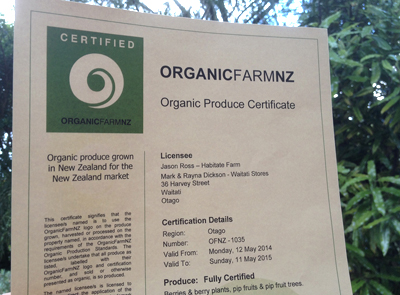
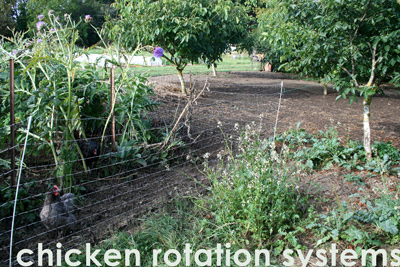
Thursday, April 24th, 2014
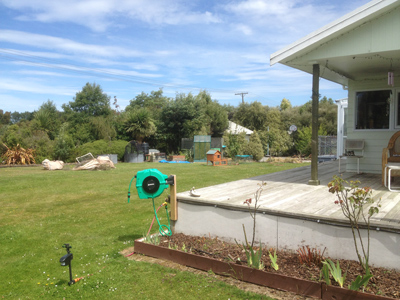
Before (Autumn 2014)
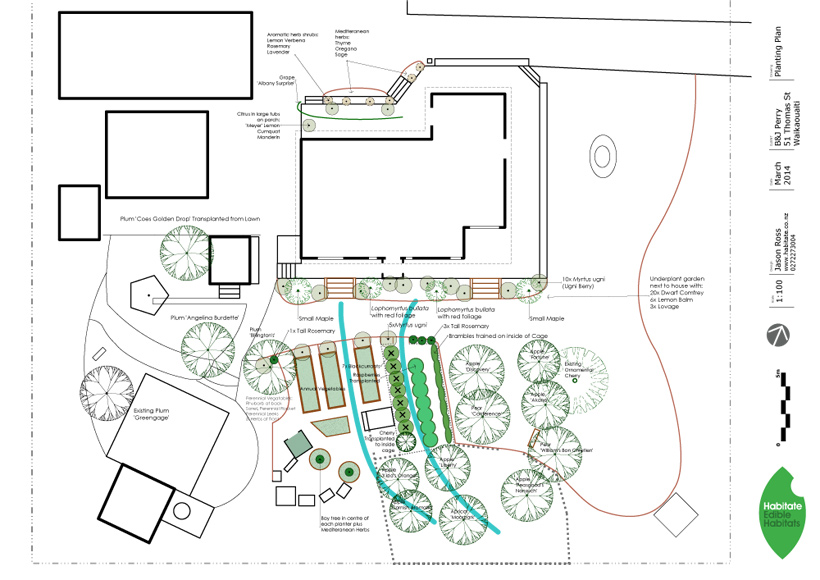 To keep the maintenance low and the soil fertility up for this couple in Waikauaiti, chickens are playing a key role in our garden design. They have a deep litter scratching yard where they will process weeds etc into compost for the garden. During the summer they will graze in the orchard and in the winter, with the change of a couple of small doors, they will run under the berry fruit bushes in the berry cage. This integrated design has many benefits. The chickens get fresh ground, weeds and bugs to eat, and they help with maintenance by scratching and grazing.
To keep the maintenance low and the soil fertility up for this couple in Waikauaiti, chickens are playing a key role in our garden design. They have a deep litter scratching yard where they will process weeds etc into compost for the garden. During the summer they will graze in the orchard and in the winter, with the change of a couple of small doors, they will run under the berry fruit bushes in the berry cage. This integrated design has many benefits. The chickens get fresh ground, weeds and bugs to eat, and they help with maintenance by scratching and grazing.
In winter 2014 we supplied the fruit trees from our Heritage Fruits Nursery and completed the planting of them, right down to the companion plants.
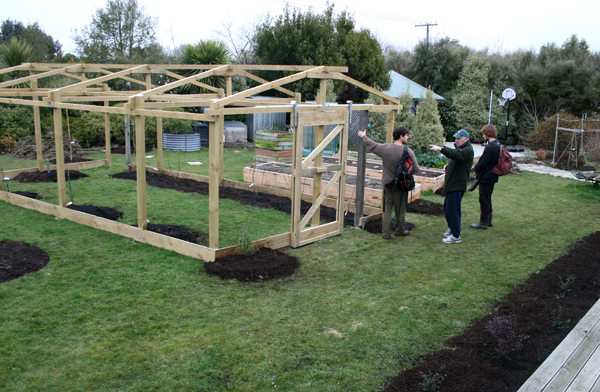
John (pointing, the garden owner), describing to our planting team the constructed of the the raised beds and berry cage that he completed himself in the autumn months
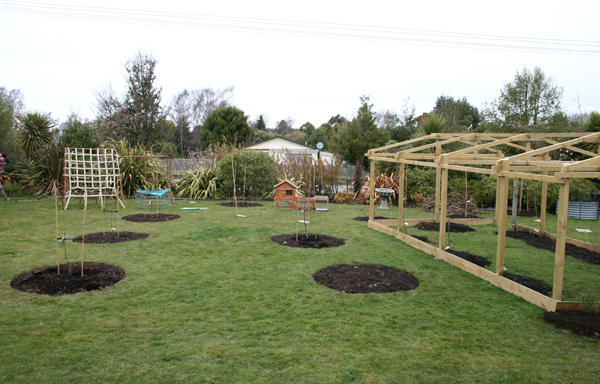
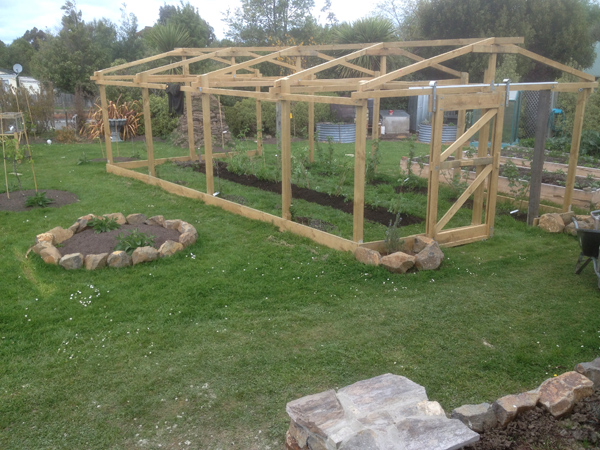
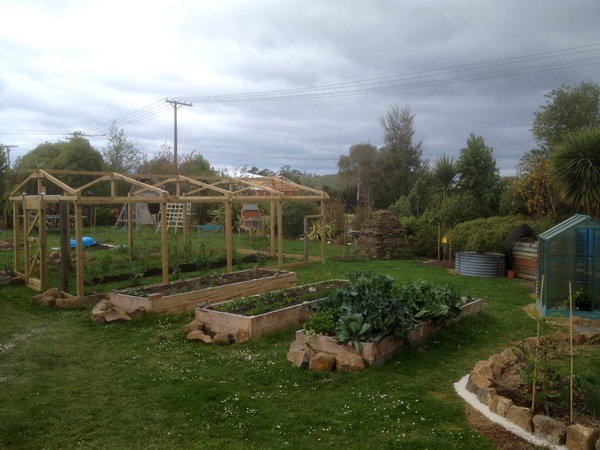
Thursday, April 24th, 2014
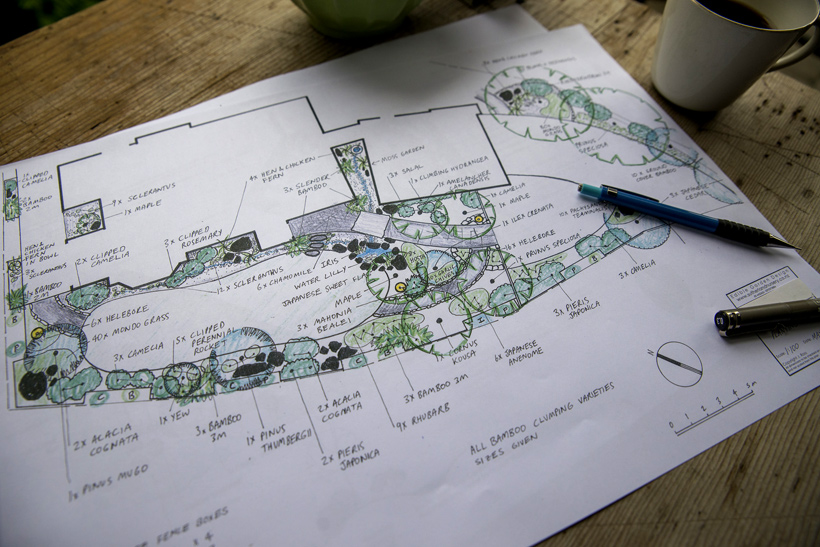
This full garden design was created for a lovely family who are passionate about not only growing fresh fruit and vegetables but also about Japanese garden style. The solution was a front garden entry through a Japanese garden inspired woodland, dry riverbed and pond, and a back section garden of herbs and raised garden beds near the house and deck and a chicken run and orchard on a steep slope below. A Japanese theme was kept throughout with edible Japanese plants and other edible plants that suited the theme being integrated with the ornamental gardens.
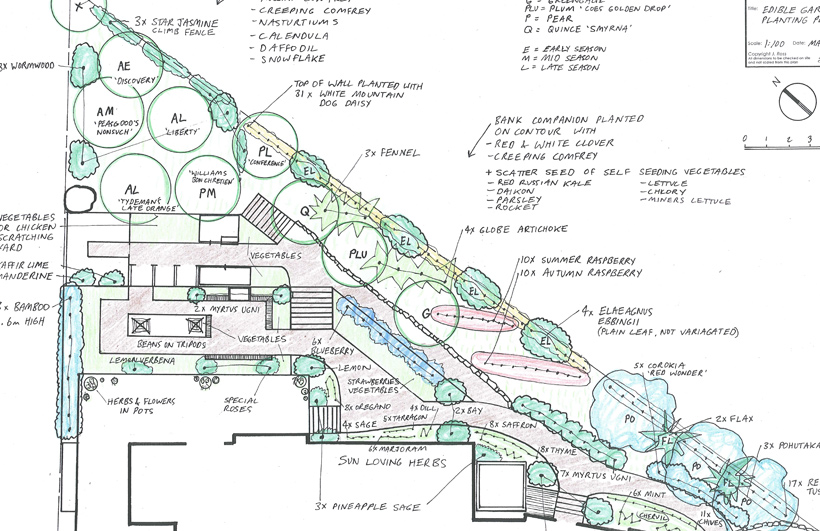
Wednesday, March 12th, 2014
Monday, November 11th, 2013
Food forest workshop December 2013 at the Bathgate Park Community Gardens, South Dunedin.
It will be an inspiring and practical workshop, you will learn about local food forests and practice food forest design on the site of the future community food forest.
Future workshops or working bees will cover planting and soil management strategies.
Peta Hudson and I are facilitating and it is being run by the great people Grow South who have got this community garden off the ground http://growsouth.org
I hope to see you there! contact info@growsouth.org to register
Monday, November 4th, 2013
Here at Habitate we are passionate about Food Forests. I have been fascinated by the concept and have been enjoying the benefits of Food Forests in practice for over ten years. Most of our edible garden designs if not including a food forest involve thinking like a forest in order to create productive solutions for small or challenging spaces. We use vertical layering and succession design to ensure seasonal cropping and short term and long term crops through the years leading to long lasting productive perennial gardens.
I recently attended the first New Zealand Hui on Food Forests, it was great to meet so many other people working on creating food forests around the country. It was brought together by James Samuel of www.foodforest.co.nz
Peta Hudson and I ran a workshop to design the Food Forest for the Bathgate Park Community Gardens in South Dunedin, and I have now drawn up a design for it. Planting winter 2014!
I have just created the posters below to illustrate the benefits of a food forest, and answer the questions: What is a food forest and what might one look like in the Coastal Otago or Southland bioregion?
Sunday, July 14th, 2013
Wednesday, July 10th, 2013
A talk by Jason Ross at the July Permaculture Dunedin Meeting – All Welcome
Permaculture Dunedin holds monthy meetings with stimulating and inspiring talks on all things Permaculture.
17th July 2013
Meeting starts at 5.30pm at THE APARTMENT upstairs from The Malcalm Trust, 174 Princes Street (enter “The Apartment” from Dowling Street).
Jason Ross – Owner / Operator of Sutherland Nursery and Edible Garden Design, based in Waitati. Works with Waitati Stores, growing vegetables, herbs and fruit for Taste Nature, Dunedin’s Organic Shop.
Forests and woodlands provide great inspiration in their diversity, resilience, self perpetuation and beauty. Can we use a forest model to inspire design for integrated edible and useful gardens and landscapes? I have been inspired by this question for the last ten years. In this talk I will outline some key aspects of temperate food forest design and thinking.
EVERYONE IS WELCOME TO UPCOMING MEETINGS:
17th July,
28th August,
25th Sept,
23rd Oct
Monday, July 8th, 2013
It was really nice to have Robert and Robyn Guyton over recently, they were quite taken with how my kids graze from our family’s edible garden. Robert said he might like to write something about the diversity of plants we enjoy in our little section, but I soon forgot his comments until folk started telling me he had written an article in New Zealand Gardener. Check out the July issue, Robert is a great writer and a great explorer of the wilder side of food gardening.
Sometimes at the dinner table I am playing the role of trying to get my kids to eat some salad when I remember, that actually, during the day, between tree climbing, making bug houses and trampolining, they have been tearing off brussel sprouts and chunks of cabbage from the garden beds and munching them happily raw.
I never thought that our edible garden would be such a big part of our kids outdoor play time, or that they would be self grazing from it! So I suggest to anyone going to have kids to integrate edibles into their backyard play space. Your kids will end up teaching you a few things about the joys of an edible garden. “Dad have some of this kale it so sweet!”
Thursday, June 20th, 2013
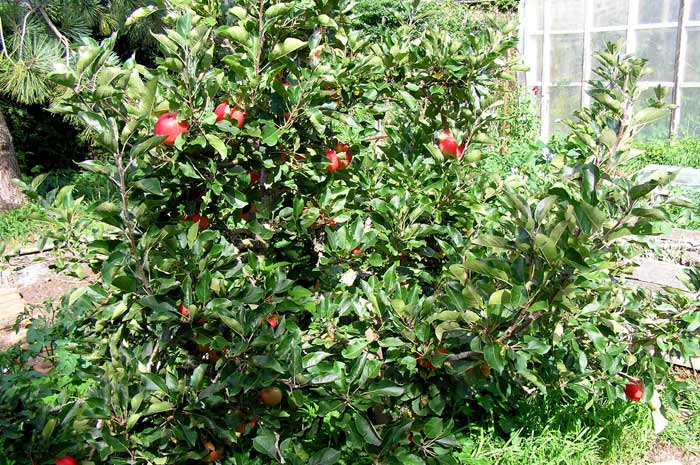 Semi-Dwarf Discovery Apple Tree. 1.8m high and 2.5m wide! With a good heavy crop.
Semi-Dwarf Discovery Apple Tree. 1.8m high and 2.5m wide! With a good heavy crop.
The primary reason that we like grafted fruit trees is that by grafting onto specially bred rootstock we can reduce the size of the tree when it is mature. The trees are then easier to manage, the fruit easier to reach and we can fit more variety of trees into a smaller space.
Specifically this winter I am promoting a great range of heritage apples that I have grafted onto the semi-dwarf rootstock called M26 (bred by the good people at the East Malling Research Station in England). This makes a fantastic multi-purpose size apple tree, it dwarfs the tree size to thirty to fifty percent of normal size, that is, around two to three meters high and wide. This is a little under M106 which dwarfs to sixty to seventy percent. It still has good vigor and robustness compared to a full dwarf apple on a rootstock such as M9 which dwarfs to a quarter of full size. It is also cold hardy so can also be used in inland gardens.
Another great feature of this rootstock is that it is as vigorous in its first few years as the more vigorous stocks, so establishes quickly, and it is precocious, that is, it starts fruiting at a young age. You can expect twenty to thirty fruit in the third year from planting.
Heritage apples grafted on M26 are a great choice for espalier, growing against a fence or wall or over a pergola or pathway arch. These make beautiful and productive dividers or backdrops for vegetable gardens or edible courtyards. All of these situations call for a tree to mature at around two to three meters high. M26 will quickly grow to fill the space and enjoy the support of the structure for the early heavy crops. As an espalier or against a fence two metres high expect the tree to cover two to three metres of wall, therefore plant them this distance apart. If you really want to pack in the varieties to ensure a great variety of tastes, uses and seasons of use, then plant an inclined cordon at one meter spacing.
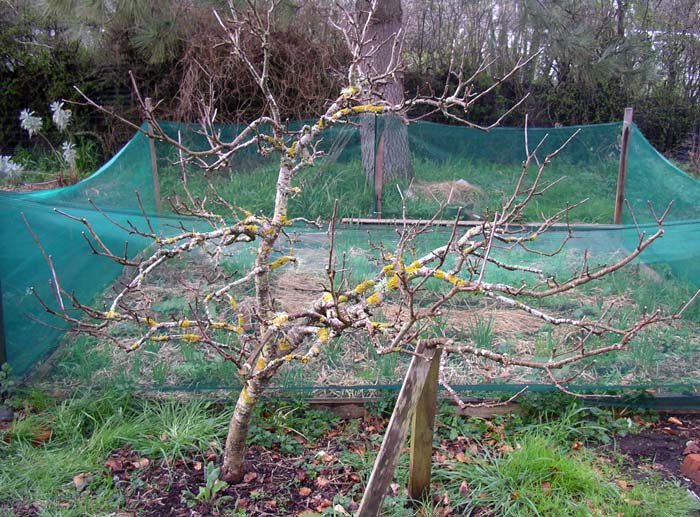 Winter Pruned Semi-Dwarf Discovery
Winter Pruned Semi-Dwarf Discovery
Apples on M26 are also used in permaculture food forest plantings as understory or edge trees. Food forests use the observed patterns of natural woodlands to inspire the design of productive gardens / orchards, thus utilising space effectively by stacking vertically layers of edible and useful plants. Apples on M26 can be used in either the low tree layer (use early varieties, cooking varieties and varieties suited to cool summers) or as part of the forest edge (use sun loving varieties). When growing M26 as a freestanding tree, always stake it to get it going and to take the weight of early crops and keep it staked if any winds are likely to catch it.
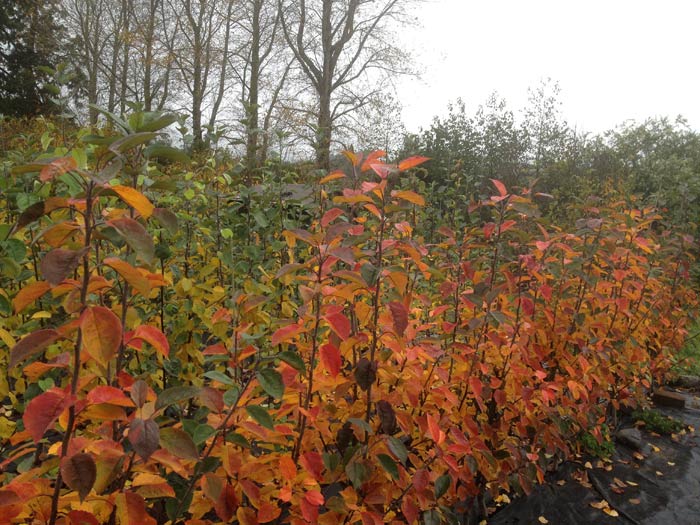 Two year old M26 apple trees from our nursery will be quick to crop in your garden.
Two year old M26 apple trees from our nursery will be quick to crop in your garden.
See our catalogue for a great range of heritage apples on M26 rootstock, some varieties also available as two year old M26.
If you are after a larger tree to eventually sit under, if you have heavy soils, or there is going to be competition for the tree then choose a more vigorous rootstock such as M106 or M793.
Monday, May 6th, 2013
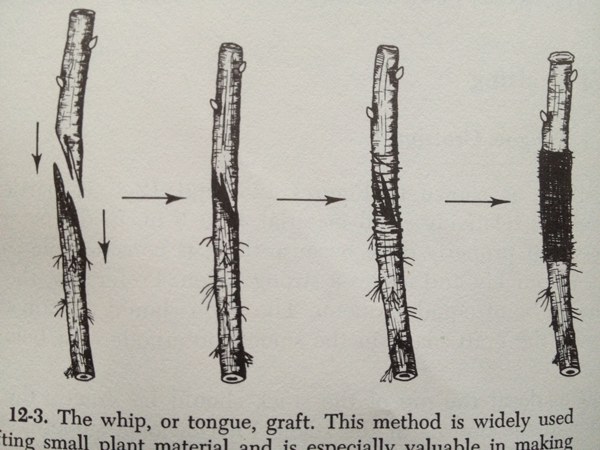 Fruit tree grafting workshop with Jason Ross, Sutherland Nursery
Fruit tree grafting workshop with Jason Ross, Sutherland Nursery
Would you like to learn how to graft a fruit tree (apple or pear) at a hands on workshop?
The workshop is planned for Sunday Sept 1st – 2013 – from 1-4pm.
Prior to the workshop, participants will receive instructions on how to take cuttings suitable for
grafting. The cuttings need to be taken at the beginning of July, when the trees are fully dormant.
If you don’t have a favourite fruit tree to take cuttings, we may be able to help. During the recent
community fruit harvest, we identified some trees with delicious fruit that appear to do very well in
our area, which we would like to graft.
The cost of the workshop is $30 to graft an apple or $40 for a pear. This covers the cost of rootstock,
potting mix, demonstration and tuition from Jason, and venue hire. If you’d really like to come, but
the cost is a barrier, let me know and we will try to sort out something. Venue will be confirmed
once we know we have viable numbers.
Please register by 10 June, supplying the information below to Kristen Bracey (North East Valley Transition Towns 473).
Her contact details are:
473 9535 or 027 779 5481
Payment is required in
advance. Places are limited so register as soon as possible.
Name:
Email:
phone:
Will you bring own cutting (therefore which rootstock do you require)?
Yes Type:
No
Type of cutting you would like supplied: (apple or pear)
Would you like to graft more than one tree? Extra rootstock are $10 per extra apple rootstock (please choose dwarf or standard size) and $20 per pear rootstock. Please include this in your registration payment as we need to order the rootstock.
Wednesday, April 3rd, 2013
Friday, November 16th, 2012
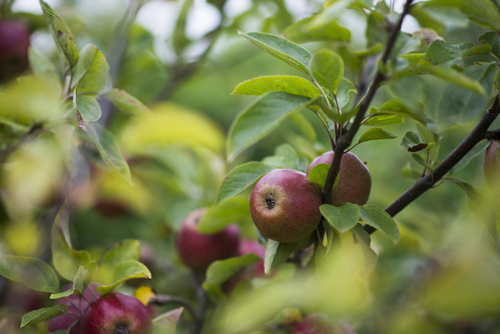 We have just thinned the very good fruit set of apples from the nursery cordon, otherwise it would have been very overloaded. This 7 year old espalier of 38 varieties of apples is where we get our cuttings (scion wood) from.
We have just thinned the very good fruit set of apples from the nursery cordon, otherwise it would have been very overloaded. This 7 year old espalier of 38 varieties of apples is where we get our cuttings (scion wood) from.
Early Summer Tasks in the Orchard
It is a beautiful time of year out in the orchard. We enjoyed some good conversation and garden tip sharing recently when we were out working in the Waitati Open Orchards. Here are a few tips for timely activities for early summer in the orchard.
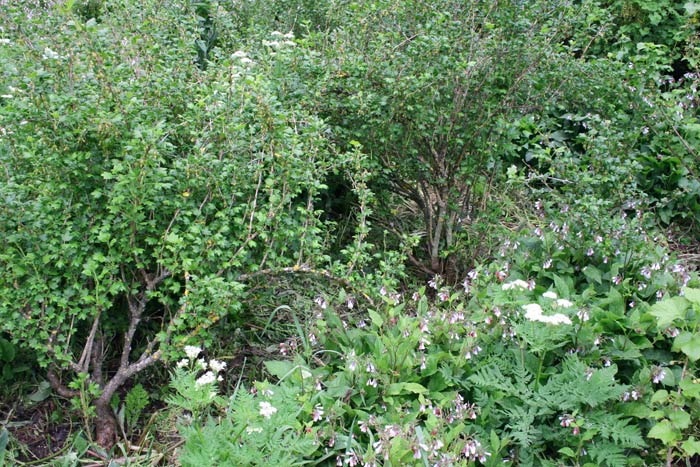 Old gooseberries with companion plants chopped and dropped beneath them to feed the soil.
Old gooseberries with companion plants chopped and dropped beneath them to feed the soil.
Monday, November 12th, 2012
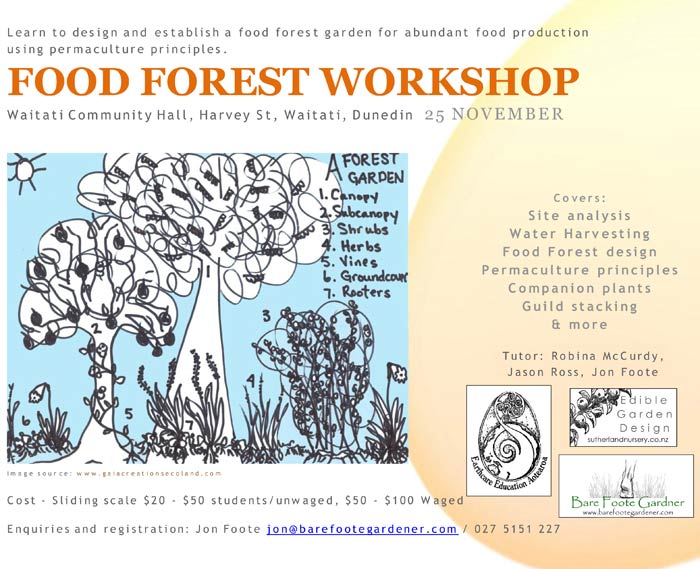 Would you like to learn about growing a whole woodland type ecosystem entirely with edible and useful plants? Come along to find out how to grow a diversity of crops together, supporting each other making for a low maintenance food system and an adventure into growing closely with nature.
Would you like to learn about growing a whole woodland type ecosystem entirely with edible and useful plants? Come along to find out how to grow a diversity of crops together, supporting each other making for a low maintenance food system and an adventure into growing closely with nature.
I will be co-tutoring and bringing local info on what species and guilds work here in coastal Otago.
Monday, November 5th, 2012
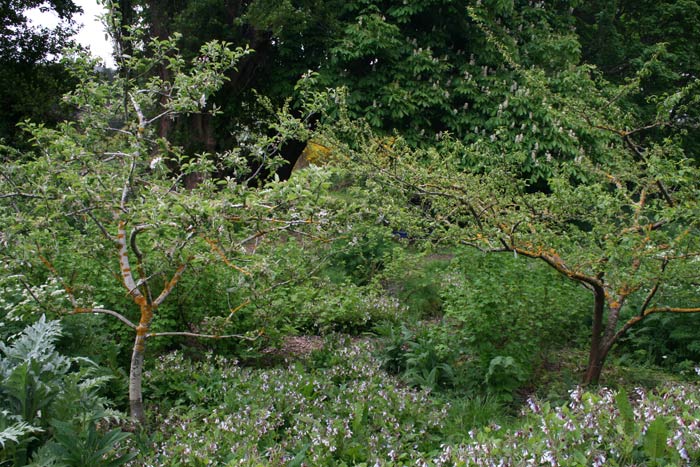 I just adore this time of year in the edible garden. I especially enjoy the food forest (edible forest garden) parts of the garden where all the work of weeding, mulching, transplanting and pruning was done in the winter and now is just a time for observing the fresh new growth, flowering and insects doing their pollination (and parisitising!).
I just adore this time of year in the edible garden. I especially enjoy the food forest (edible forest garden) parts of the garden where all the work of weeding, mulching, transplanting and pruning was done in the winter and now is just a time for observing the fresh new growth, flowering and insects doing their pollination (and parisitising!).
This picture is taken in Waitati at a garden where I work. In it are apple and plum trees, redcurrants, perennial vegetables/ herbs / multifunctional dynamic accumulators: sorrel, lovage, globe artichoke, lemon balm, sweet cicily, russian and evergreen comfrey.
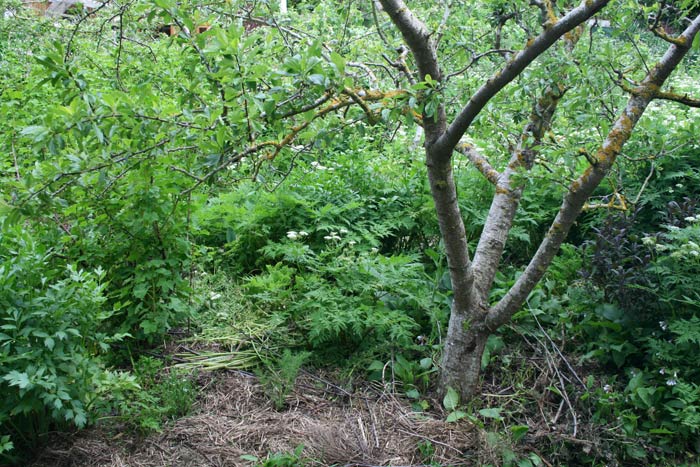 I am extra excited to be thinking about food forests as I am co-tutoring a workshop on them later in the month, with Robina McCurdy and Jon Foote as part of the LOCALISING FOOD TOUR, look out for an upcoming post with detals.
I am extra excited to be thinking about food forests as I am co-tutoring a workshop on them later in the month, with Robina McCurdy and Jon Foote as part of the LOCALISING FOOD TOUR, look out for an upcoming post with detals.
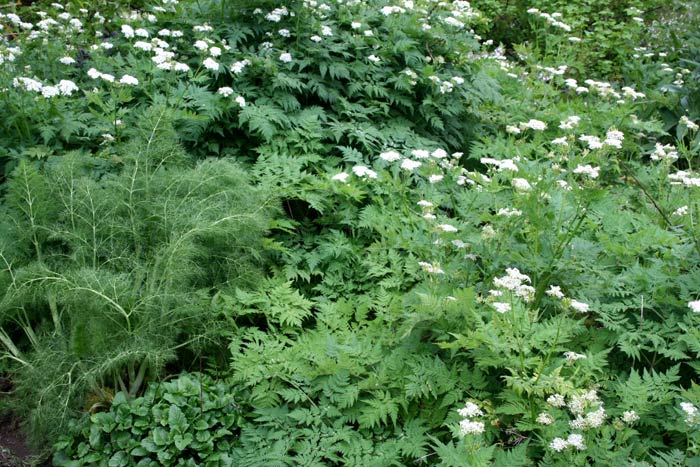 Fennel, sweet cicely and lemon balm. These are planted under fruit trees for a range of benefits. For the trees they provide a ground cover, excluding weeds and mining up minerals from deep in the soil they deposit them on the soil surface for the fruit trees to feed on. For us they provide herbal tea, salad crops, rhubarb sweetening and delicious seeds.
Fennel, sweet cicely and lemon balm. These are planted under fruit trees for a range of benefits. For the trees they provide a ground cover, excluding weeds and mining up minerals from deep in the soil they deposit them on the soil surface for the fruit trees to feed on. For us they provide herbal tea, salad crops, rhubarb sweetening and delicious seeds.
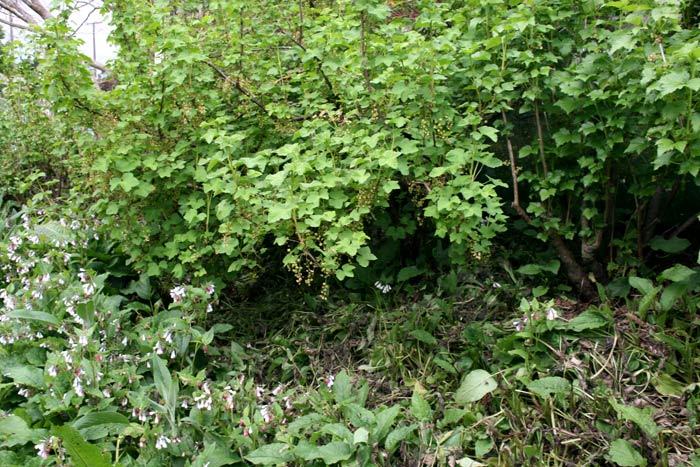 Here Russian and evergreen comfrey growing under berry fruits has been slashed and dropped to feed the soil. This really enjoyable job is done two or three times during the summer.
Here Russian and evergreen comfrey growing under berry fruits has been slashed and dropped to feed the soil. This really enjoyable job is done two or three times during the summer.
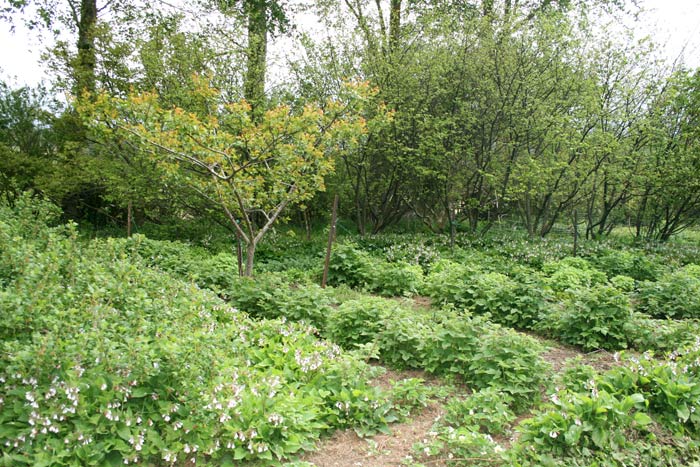 Gooseberries with comfrey underneath, autumn raspberry rows, an apricot and hazel nuts behind, in a well sheltered sun trap.
Gooseberries with comfrey underneath, autumn raspberry rows, an apricot and hazel nuts behind, in a well sheltered sun trap.
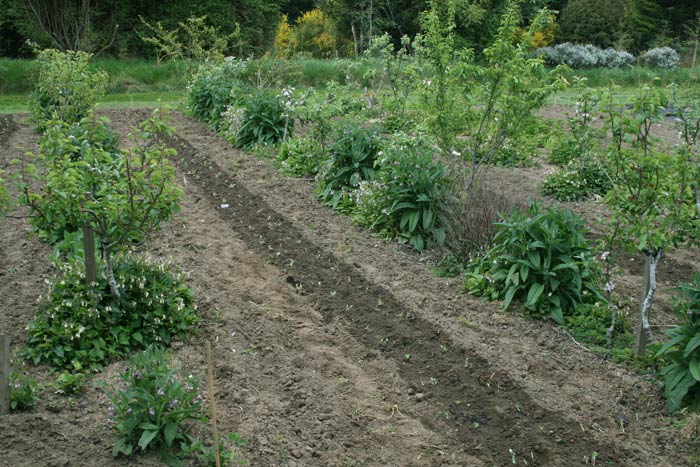 Fruit trees we planted very closely in rows with companion plants, in order to trial many varieties in a small space. Sunflowers are planted as a cash crop in between the rows while the trees are small.
Fruit trees we planted very closely in rows with companion plants, in order to trial many varieties in a small space. Sunflowers are planted as a cash crop in between the rows while the trees are small.
Friday, October 26th, 2012
Tuesday, April 24th, 2012
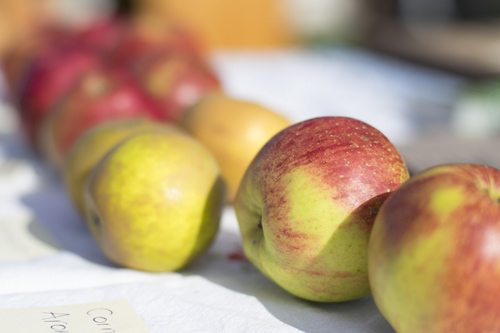
Science is slowly catching up with what we can taste and feel: “Older varieties of fruit and veg may be considerably healthier than their modern supermarket equivalents, researchers claim”.
One of our all time favourite apples, Egremont Russet is mentioned in the following article a friend just sent me:
http://www.nzherald.co.nz/
Pictured are apples on our display at the Waitati A&P Show.